
Category of Astronomical Heritage: tangible immovable
Hamburg Observatory Millerntor, Germany

Format: IAU - Outstanding Astronomical Heritage
Description
Geographical position - InfoTheme: Astronomy from the Renaissance to the mid-twentieth century
Entity: 136
Subentity: 1
Version: 3
Status: PUB
Date: 2021-03-08 17:23:19
Author(s): Gudrun Wolfschmidt
Millerntor Observatory, Holstenwall, Hamburg, German Empire
Location - InfoTheme: Astronomy from the Renaissance to the mid-twentieth century
Entity: 136
Subentity: 1
Version: 3
Status: PUB
Date: 2021-03-08 17:24:09
Author(s): Gudrun Wolfschmidt
Latitude 53°33’03’’N, Longitude 09°58’24’’E, Elevation 22mm above mean sea level.
IAU observatory code - InfoTheme: Astronomy from the Renaissance to the mid-twentieth century
Entity: 136
Subentity: 1
Version: 1
Status: PUB
Date: 2018-08-17 08:37:25
Author(s): Gudrun Wolfschmidt
516
Description of (scientific/cultural/natural) heritage - InfoTheme: Astronomy from the Renaissance to the mid-twentieth century
Entity: 136
Subentity: 1
Version: 3
Status: PUB
Date: 2021-03-08 17:34:02
Author(s): Gudrun Wolfschmidt

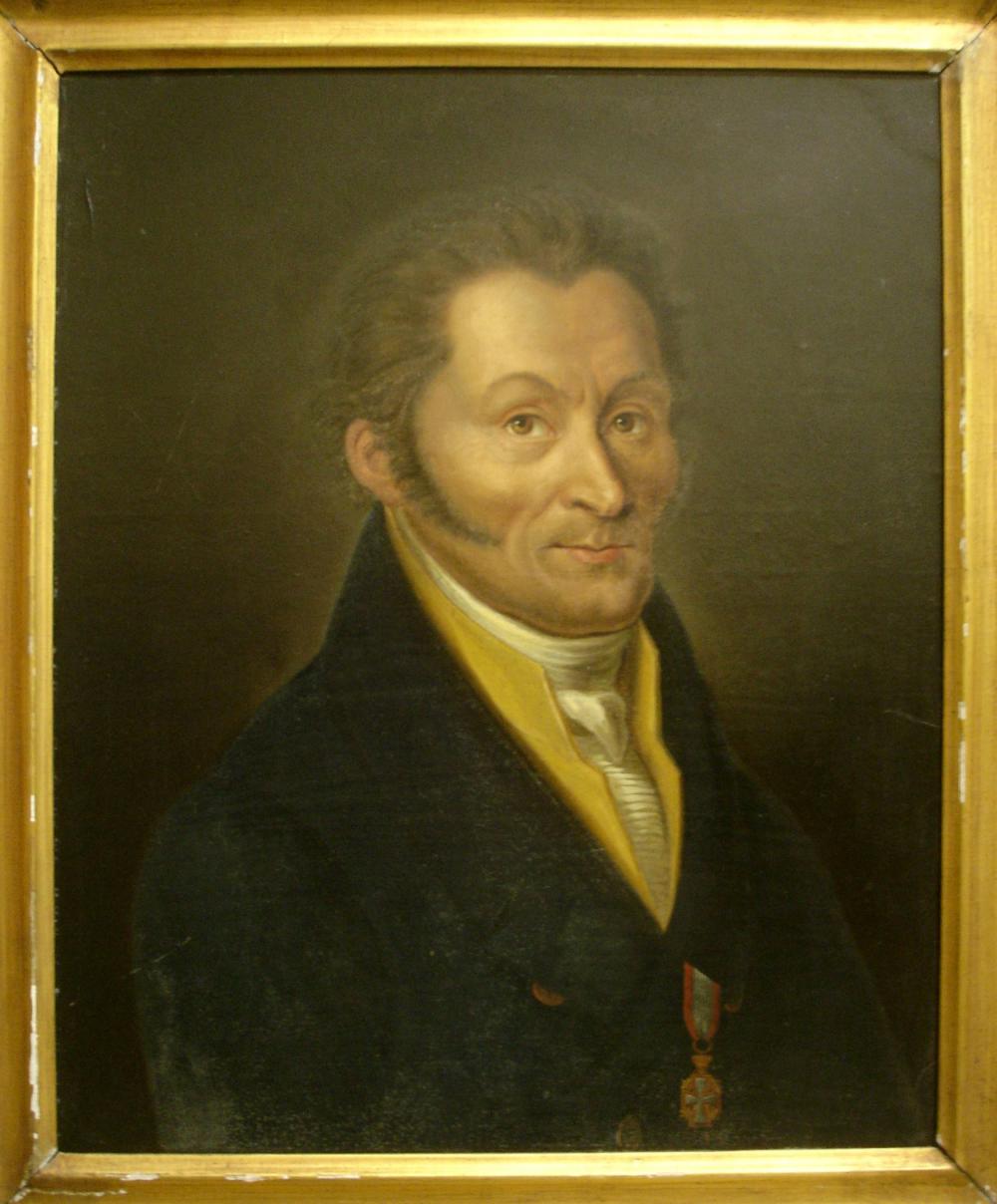
Fig. 1. Johann Georg Repsold (1770-1830), Collections of the Center for History of Science & Technology (Photo: Gudrun Wolfschmidt)
Johann Georg Repsold (1770-1830), educated as water engineer in Cuxhaven, the seaport of Hamburg, became head of the city fire brigade and had as mechanician a workshop. Repsold started Hamburg Observatory as a private observatory (with an early meridian circle), located first on the Stintfang (1802 to 1811), Bastion Albertus, a hill above the port of Hamburg, and then a second observatory at the Millerntor (1825 to 1906/12) on the Bastion Henricus of the Hamburg city wall (Koch 2001).
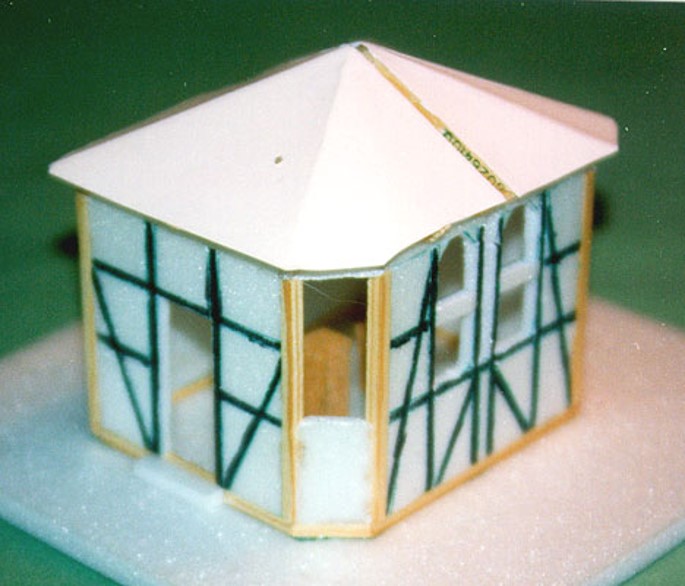
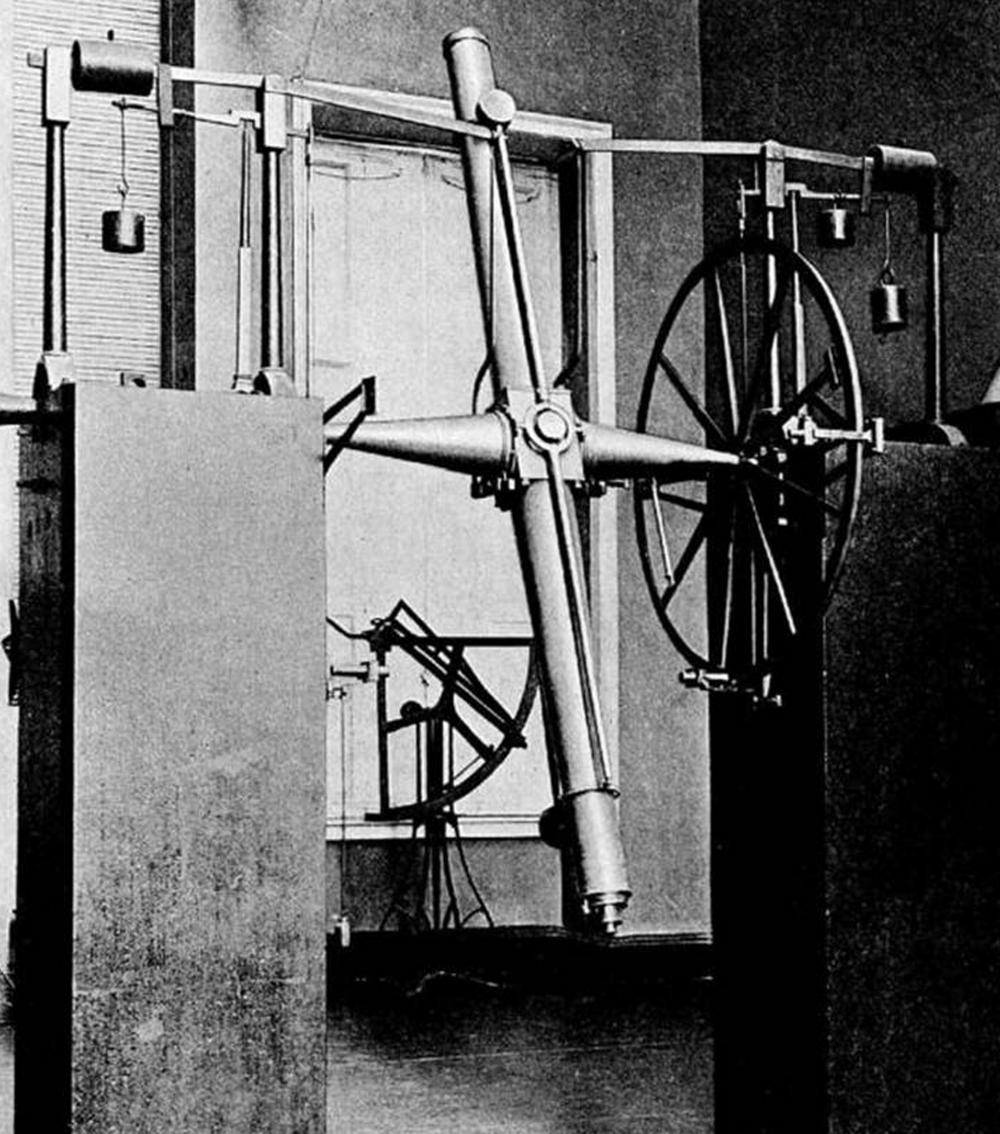
Fig. 2a,b. Repsold’s first private observatory on Stintfang (1802) and his meridian circle (1802) (Archive of Hamburg Observatory)
Because of the Napoleonic Occupation of Hamburg from 1811 to 1814, the Stintfang observatory had to be demolished. The building of the German "Seewarte" (Oceanographical Institute with (Maritime) Meteorology and checking of nautical instruments - magnetic compass and sextant - and chronometers), founded in 1875 by Georg von Neumayer (1826-1909), stood here from 1879 to 1945; today is Hamburg’s Youth Hostel there.
Millerntor Observatory and Navigation School
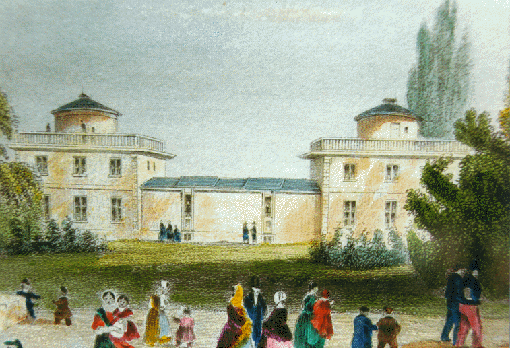

Fig. 3a,b. Repsold’s Millerntor Observatory with Navigation School (1825) (Archive of Hamburg Observatory, Berliner-Jahrbuch 1829)
Repsold’s Millerntor Observatory was a rectangular building, erected by the government-approved master builder Hinrich Anton Christian Koch (1758-1840) in 1825, had a two-domes-facade for the astronomical institute and for the navigation school, founded already in 1749. In 1872 the Navigation School was moved from the observatory to the Seaman’s House. The director of the Navigation School was Carl Theodor B. Niebour, 1857 to 1915. Then, in 1905, the Navigation School Hamburg got a new building (today Maritime Weather Office, Bernhard-Nocht-Strasse), built by Albert Erbe (1868-1922), who also erected the new Hamburg Observatory in Bergedorf.
The astronomical instruments were donated by a private foundation, the estate of amateur astronomer Johann Christopher Grell (fl. 1824). In 1833 the Millerntor Hamburg Observatory became a Hamburg state institute with the two directors Christian Karl Ludwig [Charles] Rümker (1788-1862) and George Rümker (1832-1900).
Johann Georg Repsold made also the instruments (Heliotrop and baseline - Braaker basis) for the triangulation of Denmark, Hamburg, and the Kingdom of Hanover; he cooperated with Heinrich Christian Schumacher (1780-1850), Danish Altona Observatory (Palmaille 9, 1821 to 1873, now part of Hamburg) and Carl is still visible in Altona: 0h30m25s East of Paris.
![Christian Karl Ludwig [Charles] Rümker (1788-1862](/images/astronomicalheritage.net/gallery/ahp_entities/entity000136/Ruemker-Charles-1.jpg)
![Christian Karl Ludwig [Charles] Rümker (1788-1862](/images/astronomicalheritage.net/gallery/ahp_entities/entity000136/Ruemker-George-2.jpg)
Fig. 4a,b. Christian Karl Ludwig [Charles] Rümker (1788-1862), director from 1833 to 1857, and his son George Rümker (1832-1900), director from 1857/67 to 1899 (Archive of Hamburg Observatory)
In 1819 Karl Rümker was professor at the navigation school in Hamburg, then from 1821 to 1830 in Paramatta Observatory (near Sydney), Australia, and from 1830 to 1857 Director of the Millerntor Observatory. His main activity was the Star Catalogue of 12,000 stars (1836-1855).
His wife Mary Hannah Rümker, née Crockford, (1809-1889), discovered a comet on October 11, 1847. But the comet was already discovered by Mary Mitchell (1818-1889) as early as October 1, 1847. After Mary Rümker had made an initial determination of the orbit, the Russian Countess N. Bobinski (fl. 1891) submitted another orbit calculation to the Petersburg Academy in 1891; independently of this, Margaretta [Marguerite] Palmer (1862-1924) was able to work at Yale redetermine the path using the methods that have since been improved, essentially confirming Madame Rümker’s calculations.
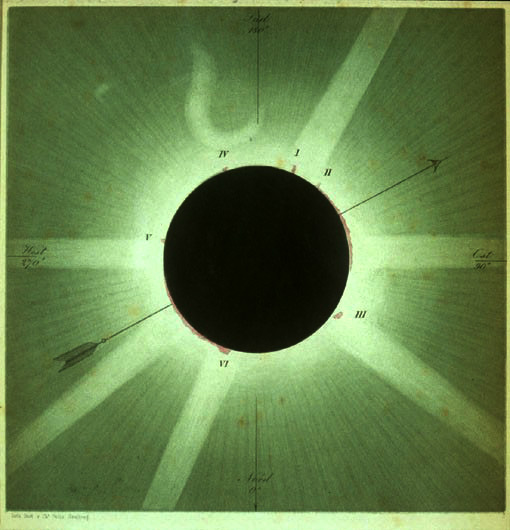
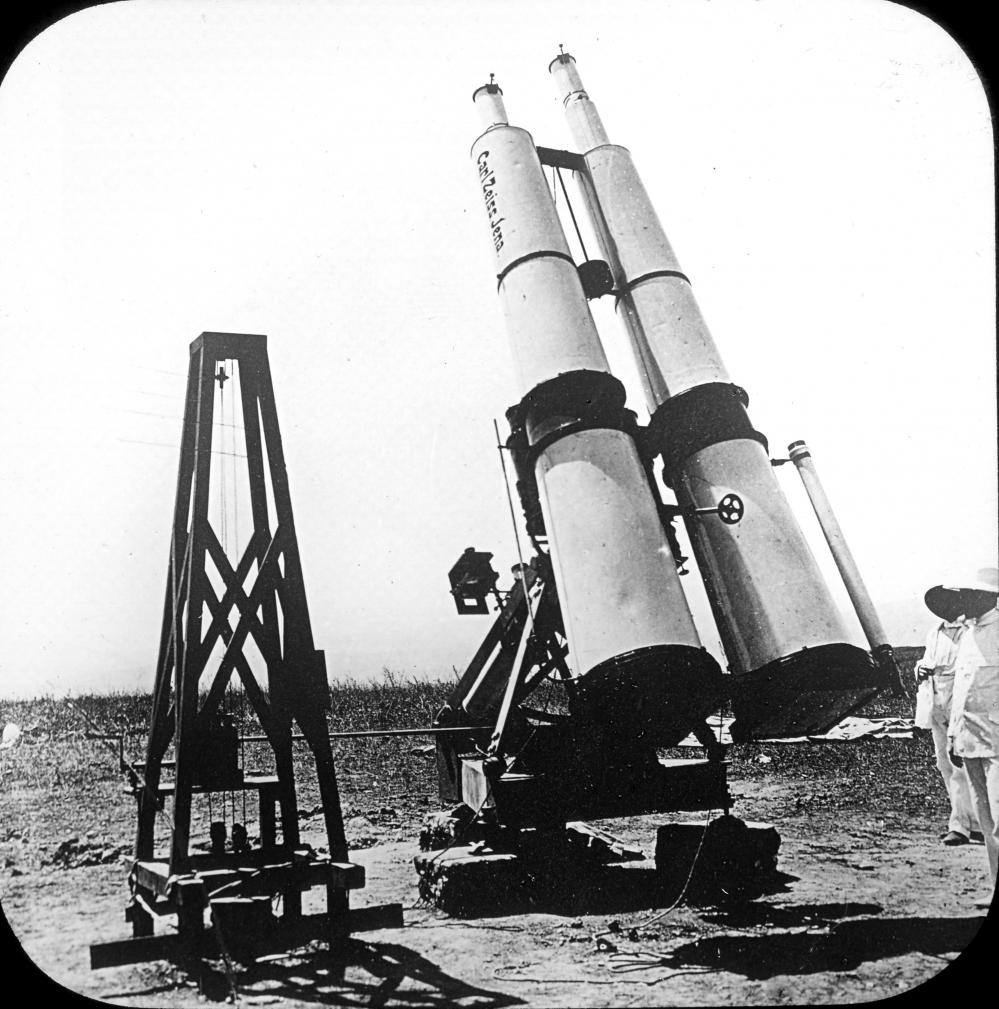
Fig. 5a,b. Solar eclipse expedition to La Plata, Spain (1860) and to Algeria (1905), Millerntor Observatory Hamburg (Archive of Hamburg Observatory)
Highlights of activities of Millerntor Observatory were the solar eclipses expedition to La Plata, Spain (1860), and to Algeria (1905).
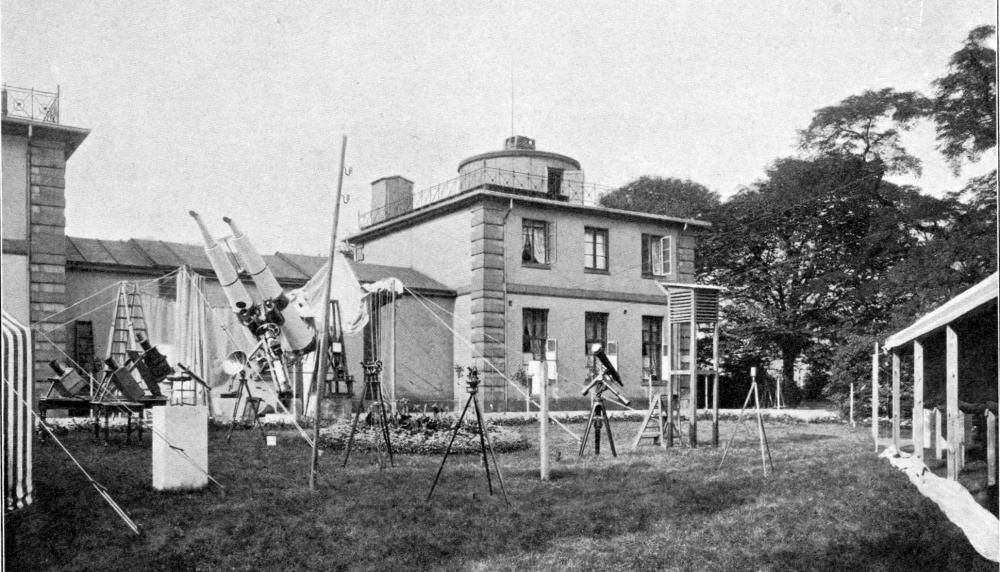
Fig. 6. Preparing the instruments for the solar eclipse expedition (1905) in front of Millerntor Observatory (Archive of Hamburg Observatory)
George Rümker, 1853-1854 in Durham Observatory in England, became the next long acting director of Millerntor Observatory from 1857/67 to 1900. He was very active in timekeeping and navigation; he was chairman of the examination board for mates (coxwains) and masters (captains).
George Rümker acquired a new "large" 26-cm-equatoreal refractor (3m focal length), Adolf Repsold & Sons of Hamburg and G. & S. Merz of Munich (1867) and observed the positions of circumpolar nebulae and compiled a catalogue (Steinicke 2014).
Time keeping and Time ball
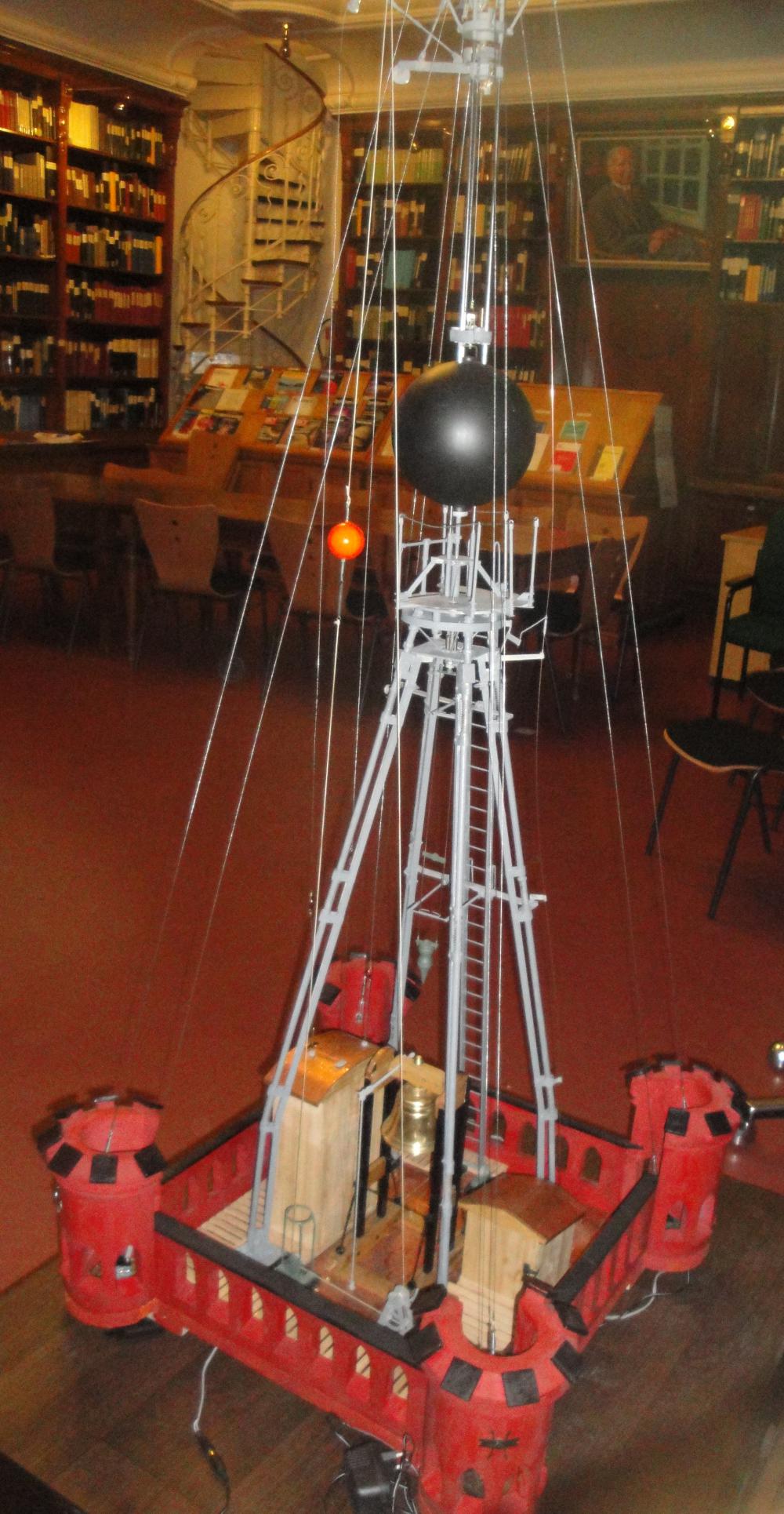
Fig. 7. Hamburg Time ball, model in the library (Photo: Gudrun Wolfschmidt)
The topics of research in Millerntor Observatory were positional astronomy, time service system, time keeping for navigation and for the city normal clocks, and teaching in the navigational school.
An important task of the observatory was the determination of the time with transit instruments. Then the signal was transferred to the time ball, made by Carl Bamberg of Berlin; the time ball was placed on the top of a warehouse (Kaispeicher A, today place of the Elbphilharmonie) in the river Elbe in the port of Hamburg (Machoczek 2014). The time ball, a 1.5-m black ball, fell punctually at 1 pm Hamburg time three meters down, controlled by astronomical precision pendulum clocks in the observatory, the signal transferred via an underground cable, with an electric telegraph.
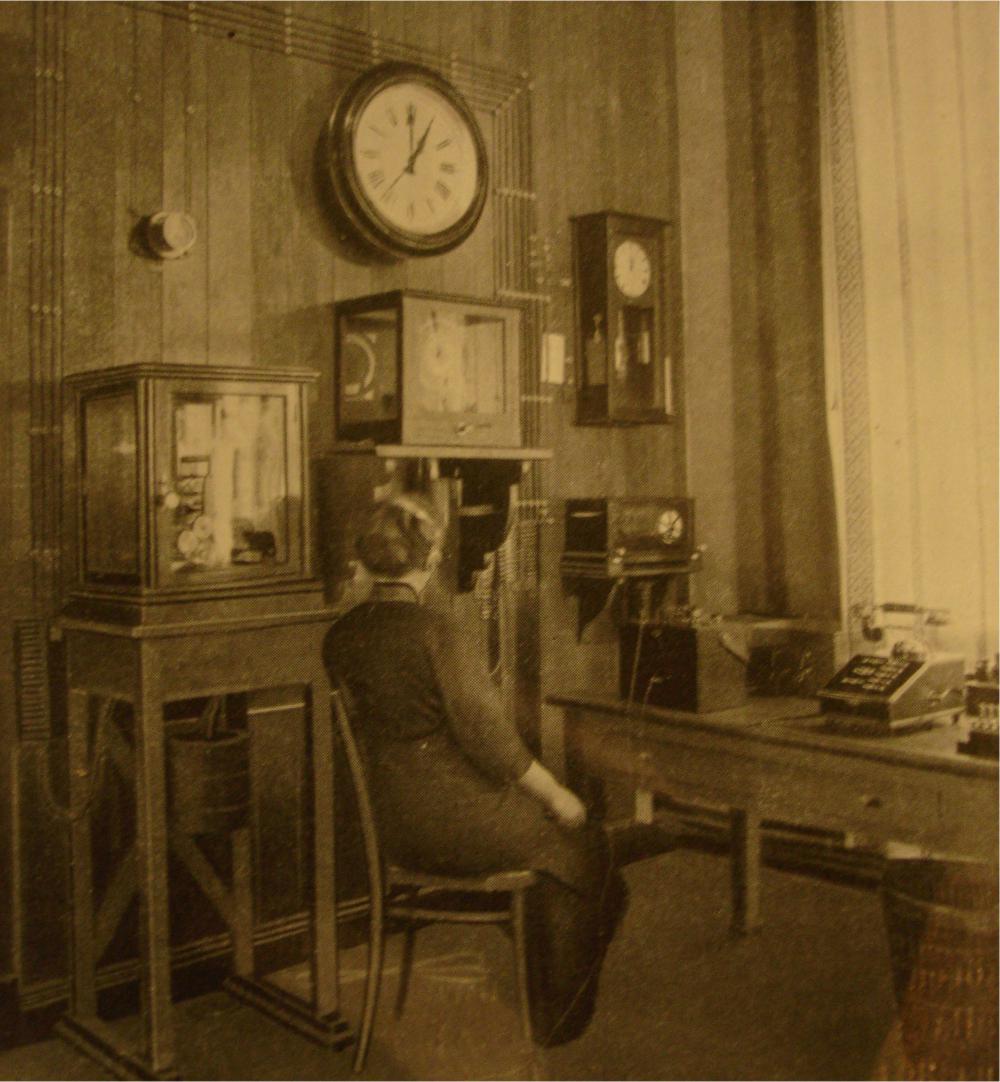
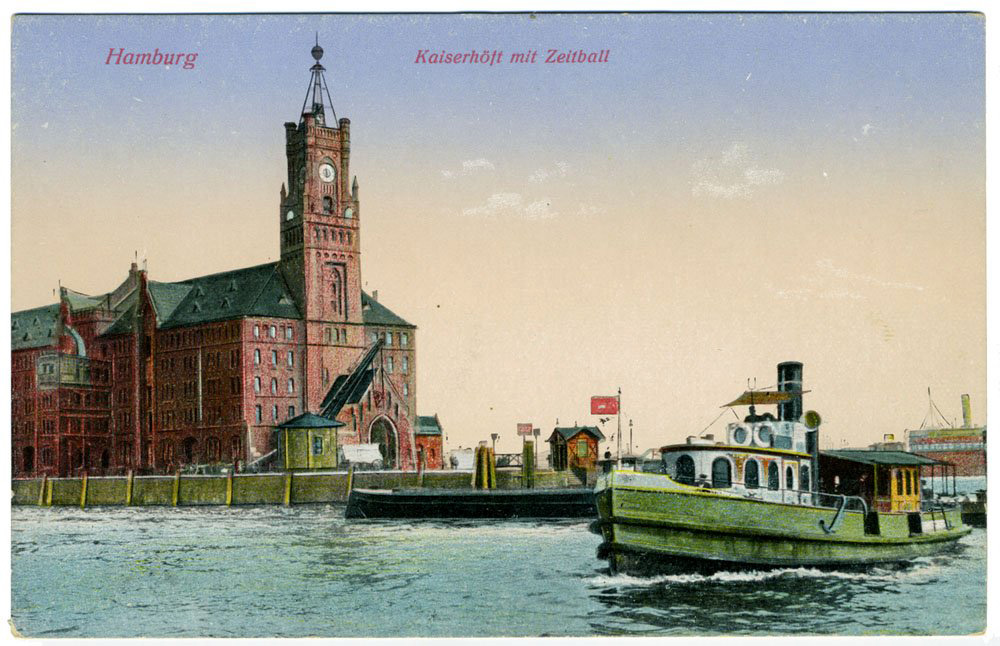
Fig. 8a,b. Time service system in Hamburg Observatory and Time ball on the warehouse in the river Elbe (Archive of Hamburg Observatory)
The Hamburg time ball was in service from 1874 to 1934, and the building existed until the 1960s. Time balls on the North Sea coast: Cuxhaven port (1875-1929), Wilhelmshaven Imperial Marine Observatory (1874), Bremerhaven (1894, 1876-1928), Bremen Port Authority (1895), Bremen port entrance (1905-1931).
Telegraphic time signals were sent from the Hamburg Observatory to Monrovia (Liberia), Horta (Azores), Vigo (Spain), Tenerife (Canary Islands), Pernambuco (Brazil) and Lome (Togo) - service until 1918. Since 1909, time was also available via telephone, since 1937 with a talking clock (horloge parlante) via broadcasting (radio receiver) for ecerybody.
As early as in 1912, the time signal "ONOGO" was done for the first time with wireless (radio) signals - one year before Paris Observatory, using the Eiffel Tower as an antenna (November 1913).
Towards the new Hamburg Observatory in Bergedorf
A great change occurred at the turn of the 19th and 20th centuries. Richard Schorr (1867-1951), director from 1902 to 1941, made an astonishing contribution - far-sightedness he set the course for a whole new era, for successful moving the observatory outside of the city center to Bergedorf at the Eastern border, because at the old location on the wall, the measurements were too much disrupted due to scattered light, smoke and vibrations from the harbor, industry, traffic and the city illumination.
History - InfoTheme: Astronomy from the Renaissance to the mid-twentieth century
Entity: 136
Subentity: 1
Version: 5
Status: PUB
Date: 2021-03-29 22:15:19
Author(s): Gudrun Wolfschmidt
Directors of the Observatory
- Johann Georg Repsold (1770--1830), from 1802 to 1830,
- Christian Karl Ludwig [Charles] Rümker (1788--1862), director from 1833 to 1857,
- George Rümker (1832--1900), director from 1857/67 to 1899,
- Richard Schorr (1867--1951), director from 1900 to 1941 - new observatory in Bergedorf, erected in 1906--1912.
Instruments
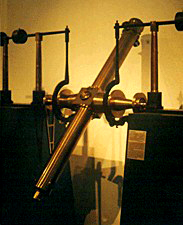
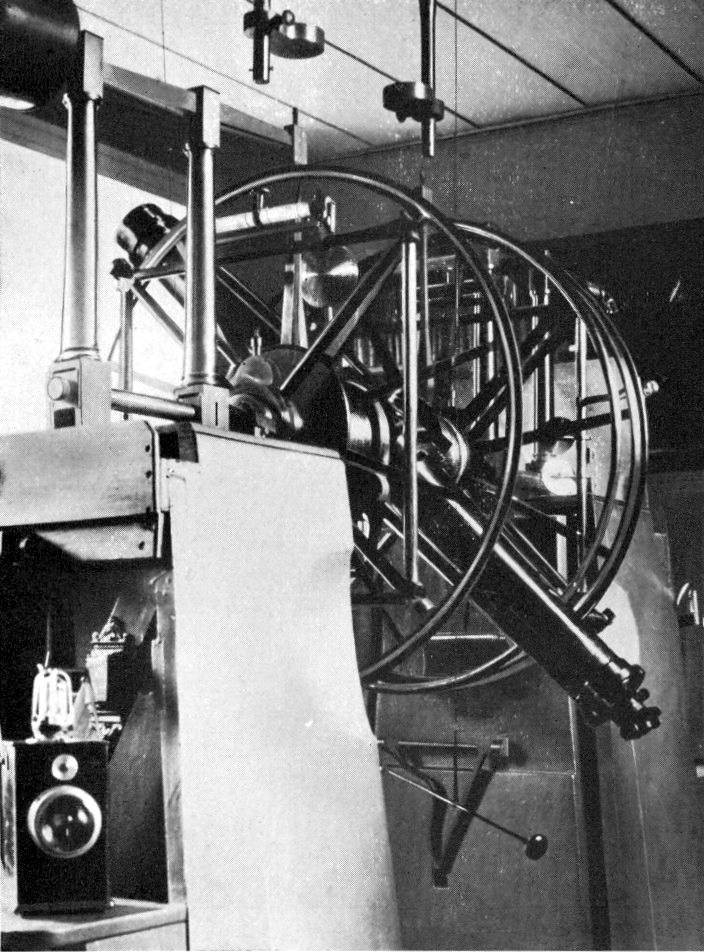
Fig. 9a,b. Transit instrument (1829) and Meridian circle, A. & G. Repsold of Hamburg (1836), in Millerntor Observatory in Hamburg (Photo: Gudrun Wolfschmidt in Kassel, Archive of Hamburg Observatory)
- 10-cm-Meridian circle (1802/03), since 1818 in Göttingen Observatory
- Universal instrument (1806)
- Transit instrument (1829), today in the Physikalisch-Astronomisches Kabinett Kassel
- 2 ft Dividing engine (Kreisteilmaschine) (1818) in a special pavilion
- Meridian circle, A. & G. Repsold of Hamburg (1836)
- Solar eclipse expedition instruments
- 26-cm-Equatoreal refractor (3m focal length), A. & G. Repsold of Hamburg and Merz of Munich (1867)
- Time keeping devices, Switchboard, Telegraph, ...
- Contact clockwork, J. & A. Unger, Straßburg/Strasbourg (1900)
- Telephone time signal.
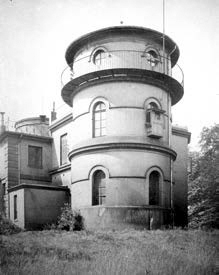
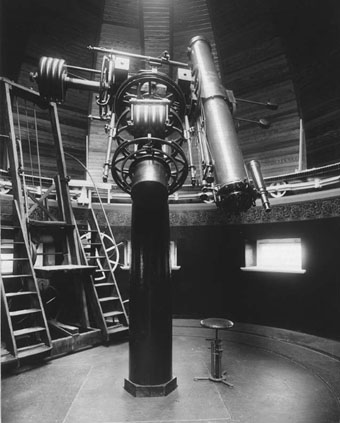
Fig. 10a,b. Tower and 26-cm-Equatoreal refractor (3m focal length), A. & G. Repsold of Hamburg and Merz of Munich (1867) in Millerntor Observatory in Hamburg (Archive of Hamburg Observatory)
Repsold firm in Hamburg
Johann Georg Repsold (1770-1830) was famous for his mechanical precision workshop for astronomical and geodetical instruments, founded in 1799 - the basis for the famous Repsold firm in Hamburg: A. & G. Repsold (since 1830) and A. Repsold & Söhne, 1867 to 1919. The workshop was first in the observatory, then in Herrengraben, since 1854 in the Böhmkenstrasse near the Michaelis church, later in the Borgfelder Mittelweg. The company delivered astronomical instruments (meridian circles, equatorial telescopes, heliometers, refractors, and geodetic instruments) to observatories all over the world; the optics was made in cooperation with the well-known Munich companies, Merz or Steinheil.
Adolf & Georg Repsold 1830-1867, Herrengraben,
1854-1871 in der Böhmkenstraße near Michaelis church
- Georg Repsold (1804-1867) - Son of Johann Georg Repsold
- Adolf Repsold (1806-1871) - Son of Johann Georg Repsold
The first larger instruments were made for:
- Bessel in the Königsberg observatory
- the Edinburgh observatory
- the Oxford heliometer (1845)
- for the Madrid observatory: the 6½ foot meridian circle (1854).
A. Repsold & Sons 1867-1919, 1854-1871 in Böhmkenstrasse near Michaelis,
1872-1919 workshop and house in Borgfelder Mittelweg near the Berliner Tor (today Klaus-Groth-Straße)
- Adolf Repsold (1806-1871)
- Repsold, Johann Georg (1832-1912) - Son of Georg Repsold
- Dr.phil.h.c. Repsold, Johann Adolph (1838-1919), known as Hans, - Son of Adolf Repsold
- Repsold, Oscar Philipp (1842-1919) - 3rd Son of Adolf Repsold
Publication of Repsold, Johann Adolph: Zur Geschichte
der astronomischen Meßwerkzeuge (1908, 1914).
Repsold’s Refractors after 1875:
- f=4.2m Nikolajew (ordered 1873)
- f=5.2m Potsdam (ordered in 1875)
- f=6.8m Straßburg/Strasbourg (ordered in 1876)
- f=6.8m Milan (ordered in 1876)
- f=6.8m Pulkowa/St. Petersburg (1876)
- f=14m, 80cm Pulkovo, St.Petersburg (1884)
- f=12m, 80cm Potsdam (delivered in 1898)
- f=9m, 60cm Hamburg (delivered in 1912)
Repsold’s Instruments - after 1870
- many meridian circles (for Hamburg 1909)
- many universal instruments
- Heliometer for the Venus Transit Expedition 1874 (5 foot heliometer for the ’German Venus Expedition’)
State of preservation - InfoTheme: Astronomy from the Renaissance to the mid-twentieth century
Entity: 136
Subentity: 1
Version: 10
Status: PUB
Date: 2021-03-29 22:51:18
Author(s): Gudrun Wolfschmidt
The Millerntor Observatory was demolished after 1912, when the new Hamburg Observatory in Bergedorf was ready. On the site, the Hamburg History Museum was built by Fritz Schumacher (1914 to 1922). But the monument for Johann Georg Repsold as founder of Hamburg Observatory and as head of the fire brigade, is still there in the original place.
The instruments, meridian circle, transit instrument, the solar eclipse expedition instruments, and the library were brought to the new Hamburg Observatory in Bergedorf (1912). Especially the equatorial refractor, including the dome, was moved to Bergedorf. There a new cylindrical building was erected and the dome reused.
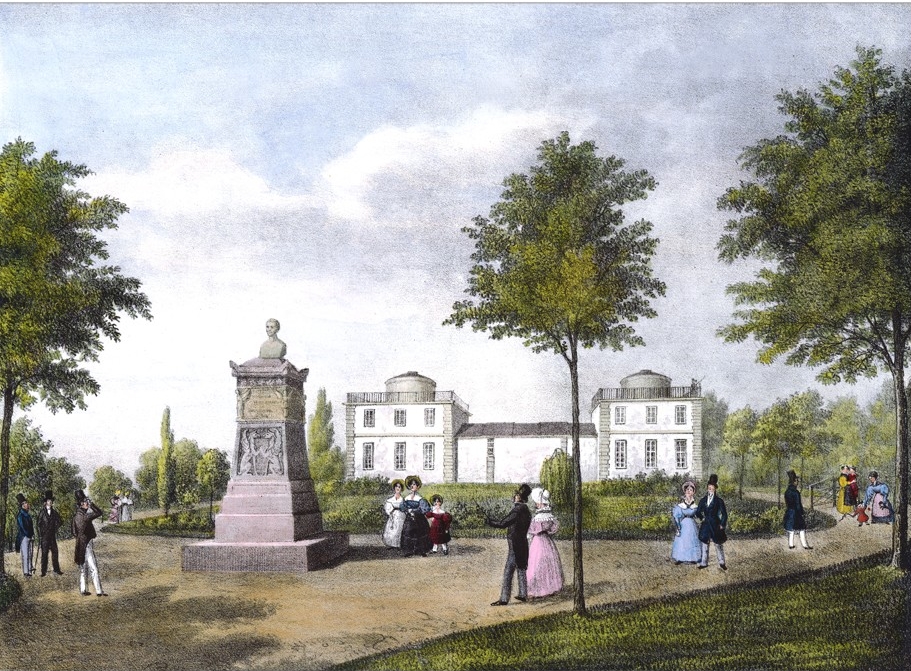
Fig. 12a. Millerntor Observatory in Hamburg (Christoffer & Peter Suhr, 1840)
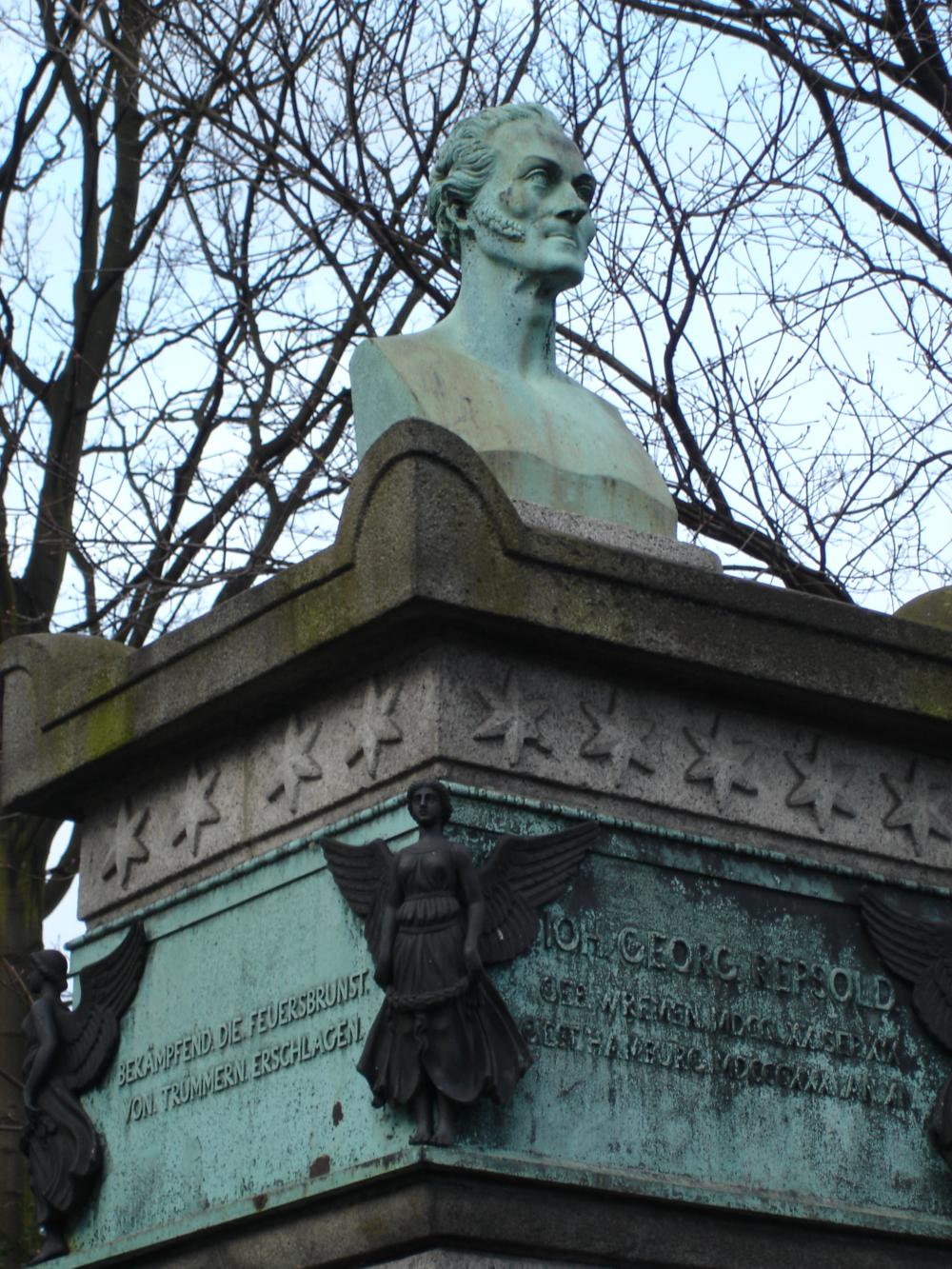
Fig. 12a,b. Place of the Millerntor Observatory with the monument for Johann Georg Repsold (Photo: Gudrun Wolfschmidt)
Comparison with related/similar sites - InfoTheme: Astronomy from the Renaissance to the mid-twentieth century
Entity: 136
Subentity: 1
Version: 6
Status: PUB
Date: 2021-04-02 18:31:44
Author(s): Gudrun Wolfschmidt
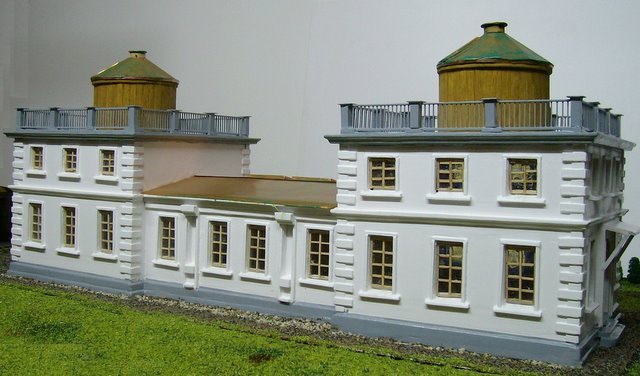
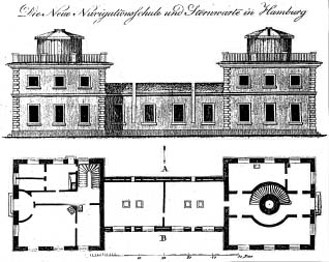
Fig. 13a,b. Model of Millerntor Observatory in Hamburg, made by Heinz-Otto Kult, 2009, and footprint (Photo: Gudrun Wolfschmidt, Jahrbuch 1829)
It is an observatory with two domes, that is rare, I know only one example, the old Brussels Observatory in Sint-Joost-ten-Node (1828--1891), which looks very much like the building of Millerntor Observatory. The reason for the two domes in Hamburg: there was one dome for the observatory and one for the navigation school.
Another example is the Royal Observatory, Cape of Good Hope, the more complicated footprint is like an H with a dome on each side.
In that time very often one dome was used for smaller observatories in the beginning of the first half of 19th century like in Gotha, Göttingen, Oslo (the buildings in the shape of a cross). Afterwards it was typical to have a rectangular building and three domes like first used in Helsinki, Kazan, and Pulkovo, St. Petersburg and throughout the 19th century.
Threats or potential threats - InfoTheme: Astronomy from the Renaissance to the mid-twentieth century
Entity: 136
Subentity: 1
Version: 2
Status: PUB
Date: 2021-03-08 17:40:49
Author(s): Gudrun Wolfschmidt
no longer existing, but instruments, library and archive are preserved in the new observatory.
Present use - InfoTheme: Astronomy from the Renaissance to the mid-twentieth century
Entity: 136
Subentity: 1
Version: 5
Status: PUB
Date: 2021-03-29 22:48:56
Author(s): Gudrun Wolfschmidt
no longer existing, only the monument for Johann Georg Repsold reminds of the history, and at some other places one finds art works in memory of Millerntor Observatory and of the astronomers.
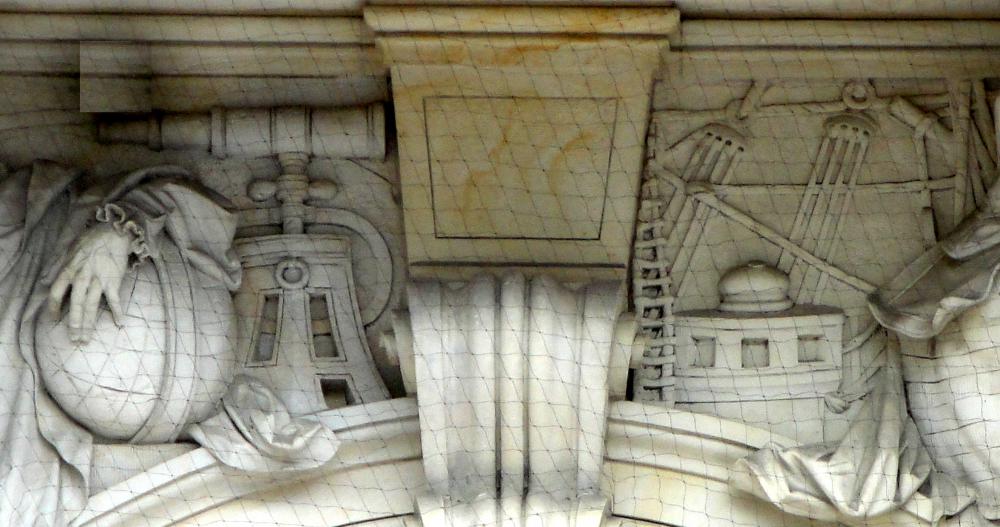
Fig. 14a. Millerntor Observatory at Hamburg stock exchange (1840) (Photo: Gudrun Wolfschmidt)
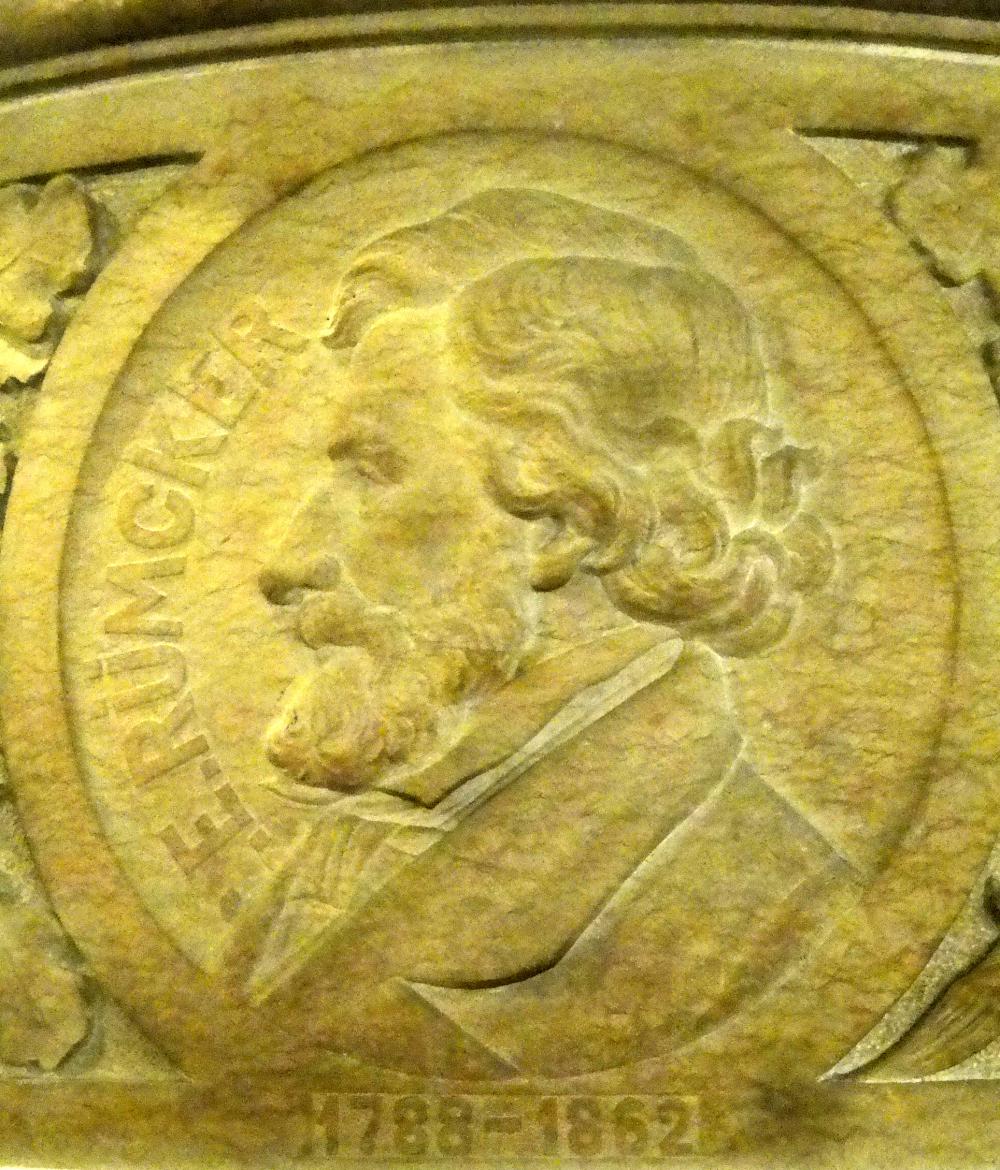
Fig. 14b. Relief of Charles Rümker in the Hamburg City Hall (Photo: Gudrun Wolfschmidt)
Astronomical relevance today - InfoTheme: Astronomy from the Renaissance to the mid-twentieth century
Entity: 136
Subentity: 1
Version: 4
Status: PUB
Date: 2021-04-02 17:24:38
Author(s): Gudrun Wolfschmidt
Important star catalogues were published and comets detected.
A crater on the moon was named in memory of Johann Georg Repsold.
Mons Rümker is named after Christian Karl Ludwig [Charles] Rümker, the first director of Millerntor Observatory.
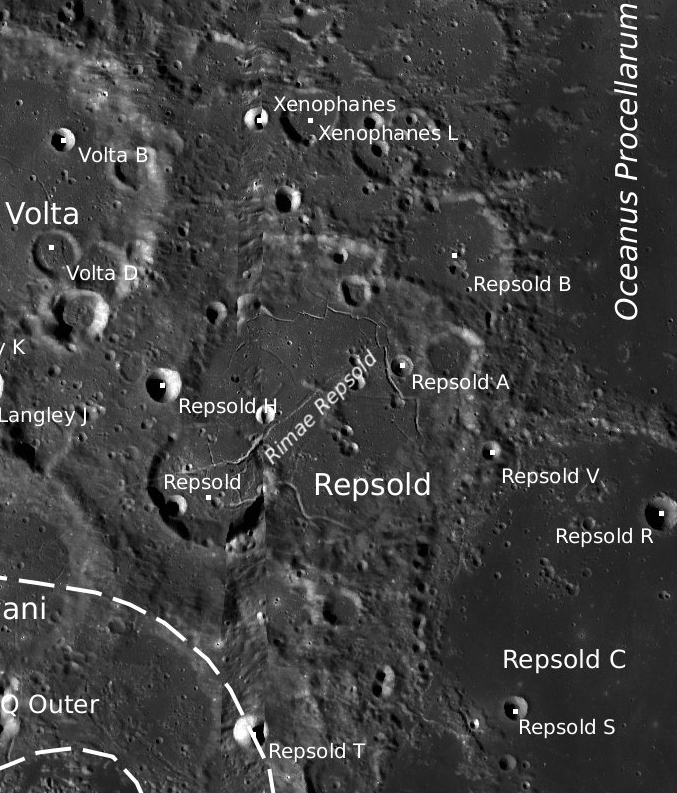
Fig. 15a. Repsold Moon Crater (LRO-WAC north pole mosaic) (NASA, Lunar Reconnaissance Orbiter)
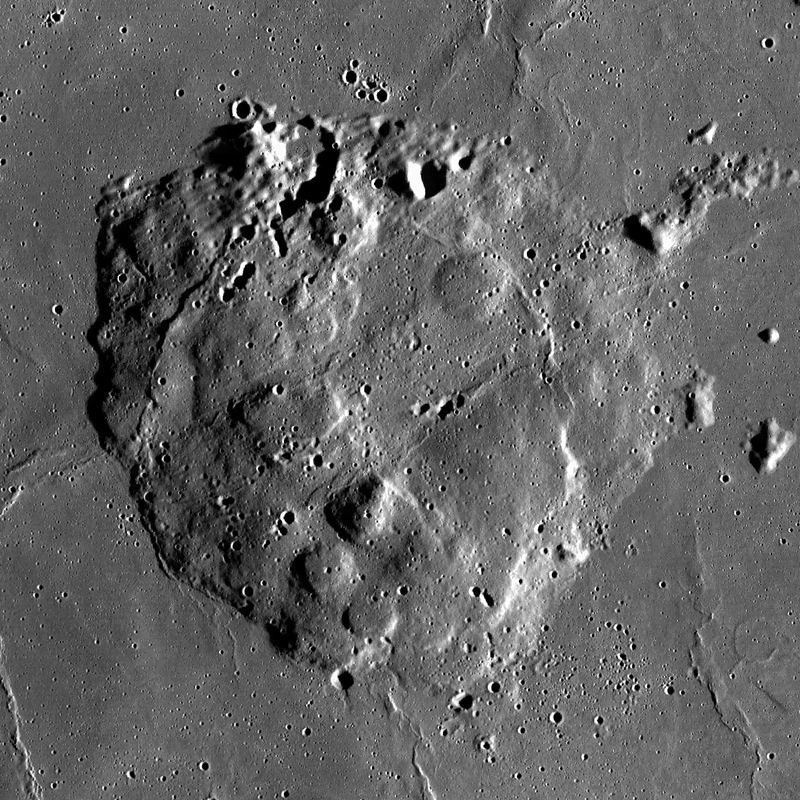
Fig. 15b. Mons Rümker, part of Oceanus Procellarum (NASA, Lunar Reconnaissance Orbiter)
References
Bibliography (books and published articles) - InfoTheme: Astronomy from the Renaissance to the mid-twentieth century
Entity: 136
Subentity: 1
Version: 6
Status: PUB
Date: 2021-04-02 18:37:45
Author(s): Gudrun Wolfschmidt
- Koch, Jürgen W.: Der Briefwechsel zwischen Johann Caspar Horner und Johann Georg Repsold. Norderstedt: BoD 1999.
- Koch, Jürgen W.: Der Briefwechsel zwischen Friedrich Wilhelm Bessel und Johann Georg Repsold. Norderstedt: BoD 2000.
- Koch, Jürgen W.: Der Briefwechsel von Johann Georg Repsold mit Carl Friedrich Gauß und Heinrich Christian Schumacher. Norderstedt: BoD 2000.
- Koch, Jürgen W.: Der Hamburger Spritzenmeister und Mechaniker Johann Georg Repsold (1770-1830), ein Beispiel für die Feinmechanik im norddeutschen Raum zu Beginn des 19. Jahrhunderts. Norderstedt: Books on Demand 2001.
- Koch, Jürgen W.: Die restlichen, noch nicht publizierten Briefe von und an Johann Georg Repsold (1770-1830) - Kommentierte Übertragung der Brieftexte. Norderstedt: BoD 2010.
- Kost, Jürgen: Die Äquatoreale der Firma Repsold in Hamburg. In: Wolfschmidt, Gudrun (Hg.): Hamburgs Geschichte einmal anders - Entwicklung der Naturwissenschaften, Medizin und Technik, Teil 3. Hamburg: tredition (Nuncius Hamburgensis; Band 20) 2011, S. 62/63-77.
- Machoczek, Detlev: Zeitdienst und Zeitball. In: Wolfschmidt, Gudrun (Hg.): Kometen, Sterne, Galaxien - Astronomie in der Hamburger Sternwarte. Zum 100jährigen Jubiläum der Hamburger Sternwarte in Bergedorf. Hamburg: tredition (Nuncius Hamburgensis - Beiträge zur Geschichte der Naturwissenschaften, Band 24) 2014, p. 70-83.
- Repsold, Johann Adolph: Zur Geschichte der astronomischen Meßwerkzeuge. Band 1: Von Purbach bis Reichenbach 1450-1830. Leipzig: Engelmann 1908. Band 2: Von 1830 bis um 1900. Leipzig: E. Reinicke 1914.
- Repsold, Johann Adolf: Vermehrte Nachrichten über die Familie Repsold. Hamburg 1896. Vermehrte Nachrichten über die Familie Repsold und insbesondere über Johann Georg Repsold. 2. berichtigte Auflage. Hamburg 1915.
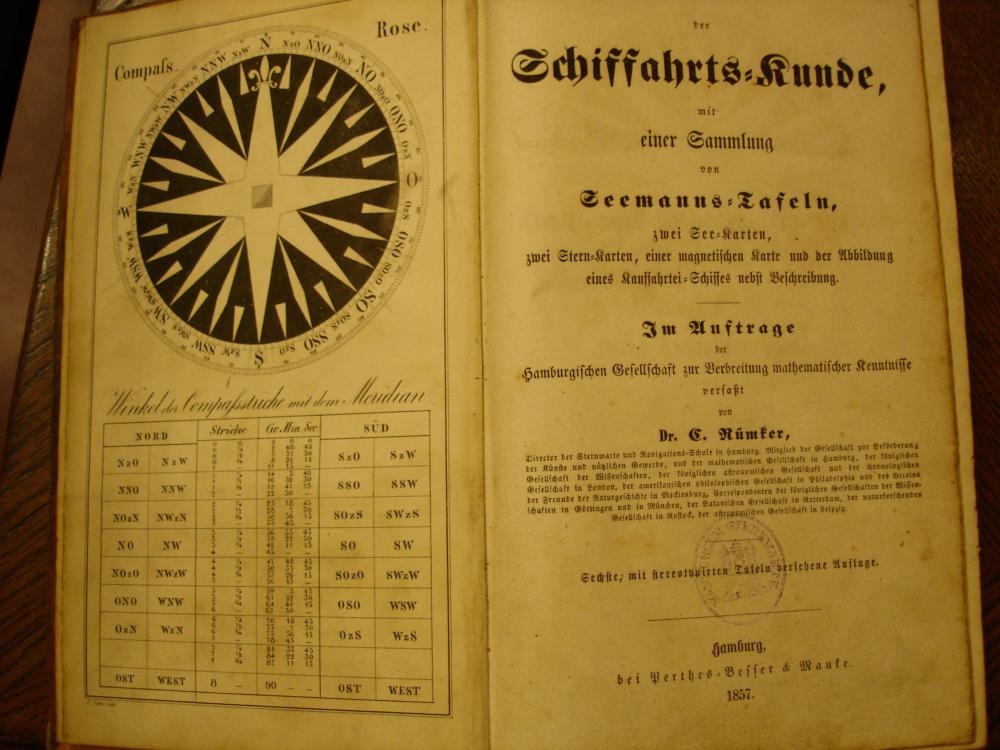
Fig. 16. Rümker, Charles: Schiffahrtskunde (1857) (Archive of Hamburg Observatory)
- Rümker, George: Beobachtungen von Circumpolar-Nebeln auf der Hamburger Sternwarte. In: Astronomische Nachrichten 63 (1865), Nr. 1508, S. 305-318. Six articles until: 68 (1867), Nr. 1631, S. 353-364.
- Schorr, Richard: Die Hamburger Sternwarte. Hamburg in naturwissenschaftlicher und medizinischer Beziehung. 73. Versammlung Deutscher Naturforscher und Ärzte. Hamburg: Leopold Voss 1901.
- Schramm, Jochen mit Beiträgen von Gudrun Wolfschmidt, Matthias Hünsch und Dieter Engels: Sterne über Hamburg. Die Geschichte der Astronomie in Hamburg. Hamburg: Kultur- und Geschichtskontor 1996, neue Auflage 2010.
- Steinicke, Wolfgang: George Rümkers Hamburger Nebelbeobachtungen. In: Wolfschmidt, Gudrun (Hg.): Kometen, Sterne, Galaxien - Astronomie in der Hamburger Sternwarte. Zum 100jährigen Jubiläum der Hamburger Sternwarte in Bergedorf. Hamburg: tredition (Nuncius Hamburgensis - Beiträge zur Geschichte der Naturwissenschaften, Band 24) 2014, p. 14-25.
- Wegner, Gerd: Aus der Geschichte der Deutschen Seewarte in Hamburg. In: Wolfschmidt, Gudrun (Hg.): Hamburgs Geschichte einmal anders - Naturwissenschaft, Medizin und Technik in Hamburg, Teil 1. Norderstedt: Books on Demand (Nuncius Hamburgensis; Bd. 2) 2007, S. 170-199.
- Wolfschmidt, Gudrun (Hg.): Sonne, Mond und Sterne - Meilensteine der Astronomiegeschichte. Zum 100jährigen Jubiläum der Hamburger Sternwarte in Bergedorf. Hamburg: tredition (Nuncius Hamburgensis - Beiträge zur Geschichte der Naturwissenschaften; Band 29) 2013.
- Wolfschmidt, Gudrun: Sonnenfinsternisexpeditionen der Hamburger Sternwarte. In: Wolfschmidt, Gudrun (Hg.): Kometen, Sterne, Galaxien -- Astronomie in der Hamburger Sternwarte. Zum 100jährigen Jubiläum der Hamburger Sternwarte in Bergedorf. Hamburg: tredition (Nuncius Hamburgensis; Band 24) 2014, S. 308-341.
Links to external sites - InfoTheme: Astronomy from the Renaissance to the mid-twentieth century
Entity: 136
Subentity: 1
Version: 2
Status: PUB
Date: 2021-04-02 18:32:41
Author(s): Gudrun Wolfschmidt
- APPLAUSE -- Archives of Photographic PLates for Astronomical USE,
https://www.plate-archive.org/applause/info/hs-history/
- Hamburger Sternwarten, Chronik,
https://www1.physik.uni-hamburg.de/hs/historical/timeline.html
- Hamburg Observatories, Timeline,
https://www1.physik.uni-hamburg.de/en/hs/historical/timeline.html
- Mathematisch-Physikalischer Salon in Kassel,
https://mathematisch-physikalischer-salon.skd.museum/en/ausstellungen/the-wondrous-course-of-the-planets/,
https://museum-kassel.de/de/museen-schloesser-parks/staatspark-karlsaue/astronomisch-physikalisches-kabinett
Links to external on-line pictures - InfoTheme: Astronomy from the Renaissance to the mid-twentieth century
Entity: 136
Subentity: 1
Version: 1
Status: PUB
Date: 2018-08-17 08:37:25
Author(s): Gudrun Wolfschmidt
no information available
PrintPrint contents of 'Description' tab
(opens in a new window) Theme
Astronomy from the Renaissance to the mid-twentieth century
Case Study Navigation
- InfoTheme: Astronomy from the Renaissance to the mid-twentieth century
Entity: 136
Subentity: 1
Version: 3
Status: PUB
Date: 2021-03-08 17:23:19
Author(s): Gudrun Wolfschmidt
Millerntor Observatory, Holstenwall, Hamburg, German Empire
Location - InfoTheme: Astronomy from the Renaissance to the mid-twentieth century
Entity: 136
Subentity: 1
Version: 3
Status: PUB
Date: 2021-03-08 17:24:09
Author(s): Gudrun Wolfschmidt
Latitude 53°33’03’’N, Longitude 09°58’24’’E, Elevation 22mm above mean sea level.
IAU observatory code - InfoTheme: Astronomy from the Renaissance to the mid-twentieth century
Entity: 136
Subentity: 1
Version: 1
Status: PUB
Date: 2018-08-17 08:37:25
Author(s): Gudrun Wolfschmidt
516
Description of (scientific/cultural/natural) heritage - InfoTheme: Astronomy from the Renaissance to the mid-twentieth century
Entity: 136
Subentity: 1
Version: 3
Status: PUB
Date: 2021-03-08 17:34:02
Author(s): Gudrun Wolfschmidt


Fig. 1. Johann Georg Repsold (1770-1830), Collections of the Center for History of Science & Technology (Photo: Gudrun Wolfschmidt)
Johann Georg Repsold (1770-1830), educated as water engineer in Cuxhaven, the seaport of Hamburg, became head of the city fire brigade and had as mechanician a workshop. Repsold started Hamburg Observatory as a private observatory (with an early meridian circle), located first on the Stintfang (1802 to 1811), Bastion Albertus, a hill above the port of Hamburg, and then a second observatory at the Millerntor (1825 to 1906/12) on the Bastion Henricus of the Hamburg city wall (Koch 2001).


Fig. 2a,b. Repsold’s first private observatory on Stintfang (1802) and his meridian circle (1802) (Archive of Hamburg Observatory)
Because of the Napoleonic Occupation of Hamburg from 1811 to 1814, the Stintfang observatory had to be demolished. The building of the German "Seewarte" (Oceanographical Institute with (Maritime) Meteorology and checking of nautical instruments - magnetic compass and sextant - and chronometers), founded in 1875 by Georg von Neumayer (1826-1909), stood here from 1879 to 1945; today is Hamburg’s Youth Hostel there.
Millerntor Observatory and Navigation School


Fig. 3a,b. Repsold’s Millerntor Observatory with Navigation School (1825) (Archive of Hamburg Observatory, Berliner-Jahrbuch 1829)
Repsold’s Millerntor Observatory was a rectangular building, erected by the government-approved master builder Hinrich Anton Christian Koch (1758-1840) in 1825, had a two-domes-facade for the astronomical institute and for the navigation school, founded already in 1749. In 1872 the Navigation School was moved from the observatory to the Seaman’s House. The director of the Navigation School was Carl Theodor B. Niebour, 1857 to 1915. Then, in 1905, the Navigation School Hamburg got a new building (today Maritime Weather Office, Bernhard-Nocht-Strasse), built by Albert Erbe (1868-1922), who also erected the new Hamburg Observatory in Bergedorf.
The astronomical instruments were donated by a private foundation, the estate of amateur astronomer Johann Christopher Grell (fl. 1824). In 1833 the Millerntor Hamburg Observatory became a Hamburg state institute with the two directors Christian Karl Ludwig [Charles] Rümker (1788-1862) and George Rümker (1832-1900).
Johann Georg Repsold made also the instruments (Heliotrop and baseline - Braaker basis) for the triangulation of Denmark, Hamburg, and the Kingdom of Hanover; he cooperated with Heinrich Christian Schumacher (1780-1850), Danish Altona Observatory (Palmaille 9, 1821 to 1873, now part of Hamburg) and Carl is still visible in Altona: 0h30m25s East of Paris.
![Christian Karl Ludwig [Charles] Rümker (1788-1862](/images/astronomicalheritage.net/gallery/ahp_entities/entity000136/Ruemker-Charles-1.jpg)
![Christian Karl Ludwig [Charles] Rümker (1788-1862](/images/astronomicalheritage.net/gallery/ahp_entities/entity000136/Ruemker-George-2.jpg)
Fig. 4a,b. Christian Karl Ludwig [Charles] Rümker (1788-1862), director from 1833 to 1857, and his son George Rümker (1832-1900), director from 1857/67 to 1899 (Archive of Hamburg Observatory)
In 1819 Karl Rümker was professor at the navigation school in Hamburg, then from 1821 to 1830 in Paramatta Observatory (near Sydney), Australia, and from 1830 to 1857 Director of the Millerntor Observatory. His main activity was the Star Catalogue of 12,000 stars (1836-1855).
His wife Mary Hannah Rümker, née Crockford, (1809-1889), discovered a comet on October 11, 1847. But the comet was already discovered by Mary Mitchell (1818-1889) as early as October 1, 1847. After Mary Rümker had made an initial determination of the orbit, the Russian Countess N. Bobinski (fl. 1891) submitted another orbit calculation to the Petersburg Academy in 1891; independently of this, Margaretta [Marguerite] Palmer (1862-1924) was able to work at Yale redetermine the path using the methods that have since been improved, essentially confirming Madame Rümker’s calculations.


Fig. 5a,b. Solar eclipse expedition to La Plata, Spain (1860) and to Algeria (1905), Millerntor Observatory Hamburg (Archive of Hamburg Observatory)
Highlights of activities of Millerntor Observatory were the solar eclipses expedition to La Plata, Spain (1860), and to Algeria (1905).

Fig. 6. Preparing the instruments for the solar eclipse expedition (1905) in front of Millerntor Observatory (Archive of Hamburg Observatory)
George Rümker, 1853-1854 in Durham Observatory in England, became the next long acting director of Millerntor Observatory from 1857/67 to 1900. He was very active in timekeeping and navigation; he was chairman of the examination board for mates (coxwains) and masters (captains).
George Rümker acquired a new "large" 26-cm-equatoreal refractor (3m focal length), Adolf Repsold & Sons of Hamburg and G. & S. Merz of Munich (1867) and observed the positions of circumpolar nebulae and compiled a catalogue (Steinicke 2014).
Time keeping and Time ball

Fig. 7. Hamburg Time ball, model in the library (Photo: Gudrun Wolfschmidt)
The topics of research in Millerntor Observatory were positional astronomy, time service system, time keeping for navigation and for the city normal clocks, and teaching in the navigational school.
An important task of the observatory was the determination of the time with transit instruments. Then the signal was transferred to the time ball, made by Carl Bamberg of Berlin; the time ball was placed on the top of a warehouse (Kaispeicher A, today place of the Elbphilharmonie) in the river Elbe in the port of Hamburg (Machoczek 2014). The time ball, a 1.5-m black ball, fell punctually at 1 pm Hamburg time three meters down, controlled by astronomical precision pendulum clocks in the observatory, the signal transferred via an underground cable, with an electric telegraph.


Fig. 8a,b. Time service system in Hamburg Observatory and Time ball on the warehouse in the river Elbe (Archive of Hamburg Observatory)
The Hamburg time ball was in service from 1874 to 1934, and the building existed until the 1960s. Time balls on the North Sea coast: Cuxhaven port (1875-1929), Wilhelmshaven Imperial Marine Observatory (1874), Bremerhaven (1894, 1876-1928), Bremen Port Authority (1895), Bremen port entrance (1905-1931).
Telegraphic time signals were sent from the Hamburg Observatory to Monrovia (Liberia), Horta (Azores), Vigo (Spain), Tenerife (Canary Islands), Pernambuco (Brazil) and Lome (Togo) - service until 1918. Since 1909, time was also available via telephone, since 1937 with a talking clock (horloge parlante) via broadcasting (radio receiver) for ecerybody.
As early as in 1912, the time signal "ONOGO" was done for the first time with wireless (radio) signals - one year before Paris Observatory, using the Eiffel Tower as an antenna (November 1913).
Towards the new Hamburg Observatory in Bergedorf
A great change occurred at the turn of the 19th and 20th centuries. Richard Schorr (1867-1951), director from 1902 to 1941, made an astonishing contribution - far-sightedness he set the course for a whole new era, for successful moving the observatory outside of the city center to Bergedorf at the Eastern border, because at the old location on the wall, the measurements were too much disrupted due to scattered light, smoke and vibrations from the harbor, industry, traffic and the city illumination.
History - InfoTheme: Astronomy from the Renaissance to the mid-twentieth century
Entity: 136
Subentity: 1
Version: 5
Status: PUB
Date: 2021-03-29 22:15:19
Author(s): Gudrun Wolfschmidt
Directors of the Observatory
- Johann Georg Repsold (1770--1830), from 1802 to 1830,
- Christian Karl Ludwig [Charles] Rümker (1788--1862), director from 1833 to 1857,
- George Rümker (1832--1900), director from 1857/67 to 1899,
- Richard Schorr (1867--1951), director from 1900 to 1941 - new observatory in Bergedorf, erected in 1906--1912.
Instruments


Fig. 9a,b. Transit instrument (1829) and Meridian circle, A. & G. Repsold of Hamburg (1836), in Millerntor Observatory in Hamburg (Photo: Gudrun Wolfschmidt in Kassel, Archive of Hamburg Observatory)
- 10-cm-Meridian circle (1802/03), since 1818 in Göttingen Observatory
- Universal instrument (1806)
- Transit instrument (1829), today in the Physikalisch-Astronomisches Kabinett Kassel
- 2 ft Dividing engine (Kreisteilmaschine) (1818) in a special pavilion
- Meridian circle, A. & G. Repsold of Hamburg (1836)
- Solar eclipse expedition instruments
- 26-cm-Equatoreal refractor (3m focal length), A. & G. Repsold of Hamburg and Merz of Munich (1867)
- Time keeping devices, Switchboard, Telegraph, ...
- Contact clockwork, J. & A. Unger, Straßburg/Strasbourg (1900)
- Telephone time signal.


Fig. 10a,b. Tower and 26-cm-Equatoreal refractor (3m focal length), A. & G. Repsold of Hamburg and Merz of Munich (1867) in Millerntor Observatory in Hamburg (Archive of Hamburg Observatory)
Repsold firm in Hamburg
Johann Georg Repsold (1770-1830) was famous for his mechanical precision workshop for astronomical and geodetical instruments, founded in 1799 - the basis for the famous Repsold firm in Hamburg: A. & G. Repsold (since 1830) and A. Repsold & Söhne, 1867 to 1919. The workshop was first in the observatory, then in Herrengraben, since 1854 in the Böhmkenstrasse near the Michaelis church, later in the Borgfelder Mittelweg. The company delivered astronomical instruments (meridian circles, equatorial telescopes, heliometers, refractors, and geodetic instruments) to observatories all over the world; the optics was made in cooperation with the well-known Munich companies, Merz or Steinheil.
Adolf & Georg Repsold 1830-1867, Herrengraben,
1854-1871 in der Böhmkenstraße near Michaelis church
- Georg Repsold (1804-1867) - Son of Johann Georg Repsold
- Adolf Repsold (1806-1871) - Son of Johann Georg Repsold
The first larger instruments were made for:
- Bessel in the Königsberg observatory
- the Edinburgh observatory
- the Oxford heliometer (1845)
- for the Madrid observatory: the 6½ foot meridian circle (1854).
A. Repsold & Sons 1867-1919, 1854-1871 in Böhmkenstrasse near Michaelis,
1872-1919 workshop and house in Borgfelder Mittelweg near the Berliner Tor (today Klaus-Groth-Straße)
- Adolf Repsold (1806-1871)
- Repsold, Johann Georg (1832-1912) - Son of Georg Repsold
- Dr.phil.h.c. Repsold, Johann Adolph (1838-1919), known as Hans, - Son of Adolf Repsold
- Repsold, Oscar Philipp (1842-1919) - 3rd Son of Adolf Repsold
Publication of Repsold, Johann Adolph: Zur Geschichte
der astronomischen Meßwerkzeuge (1908, 1914).
Repsold’s Refractors after 1875:
- f=4.2m Nikolajew (ordered 1873)
- f=5.2m Potsdam (ordered in 1875)
- f=6.8m Straßburg/Strasbourg (ordered in 1876)
- f=6.8m Milan (ordered in 1876)
- f=6.8m Pulkowa/St. Petersburg (1876)
- f=14m, 80cm Pulkovo, St.Petersburg (1884)
- f=12m, 80cm Potsdam (delivered in 1898)
- f=9m, 60cm Hamburg (delivered in 1912)
Repsold’s Instruments - after 1870
- many meridian circles (for Hamburg 1909)
- many universal instruments
- Heliometer for the Venus Transit Expedition 1874 (5 foot heliometer for the ’German Venus Expedition’)
State of preservation - InfoTheme: Astronomy from the Renaissance to the mid-twentieth century
Entity: 136
Subentity: 1
Version: 10
Status: PUB
Date: 2021-03-29 22:51:18
Author(s): Gudrun Wolfschmidt
The Millerntor Observatory was demolished after 1912, when the new Hamburg Observatory in Bergedorf was ready. On the site, the Hamburg History Museum was built by Fritz Schumacher (1914 to 1922). But the monument for Johann Georg Repsold as founder of Hamburg Observatory and as head of the fire brigade, is still there in the original place.
The instruments, meridian circle, transit instrument, the solar eclipse expedition instruments, and the library were brought to the new Hamburg Observatory in Bergedorf (1912). Especially the equatorial refractor, including the dome, was moved to Bergedorf. There a new cylindrical building was erected and the dome reused.

Fig. 12a. Millerntor Observatory in Hamburg (Christoffer & Peter Suhr, 1840)

Fig. 12a,b. Place of the Millerntor Observatory with the monument for Johann Georg Repsold (Photo: Gudrun Wolfschmidt)
Comparison with related/similar sites - InfoTheme: Astronomy from the Renaissance to the mid-twentieth century
Entity: 136
Subentity: 1
Version: 6
Status: PUB
Date: 2021-04-02 18:31:44
Author(s): Gudrun Wolfschmidt


Fig. 13a,b. Model of Millerntor Observatory in Hamburg, made by Heinz-Otto Kult, 2009, and footprint (Photo: Gudrun Wolfschmidt, Jahrbuch 1829)
It is an observatory with two domes, that is rare, I know only one example, the old Brussels Observatory in Sint-Joost-ten-Node (1828--1891), which looks very much like the building of Millerntor Observatory. The reason for the two domes in Hamburg: there was one dome for the observatory and one for the navigation school.
Another example is the Royal Observatory, Cape of Good Hope, the more complicated footprint is like an H with a dome on each side.
In that time very often one dome was used for smaller observatories in the beginning of the first half of 19th century like in Gotha, Göttingen, Oslo (the buildings in the shape of a cross). Afterwards it was typical to have a rectangular building and three domes like first used in Helsinki, Kazan, and Pulkovo, St. Petersburg and throughout the 19th century.
Threats or potential threats - InfoTheme: Astronomy from the Renaissance to the mid-twentieth century
Entity: 136
Subentity: 1
Version: 2
Status: PUB
Date: 2021-03-08 17:40:49
Author(s): Gudrun Wolfschmidt
no longer existing, but instruments, library and archive are preserved in the new observatory.
Present use - InfoTheme: Astronomy from the Renaissance to the mid-twentieth century
Entity: 136
Subentity: 1
Version: 5
Status: PUB
Date: 2021-03-29 22:48:56
Author(s): Gudrun Wolfschmidt
no longer existing, only the monument for Johann Georg Repsold reminds of the history, and at some other places one finds art works in memory of Millerntor Observatory and of the astronomers.

Fig. 14a. Millerntor Observatory at Hamburg stock exchange (1840) (Photo: Gudrun Wolfschmidt)

Fig. 14b. Relief of Charles Rümker in the Hamburg City Hall (Photo: Gudrun Wolfschmidt)
Astronomical relevance today - InfoTheme: Astronomy from the Renaissance to the mid-twentieth century
Entity: 136
Subentity: 1
Version: 4
Status: PUB
Date: 2021-04-02 17:24:38
Author(s): Gudrun Wolfschmidt
Important star catalogues were published and comets detected.
A crater on the moon was named in memory of Johann Georg Repsold.
Mons Rümker is named after Christian Karl Ludwig [Charles] Rümker, the first director of Millerntor Observatory.

Fig. 15a. Repsold Moon Crater (LRO-WAC north pole mosaic) (NASA, Lunar Reconnaissance Orbiter)

Fig. 15b. Mons Rümker, part of Oceanus Procellarum (NASA, Lunar Reconnaissance Orbiter)
References
Bibliography (books and published articles) - InfoTheme: Astronomy from the Renaissance to the mid-twentieth century
Entity: 136
Subentity: 1
Version: 6
Status: PUB
Date: 2021-04-02 18:37:45
Author(s): Gudrun Wolfschmidt
- Koch, Jürgen W.: Der Briefwechsel zwischen Johann Caspar Horner und Johann Georg Repsold. Norderstedt: BoD 1999.
- Koch, Jürgen W.: Der Briefwechsel zwischen Friedrich Wilhelm Bessel und Johann Georg Repsold. Norderstedt: BoD 2000.
- Koch, Jürgen W.: Der Briefwechsel von Johann Georg Repsold mit Carl Friedrich Gauß und Heinrich Christian Schumacher. Norderstedt: BoD 2000.
- Koch, Jürgen W.: Der Hamburger Spritzenmeister und Mechaniker Johann Georg Repsold (1770-1830), ein Beispiel für die Feinmechanik im norddeutschen Raum zu Beginn des 19. Jahrhunderts. Norderstedt: Books on Demand 2001.
- Koch, Jürgen W.: Die restlichen, noch nicht publizierten Briefe von und an Johann Georg Repsold (1770-1830) - Kommentierte Übertragung der Brieftexte. Norderstedt: BoD 2010.
- Kost, Jürgen: Die Äquatoreale der Firma Repsold in Hamburg. In: Wolfschmidt, Gudrun (Hg.): Hamburgs Geschichte einmal anders - Entwicklung der Naturwissenschaften, Medizin und Technik, Teil 3. Hamburg: tredition (Nuncius Hamburgensis; Band 20) 2011, S. 62/63-77.
- Machoczek, Detlev: Zeitdienst und Zeitball. In: Wolfschmidt, Gudrun (Hg.): Kometen, Sterne, Galaxien - Astronomie in der Hamburger Sternwarte. Zum 100jährigen Jubiläum der Hamburger Sternwarte in Bergedorf. Hamburg: tredition (Nuncius Hamburgensis - Beiträge zur Geschichte der Naturwissenschaften, Band 24) 2014, p. 70-83.
- Repsold, Johann Adolph: Zur Geschichte der astronomischen Meßwerkzeuge. Band 1: Von Purbach bis Reichenbach 1450-1830. Leipzig: Engelmann 1908. Band 2: Von 1830 bis um 1900. Leipzig: E. Reinicke 1914.
- Repsold, Johann Adolf: Vermehrte Nachrichten über die Familie Repsold. Hamburg 1896. Vermehrte Nachrichten über die Familie Repsold und insbesondere über Johann Georg Repsold. 2. berichtigte Auflage. Hamburg 1915.

Fig. 16. Rümker, Charles: Schiffahrtskunde (1857) (Archive of Hamburg Observatory)
- Rümker, George: Beobachtungen von Circumpolar-Nebeln auf der Hamburger Sternwarte. In: Astronomische Nachrichten 63 (1865), Nr. 1508, S. 305-318. Six articles until: 68 (1867), Nr. 1631, S. 353-364.
- Schorr, Richard: Die Hamburger Sternwarte. Hamburg in naturwissenschaftlicher und medizinischer Beziehung. 73. Versammlung Deutscher Naturforscher und Ärzte. Hamburg: Leopold Voss 1901.
- Schramm, Jochen mit Beiträgen von Gudrun Wolfschmidt, Matthias Hünsch und Dieter Engels: Sterne über Hamburg. Die Geschichte der Astronomie in Hamburg. Hamburg: Kultur- und Geschichtskontor 1996, neue Auflage 2010.
- Steinicke, Wolfgang: George Rümkers Hamburger Nebelbeobachtungen. In: Wolfschmidt, Gudrun (Hg.): Kometen, Sterne, Galaxien - Astronomie in der Hamburger Sternwarte. Zum 100jährigen Jubiläum der Hamburger Sternwarte in Bergedorf. Hamburg: tredition (Nuncius Hamburgensis - Beiträge zur Geschichte der Naturwissenschaften, Band 24) 2014, p. 14-25.
- Wegner, Gerd: Aus der Geschichte der Deutschen Seewarte in Hamburg. In: Wolfschmidt, Gudrun (Hg.): Hamburgs Geschichte einmal anders - Naturwissenschaft, Medizin und Technik in Hamburg, Teil 1. Norderstedt: Books on Demand (Nuncius Hamburgensis; Bd. 2) 2007, S. 170-199.
- Wolfschmidt, Gudrun (Hg.): Sonne, Mond und Sterne - Meilensteine der Astronomiegeschichte. Zum 100jährigen Jubiläum der Hamburger Sternwarte in Bergedorf. Hamburg: tredition (Nuncius Hamburgensis - Beiträge zur Geschichte der Naturwissenschaften; Band 29) 2013.
- Wolfschmidt, Gudrun: Sonnenfinsternisexpeditionen der Hamburger Sternwarte. In: Wolfschmidt, Gudrun (Hg.): Kometen, Sterne, Galaxien -- Astronomie in der Hamburger Sternwarte. Zum 100jährigen Jubiläum der Hamburger Sternwarte in Bergedorf. Hamburg: tredition (Nuncius Hamburgensis; Band 24) 2014, S. 308-341.
Links to external sites - InfoTheme: Astronomy from the Renaissance to the mid-twentieth century
Entity: 136
Subentity: 1
Version: 2
Status: PUB
Date: 2021-04-02 18:32:41
Author(s): Gudrun Wolfschmidt
- APPLAUSE -- Archives of Photographic PLates for Astronomical USE,
https://www.plate-archive.org/applause/info/hs-history/
- Hamburger Sternwarten, Chronik,
https://www1.physik.uni-hamburg.de/hs/historical/timeline.html
- Hamburg Observatories, Timeline,
https://www1.physik.uni-hamburg.de/en/hs/historical/timeline.html
- Mathematisch-Physikalischer Salon in Kassel,
https://mathematisch-physikalischer-salon.skd.museum/en/ausstellungen/the-wondrous-course-of-the-planets/,
https://museum-kassel.de/de/museen-schloesser-parks/staatspark-karlsaue/astronomisch-physikalisches-kabinett
Links to external on-line pictures - InfoTheme: Astronomy from the Renaissance to the mid-twentieth century
Entity: 136
Subentity: 1
Version: 1
Status: PUB
Date: 2018-08-17 08:37:25
Author(s): Gudrun Wolfschmidt
no information available
PrintPrint contents of 'Description' tab
(opens in a new window) Theme
Astronomy from the Renaissance to the mid-twentieth century
Case Study Navigation
- InfoTheme: Astronomy from the Renaissance to the mid-twentieth century
Entity: 136
Subentity: 1
Version: 3
Status: PUB
Date: 2021-03-08 17:24:09
Author(s): Gudrun Wolfschmidt
Latitude 53°33’03’’N, Longitude 09°58’24’’E, Elevation 22mm above mean sea level.
IAU observatory code - InfoTheme: Astronomy from the Renaissance to the mid-twentieth century
Entity: 136
Subentity: 1
Version: 1
Status: PUB
Date: 2018-08-17 08:37:25
Author(s): Gudrun Wolfschmidt
516
Description of (scientific/cultural/natural) heritage - InfoTheme: Astronomy from the Renaissance to the mid-twentieth century
Entity: 136
Subentity: 1
Version: 3
Status: PUB
Date: 2021-03-08 17:34:02
Author(s): Gudrun Wolfschmidt


Fig. 1. Johann Georg Repsold (1770-1830), Collections of the Center for History of Science & Technology (Photo: Gudrun Wolfschmidt)
Johann Georg Repsold (1770-1830), educated as water engineer in Cuxhaven, the seaport of Hamburg, became head of the city fire brigade and had as mechanician a workshop. Repsold started Hamburg Observatory as a private observatory (with an early meridian circle), located first on the Stintfang (1802 to 1811), Bastion Albertus, a hill above the port of Hamburg, and then a second observatory at the Millerntor (1825 to 1906/12) on the Bastion Henricus of the Hamburg city wall (Koch 2001).


Fig. 2a,b. Repsold’s first private observatory on Stintfang (1802) and his meridian circle (1802) (Archive of Hamburg Observatory)
Because of the Napoleonic Occupation of Hamburg from 1811 to 1814, the Stintfang observatory had to be demolished. The building of the German "Seewarte" (Oceanographical Institute with (Maritime) Meteorology and checking of nautical instruments - magnetic compass and sextant - and chronometers), founded in 1875 by Georg von Neumayer (1826-1909), stood here from 1879 to 1945; today is Hamburg’s Youth Hostel there.
Millerntor Observatory and Navigation School


Fig. 3a,b. Repsold’s Millerntor Observatory with Navigation School (1825) (Archive of Hamburg Observatory, Berliner-Jahrbuch 1829)
Repsold’s Millerntor Observatory was a rectangular building, erected by the government-approved master builder Hinrich Anton Christian Koch (1758-1840) in 1825, had a two-domes-facade for the astronomical institute and for the navigation school, founded already in 1749. In 1872 the Navigation School was moved from the observatory to the Seaman’s House. The director of the Navigation School was Carl Theodor B. Niebour, 1857 to 1915. Then, in 1905, the Navigation School Hamburg got a new building (today Maritime Weather Office, Bernhard-Nocht-Strasse), built by Albert Erbe (1868-1922), who also erected the new Hamburg Observatory in Bergedorf.
The astronomical instruments were donated by a private foundation, the estate of amateur astronomer Johann Christopher Grell (fl. 1824). In 1833 the Millerntor Hamburg Observatory became a Hamburg state institute with the two directors Christian Karl Ludwig [Charles] Rümker (1788-1862) and George Rümker (1832-1900).
Johann Georg Repsold made also the instruments (Heliotrop and baseline - Braaker basis) for the triangulation of Denmark, Hamburg, and the Kingdom of Hanover; he cooperated with Heinrich Christian Schumacher (1780-1850), Danish Altona Observatory (Palmaille 9, 1821 to 1873, now part of Hamburg) and Carl is still visible in Altona: 0h30m25s East of Paris.
![Christian Karl Ludwig [Charles] Rümker (1788-1862](/images/astronomicalheritage.net/gallery/ahp_entities/entity000136/Ruemker-Charles-1.jpg)
![Christian Karl Ludwig [Charles] Rümker (1788-1862](/images/astronomicalheritage.net/gallery/ahp_entities/entity000136/Ruemker-George-2.jpg)
Fig. 4a,b. Christian Karl Ludwig [Charles] Rümker (1788-1862), director from 1833 to 1857, and his son George Rümker (1832-1900), director from 1857/67 to 1899 (Archive of Hamburg Observatory)
In 1819 Karl Rümker was professor at the navigation school in Hamburg, then from 1821 to 1830 in Paramatta Observatory (near Sydney), Australia, and from 1830 to 1857 Director of the Millerntor Observatory. His main activity was the Star Catalogue of 12,000 stars (1836-1855).
His wife Mary Hannah Rümker, née Crockford, (1809-1889), discovered a comet on October 11, 1847. But the comet was already discovered by Mary Mitchell (1818-1889) as early as October 1, 1847. After Mary Rümker had made an initial determination of the orbit, the Russian Countess N. Bobinski (fl. 1891) submitted another orbit calculation to the Petersburg Academy in 1891; independently of this, Margaretta [Marguerite] Palmer (1862-1924) was able to work at Yale redetermine the path using the methods that have since been improved, essentially confirming Madame Rümker’s calculations.


Fig. 5a,b. Solar eclipse expedition to La Plata, Spain (1860) and to Algeria (1905), Millerntor Observatory Hamburg (Archive of Hamburg Observatory)
Highlights of activities of Millerntor Observatory were the solar eclipses expedition to La Plata, Spain (1860), and to Algeria (1905).

Fig. 6. Preparing the instruments for the solar eclipse expedition (1905) in front of Millerntor Observatory (Archive of Hamburg Observatory)
George Rümker, 1853-1854 in Durham Observatory in England, became the next long acting director of Millerntor Observatory from 1857/67 to 1900. He was very active in timekeeping and navigation; he was chairman of the examination board for mates (coxwains) and masters (captains).
George Rümker acquired a new "large" 26-cm-equatoreal refractor (3m focal length), Adolf Repsold & Sons of Hamburg and G. & S. Merz of Munich (1867) and observed the positions of circumpolar nebulae and compiled a catalogue (Steinicke 2014).
Time keeping and Time ball

Fig. 7. Hamburg Time ball, model in the library (Photo: Gudrun Wolfschmidt)
The topics of research in Millerntor Observatory were positional astronomy, time service system, time keeping for navigation and for the city normal clocks, and teaching in the navigational school.
An important task of the observatory was the determination of the time with transit instruments. Then the signal was transferred to the time ball, made by Carl Bamberg of Berlin; the time ball was placed on the top of a warehouse (Kaispeicher A, today place of the Elbphilharmonie) in the river Elbe in the port of Hamburg (Machoczek 2014). The time ball, a 1.5-m black ball, fell punctually at 1 pm Hamburg time three meters down, controlled by astronomical precision pendulum clocks in the observatory, the signal transferred via an underground cable, with an electric telegraph.


Fig. 8a,b. Time service system in Hamburg Observatory and Time ball on the warehouse in the river Elbe (Archive of Hamburg Observatory)
The Hamburg time ball was in service from 1874 to 1934, and the building existed until the 1960s. Time balls on the North Sea coast: Cuxhaven port (1875-1929), Wilhelmshaven Imperial Marine Observatory (1874), Bremerhaven (1894, 1876-1928), Bremen Port Authority (1895), Bremen port entrance (1905-1931).
Telegraphic time signals were sent from the Hamburg Observatory to Monrovia (Liberia), Horta (Azores), Vigo (Spain), Tenerife (Canary Islands), Pernambuco (Brazil) and Lome (Togo) - service until 1918. Since 1909, time was also available via telephone, since 1937 with a talking clock (horloge parlante) via broadcasting (radio receiver) for ecerybody.
As early as in 1912, the time signal "ONOGO" was done for the first time with wireless (radio) signals - one year before Paris Observatory, using the Eiffel Tower as an antenna (November 1913).
Towards the new Hamburg Observatory in Bergedorf
A great change occurred at the turn of the 19th and 20th centuries. Richard Schorr (1867-1951), director from 1902 to 1941, made an astonishing contribution - far-sightedness he set the course for a whole new era, for successful moving the observatory outside of the city center to Bergedorf at the Eastern border, because at the old location on the wall, the measurements were too much disrupted due to scattered light, smoke and vibrations from the harbor, industry, traffic and the city illumination.
History - InfoTheme: Astronomy from the Renaissance to the mid-twentieth century
Entity: 136
Subentity: 1
Version: 5
Status: PUB
Date: 2021-03-29 22:15:19
Author(s): Gudrun Wolfschmidt
Directors of the Observatory
- Johann Georg Repsold (1770--1830), from 1802 to 1830,
- Christian Karl Ludwig [Charles] Rümker (1788--1862), director from 1833 to 1857,
- George Rümker (1832--1900), director from 1857/67 to 1899,
- Richard Schorr (1867--1951), director from 1900 to 1941 - new observatory in Bergedorf, erected in 1906--1912.
Instruments


Fig. 9a,b. Transit instrument (1829) and Meridian circle, A. & G. Repsold of Hamburg (1836), in Millerntor Observatory in Hamburg (Photo: Gudrun Wolfschmidt in Kassel, Archive of Hamburg Observatory)
- 10-cm-Meridian circle (1802/03), since 1818 in Göttingen Observatory
- Universal instrument (1806)
- Transit instrument (1829), today in the Physikalisch-Astronomisches Kabinett Kassel
- 2 ft Dividing engine (Kreisteilmaschine) (1818) in a special pavilion
- Meridian circle, A. & G. Repsold of Hamburg (1836)
- Solar eclipse expedition instruments
- 26-cm-Equatoreal refractor (3m focal length), A. & G. Repsold of Hamburg and Merz of Munich (1867)
- Time keeping devices, Switchboard, Telegraph, ...
- Contact clockwork, J. & A. Unger, Straßburg/Strasbourg (1900)
- Telephone time signal.


Fig. 10a,b. Tower and 26-cm-Equatoreal refractor (3m focal length), A. & G. Repsold of Hamburg and Merz of Munich (1867) in Millerntor Observatory in Hamburg (Archive of Hamburg Observatory)
Repsold firm in Hamburg
Johann Georg Repsold (1770-1830) was famous for his mechanical precision workshop for astronomical and geodetical instruments, founded in 1799 - the basis for the famous Repsold firm in Hamburg: A. & G. Repsold (since 1830) and A. Repsold & Söhne, 1867 to 1919. The workshop was first in the observatory, then in Herrengraben, since 1854 in the Böhmkenstrasse near the Michaelis church, later in the Borgfelder Mittelweg. The company delivered astronomical instruments (meridian circles, equatorial telescopes, heliometers, refractors, and geodetic instruments) to observatories all over the world; the optics was made in cooperation with the well-known Munich companies, Merz or Steinheil.
Adolf & Georg Repsold 1830-1867, Herrengraben,
1854-1871 in der Böhmkenstraße near Michaelis church
- Georg Repsold (1804-1867) - Son of Johann Georg Repsold
- Adolf Repsold (1806-1871) - Son of Johann Georg Repsold
The first larger instruments were made for:
- Bessel in the Königsberg observatory
- the Edinburgh observatory
- the Oxford heliometer (1845)
- for the Madrid observatory: the 6½ foot meridian circle (1854).
A. Repsold & Sons 1867-1919, 1854-1871 in Böhmkenstrasse near Michaelis,
1872-1919 workshop and house in Borgfelder Mittelweg near the Berliner Tor (today Klaus-Groth-Straße)
- Adolf Repsold (1806-1871)
- Repsold, Johann Georg (1832-1912) - Son of Georg Repsold
- Dr.phil.h.c. Repsold, Johann Adolph (1838-1919), known as Hans, - Son of Adolf Repsold
- Repsold, Oscar Philipp (1842-1919) - 3rd Son of Adolf Repsold
Publication of Repsold, Johann Adolph: Zur Geschichte
der astronomischen Meßwerkzeuge (1908, 1914).
Repsold’s Refractors after 1875:
- f=4.2m Nikolajew (ordered 1873)
- f=5.2m Potsdam (ordered in 1875)
- f=6.8m Straßburg/Strasbourg (ordered in 1876)
- f=6.8m Milan (ordered in 1876)
- f=6.8m Pulkowa/St. Petersburg (1876)
- f=14m, 80cm Pulkovo, St.Petersburg (1884)
- f=12m, 80cm Potsdam (delivered in 1898)
- f=9m, 60cm Hamburg (delivered in 1912)
Repsold’s Instruments - after 1870
- many meridian circles (for Hamburg 1909)
- many universal instruments
- Heliometer for the Venus Transit Expedition 1874 (5 foot heliometer for the ’German Venus Expedition’)
State of preservation - InfoTheme: Astronomy from the Renaissance to the mid-twentieth century
Entity: 136
Subentity: 1
Version: 10
Status: PUB
Date: 2021-03-29 22:51:18
Author(s): Gudrun Wolfschmidt
The Millerntor Observatory was demolished after 1912, when the new Hamburg Observatory in Bergedorf was ready. On the site, the Hamburg History Museum was built by Fritz Schumacher (1914 to 1922). But the monument for Johann Georg Repsold as founder of Hamburg Observatory and as head of the fire brigade, is still there in the original place.
The instruments, meridian circle, transit instrument, the solar eclipse expedition instruments, and the library were brought to the new Hamburg Observatory in Bergedorf (1912). Especially the equatorial refractor, including the dome, was moved to Bergedorf. There a new cylindrical building was erected and the dome reused.

Fig. 12a. Millerntor Observatory in Hamburg (Christoffer & Peter Suhr, 1840)

Fig. 12a,b. Place of the Millerntor Observatory with the monument for Johann Georg Repsold (Photo: Gudrun Wolfschmidt)
Comparison with related/similar sites - InfoTheme: Astronomy from the Renaissance to the mid-twentieth century
Entity: 136
Subentity: 1
Version: 6
Status: PUB
Date: 2021-04-02 18:31:44
Author(s): Gudrun Wolfschmidt


Fig. 13a,b. Model of Millerntor Observatory in Hamburg, made by Heinz-Otto Kult, 2009, and footprint (Photo: Gudrun Wolfschmidt, Jahrbuch 1829)
It is an observatory with two domes, that is rare, I know only one example, the old Brussels Observatory in Sint-Joost-ten-Node (1828--1891), which looks very much like the building of Millerntor Observatory. The reason for the two domes in Hamburg: there was one dome for the observatory and one for the navigation school.
Another example is the Royal Observatory, Cape of Good Hope, the more complicated footprint is like an H with a dome on each side.
In that time very often one dome was used for smaller observatories in the beginning of the first half of 19th century like in Gotha, Göttingen, Oslo (the buildings in the shape of a cross). Afterwards it was typical to have a rectangular building and three domes like first used in Helsinki, Kazan, and Pulkovo, St. Petersburg and throughout the 19th century.
Threats or potential threats - InfoTheme: Astronomy from the Renaissance to the mid-twentieth century
Entity: 136
Subentity: 1
Version: 2
Status: PUB
Date: 2021-03-08 17:40:49
Author(s): Gudrun Wolfschmidt
no longer existing, but instruments, library and archive are preserved in the new observatory.
Present use - InfoTheme: Astronomy from the Renaissance to the mid-twentieth century
Entity: 136
Subentity: 1
Version: 5
Status: PUB
Date: 2021-03-29 22:48:56
Author(s): Gudrun Wolfschmidt
no longer existing, only the monument for Johann Georg Repsold reminds of the history, and at some other places one finds art works in memory of Millerntor Observatory and of the astronomers.

Fig. 14a. Millerntor Observatory at Hamburg stock exchange (1840) (Photo: Gudrun Wolfschmidt)

Fig. 14b. Relief of Charles Rümker in the Hamburg City Hall (Photo: Gudrun Wolfschmidt)
Astronomical relevance today - InfoTheme: Astronomy from the Renaissance to the mid-twentieth century
Entity: 136
Subentity: 1
Version: 4
Status: PUB
Date: 2021-04-02 17:24:38
Author(s): Gudrun Wolfschmidt
Important star catalogues were published and comets detected.
A crater on the moon was named in memory of Johann Georg Repsold.
Mons Rümker is named after Christian Karl Ludwig [Charles] Rümker, the first director of Millerntor Observatory.

Fig. 15a. Repsold Moon Crater (LRO-WAC north pole mosaic) (NASA, Lunar Reconnaissance Orbiter)

Fig. 15b. Mons Rümker, part of Oceanus Procellarum (NASA, Lunar Reconnaissance Orbiter)
References
Bibliography (books and published articles) - InfoTheme: Astronomy from the Renaissance to the mid-twentieth century
Entity: 136
Subentity: 1
Version: 6
Status: PUB
Date: 2021-04-02 18:37:45
Author(s): Gudrun Wolfschmidt
- Koch, Jürgen W.: Der Briefwechsel zwischen Johann Caspar Horner und Johann Georg Repsold. Norderstedt: BoD 1999.
- Koch, Jürgen W.: Der Briefwechsel zwischen Friedrich Wilhelm Bessel und Johann Georg Repsold. Norderstedt: BoD 2000.
- Koch, Jürgen W.: Der Briefwechsel von Johann Georg Repsold mit Carl Friedrich Gauß und Heinrich Christian Schumacher. Norderstedt: BoD 2000.
- Koch, Jürgen W.: Der Hamburger Spritzenmeister und Mechaniker Johann Georg Repsold (1770-1830), ein Beispiel für die Feinmechanik im norddeutschen Raum zu Beginn des 19. Jahrhunderts. Norderstedt: Books on Demand 2001.
- Koch, Jürgen W.: Die restlichen, noch nicht publizierten Briefe von und an Johann Georg Repsold (1770-1830) - Kommentierte Übertragung der Brieftexte. Norderstedt: BoD 2010.
- Kost, Jürgen: Die Äquatoreale der Firma Repsold in Hamburg. In: Wolfschmidt, Gudrun (Hg.): Hamburgs Geschichte einmal anders - Entwicklung der Naturwissenschaften, Medizin und Technik, Teil 3. Hamburg: tredition (Nuncius Hamburgensis; Band 20) 2011, S. 62/63-77.
- Machoczek, Detlev: Zeitdienst und Zeitball. In: Wolfschmidt, Gudrun (Hg.): Kometen, Sterne, Galaxien - Astronomie in der Hamburger Sternwarte. Zum 100jährigen Jubiläum der Hamburger Sternwarte in Bergedorf. Hamburg: tredition (Nuncius Hamburgensis - Beiträge zur Geschichte der Naturwissenschaften, Band 24) 2014, p. 70-83.
- Repsold, Johann Adolph: Zur Geschichte der astronomischen Meßwerkzeuge. Band 1: Von Purbach bis Reichenbach 1450-1830. Leipzig: Engelmann 1908. Band 2: Von 1830 bis um 1900. Leipzig: E. Reinicke 1914.
- Repsold, Johann Adolf: Vermehrte Nachrichten über die Familie Repsold. Hamburg 1896. Vermehrte Nachrichten über die Familie Repsold und insbesondere über Johann Georg Repsold. 2. berichtigte Auflage. Hamburg 1915.

Fig. 16. Rümker, Charles: Schiffahrtskunde (1857) (Archive of Hamburg Observatory)
- Rümker, George: Beobachtungen von Circumpolar-Nebeln auf der Hamburger Sternwarte. In: Astronomische Nachrichten 63 (1865), Nr. 1508, S. 305-318. Six articles until: 68 (1867), Nr. 1631, S. 353-364.
- Schorr, Richard: Die Hamburger Sternwarte. Hamburg in naturwissenschaftlicher und medizinischer Beziehung. 73. Versammlung Deutscher Naturforscher und Ärzte. Hamburg: Leopold Voss 1901.
- Schramm, Jochen mit Beiträgen von Gudrun Wolfschmidt, Matthias Hünsch und Dieter Engels: Sterne über Hamburg. Die Geschichte der Astronomie in Hamburg. Hamburg: Kultur- und Geschichtskontor 1996, neue Auflage 2010.
- Steinicke, Wolfgang: George Rümkers Hamburger Nebelbeobachtungen. In: Wolfschmidt, Gudrun (Hg.): Kometen, Sterne, Galaxien - Astronomie in der Hamburger Sternwarte. Zum 100jährigen Jubiläum der Hamburger Sternwarte in Bergedorf. Hamburg: tredition (Nuncius Hamburgensis - Beiträge zur Geschichte der Naturwissenschaften, Band 24) 2014, p. 14-25.
- Wegner, Gerd: Aus der Geschichte der Deutschen Seewarte in Hamburg. In: Wolfschmidt, Gudrun (Hg.): Hamburgs Geschichte einmal anders - Naturwissenschaft, Medizin und Technik in Hamburg, Teil 1. Norderstedt: Books on Demand (Nuncius Hamburgensis; Bd. 2) 2007, S. 170-199.
- Wolfschmidt, Gudrun (Hg.): Sonne, Mond und Sterne - Meilensteine der Astronomiegeschichte. Zum 100jährigen Jubiläum der Hamburger Sternwarte in Bergedorf. Hamburg: tredition (Nuncius Hamburgensis - Beiträge zur Geschichte der Naturwissenschaften; Band 29) 2013.
- Wolfschmidt, Gudrun: Sonnenfinsternisexpeditionen der Hamburger Sternwarte. In: Wolfschmidt, Gudrun (Hg.): Kometen, Sterne, Galaxien -- Astronomie in der Hamburger Sternwarte. Zum 100jährigen Jubiläum der Hamburger Sternwarte in Bergedorf. Hamburg: tredition (Nuncius Hamburgensis; Band 24) 2014, S. 308-341.
Links to external sites - InfoTheme: Astronomy from the Renaissance to the mid-twentieth century
Entity: 136
Subentity: 1
Version: 2
Status: PUB
Date: 2021-04-02 18:32:41
Author(s): Gudrun Wolfschmidt
- APPLAUSE -- Archives of Photographic PLates for Astronomical USE,
https://www.plate-archive.org/applause/info/hs-history/
- Hamburger Sternwarten, Chronik,
https://www1.physik.uni-hamburg.de/hs/historical/timeline.html
- Hamburg Observatories, Timeline,
https://www1.physik.uni-hamburg.de/en/hs/historical/timeline.html
- Mathematisch-Physikalischer Salon in Kassel,
https://mathematisch-physikalischer-salon.skd.museum/en/ausstellungen/the-wondrous-course-of-the-planets/,
https://museum-kassel.de/de/museen-schloesser-parks/staatspark-karlsaue/astronomisch-physikalisches-kabinett
Links to external on-line pictures - InfoTheme: Astronomy from the Renaissance to the mid-twentieth century
Entity: 136
Subentity: 1
Version: 1
Status: PUB
Date: 2018-08-17 08:37:25
Author(s): Gudrun Wolfschmidt
no information available
PrintPrint contents of 'Description' tab
(opens in a new window) Theme
Astronomy from the Renaissance to the mid-twentieth century
Case Study Navigation
- InfoTheme: Astronomy from the Renaissance to the mid-twentieth century
Entity: 136
Subentity: 1
Version: 1
Status: PUB
Date: 2018-08-17 08:37:25
Author(s): Gudrun Wolfschmidt
516
Description of (scientific/cultural/natural) heritage - InfoTheme: Astronomy from the Renaissance to the mid-twentieth century
Entity: 136
Subentity: 1
Version: 3
Status: PUB
Date: 2021-03-08 17:34:02
Author(s): Gudrun Wolfschmidt


Fig. 1. Johann Georg Repsold (1770-1830), Collections of the Center for History of Science & Technology (Photo: Gudrun Wolfschmidt)
Johann Georg Repsold (1770-1830), educated as water engineer in Cuxhaven, the seaport of Hamburg, became head of the city fire brigade and had as mechanician a workshop. Repsold started Hamburg Observatory as a private observatory (with an early meridian circle), located first on the Stintfang (1802 to 1811), Bastion Albertus, a hill above the port of Hamburg, and then a second observatory at the Millerntor (1825 to 1906/12) on the Bastion Henricus of the Hamburg city wall (Koch 2001).


Fig. 2a,b. Repsold’s first private observatory on Stintfang (1802) and his meridian circle (1802) (Archive of Hamburg Observatory)
Because of the Napoleonic Occupation of Hamburg from 1811 to 1814, the Stintfang observatory had to be demolished. The building of the German "Seewarte" (Oceanographical Institute with (Maritime) Meteorology and checking of nautical instruments - magnetic compass and sextant - and chronometers), founded in 1875 by Georg von Neumayer (1826-1909), stood here from 1879 to 1945; today is Hamburg’s Youth Hostel there.
Millerntor Observatory and Navigation School


Fig. 3a,b. Repsold’s Millerntor Observatory with Navigation School (1825) (Archive of Hamburg Observatory, Berliner-Jahrbuch 1829)
Repsold’s Millerntor Observatory was a rectangular building, erected by the government-approved master builder Hinrich Anton Christian Koch (1758-1840) in 1825, had a two-domes-facade for the astronomical institute and for the navigation school, founded already in 1749. In 1872 the Navigation School was moved from the observatory to the Seaman’s House. The director of the Navigation School was Carl Theodor B. Niebour, 1857 to 1915. Then, in 1905, the Navigation School Hamburg got a new building (today Maritime Weather Office, Bernhard-Nocht-Strasse), built by Albert Erbe (1868-1922), who also erected the new Hamburg Observatory in Bergedorf.
The astronomical instruments were donated by a private foundation, the estate of amateur astronomer Johann Christopher Grell (fl. 1824). In 1833 the Millerntor Hamburg Observatory became a Hamburg state institute with the two directors Christian Karl Ludwig [Charles] Rümker (1788-1862) and George Rümker (1832-1900).
Johann Georg Repsold made also the instruments (Heliotrop and baseline - Braaker basis) for the triangulation of Denmark, Hamburg, and the Kingdom of Hanover; he cooperated with Heinrich Christian Schumacher (1780-1850), Danish Altona Observatory (Palmaille 9, 1821 to 1873, now part of Hamburg) and Carl is still visible in Altona: 0h30m25s East of Paris.
![Christian Karl Ludwig [Charles] Rümker (1788-1862](/images/astronomicalheritage.net/gallery/ahp_entities/entity000136/Ruemker-Charles-1.jpg)
![Christian Karl Ludwig [Charles] Rümker (1788-1862](/images/astronomicalheritage.net/gallery/ahp_entities/entity000136/Ruemker-George-2.jpg)
Fig. 4a,b. Christian Karl Ludwig [Charles] Rümker (1788-1862), director from 1833 to 1857, and his son George Rümker (1832-1900), director from 1857/67 to 1899 (Archive of Hamburg Observatory)
In 1819 Karl Rümker was professor at the navigation school in Hamburg, then from 1821 to 1830 in Paramatta Observatory (near Sydney), Australia, and from 1830 to 1857 Director of the Millerntor Observatory. His main activity was the Star Catalogue of 12,000 stars (1836-1855).
His wife Mary Hannah Rümker, née Crockford, (1809-1889), discovered a comet on October 11, 1847. But the comet was already discovered by Mary Mitchell (1818-1889) as early as October 1, 1847. After Mary Rümker had made an initial determination of the orbit, the Russian Countess N. Bobinski (fl. 1891) submitted another orbit calculation to the Petersburg Academy in 1891; independently of this, Margaretta [Marguerite] Palmer (1862-1924) was able to work at Yale redetermine the path using the methods that have since been improved, essentially confirming Madame Rümker’s calculations.


Fig. 5a,b. Solar eclipse expedition to La Plata, Spain (1860) and to Algeria (1905), Millerntor Observatory Hamburg (Archive of Hamburg Observatory)
Highlights of activities of Millerntor Observatory were the solar eclipses expedition to La Plata, Spain (1860), and to Algeria (1905).

Fig. 6. Preparing the instruments for the solar eclipse expedition (1905) in front of Millerntor Observatory (Archive of Hamburg Observatory)
George Rümker, 1853-1854 in Durham Observatory in England, became the next long acting director of Millerntor Observatory from 1857/67 to 1900. He was very active in timekeeping and navigation; he was chairman of the examination board for mates (coxwains) and masters (captains).
George Rümker acquired a new "large" 26-cm-equatoreal refractor (3m focal length), Adolf Repsold & Sons of Hamburg and G. & S. Merz of Munich (1867) and observed the positions of circumpolar nebulae and compiled a catalogue (Steinicke 2014).
Time keeping and Time ball

Fig. 7. Hamburg Time ball, model in the library (Photo: Gudrun Wolfschmidt)
The topics of research in Millerntor Observatory were positional astronomy, time service system, time keeping for navigation and for the city normal clocks, and teaching in the navigational school.
An important task of the observatory was the determination of the time with transit instruments. Then the signal was transferred to the time ball, made by Carl Bamberg of Berlin; the time ball was placed on the top of a warehouse (Kaispeicher A, today place of the Elbphilharmonie) in the river Elbe in the port of Hamburg (Machoczek 2014). The time ball, a 1.5-m black ball, fell punctually at 1 pm Hamburg time three meters down, controlled by astronomical precision pendulum clocks in the observatory, the signal transferred via an underground cable, with an electric telegraph.


Fig. 8a,b. Time service system in Hamburg Observatory and Time ball on the warehouse in the river Elbe (Archive of Hamburg Observatory)
The Hamburg time ball was in service from 1874 to 1934, and the building existed until the 1960s. Time balls on the North Sea coast: Cuxhaven port (1875-1929), Wilhelmshaven Imperial Marine Observatory (1874), Bremerhaven (1894, 1876-1928), Bremen Port Authority (1895), Bremen port entrance (1905-1931).
Telegraphic time signals were sent from the Hamburg Observatory to Monrovia (Liberia), Horta (Azores), Vigo (Spain), Tenerife (Canary Islands), Pernambuco (Brazil) and Lome (Togo) - service until 1918. Since 1909, time was also available via telephone, since 1937 with a talking clock (horloge parlante) via broadcasting (radio receiver) for ecerybody.
As early as in 1912, the time signal "ONOGO" was done for the first time with wireless (radio) signals - one year before Paris Observatory, using the Eiffel Tower as an antenna (November 1913).
Towards the new Hamburg Observatory in Bergedorf
A great change occurred at the turn of the 19th and 20th centuries. Richard Schorr (1867-1951), director from 1902 to 1941, made an astonishing contribution - far-sightedness he set the course for a whole new era, for successful moving the observatory outside of the city center to Bergedorf at the Eastern border, because at the old location on the wall, the measurements were too much disrupted due to scattered light, smoke and vibrations from the harbor, industry, traffic and the city illumination.
History - InfoTheme: Astronomy from the Renaissance to the mid-twentieth century
Entity: 136
Subentity: 1
Version: 5
Status: PUB
Date: 2021-03-29 22:15:19
Author(s): Gudrun Wolfschmidt
Directors of the Observatory
- Johann Georg Repsold (1770--1830), from 1802 to 1830,
- Christian Karl Ludwig [Charles] Rümker (1788--1862), director from 1833 to 1857,
- George Rümker (1832--1900), director from 1857/67 to 1899,
- Richard Schorr (1867--1951), director from 1900 to 1941 - new observatory in Bergedorf, erected in 1906--1912.
Instruments


Fig. 9a,b. Transit instrument (1829) and Meridian circle, A. & G. Repsold of Hamburg (1836), in Millerntor Observatory in Hamburg (Photo: Gudrun Wolfschmidt in Kassel, Archive of Hamburg Observatory)
- 10-cm-Meridian circle (1802/03), since 1818 in Göttingen Observatory
- Universal instrument (1806)
- Transit instrument (1829), today in the Physikalisch-Astronomisches Kabinett Kassel
- 2 ft Dividing engine (Kreisteilmaschine) (1818) in a special pavilion
- Meridian circle, A. & G. Repsold of Hamburg (1836)
- Solar eclipse expedition instruments
- 26-cm-Equatoreal refractor (3m focal length), A. & G. Repsold of Hamburg and Merz of Munich (1867)
- Time keeping devices, Switchboard, Telegraph, ...
- Contact clockwork, J. & A. Unger, Straßburg/Strasbourg (1900)
- Telephone time signal.


Fig. 10a,b. Tower and 26-cm-Equatoreal refractor (3m focal length), A. & G. Repsold of Hamburg and Merz of Munich (1867) in Millerntor Observatory in Hamburg (Archive of Hamburg Observatory)
Repsold firm in Hamburg
Johann Georg Repsold (1770-1830) was famous for his mechanical precision workshop for astronomical and geodetical instruments, founded in 1799 - the basis for the famous Repsold firm in Hamburg: A. & G. Repsold (since 1830) and A. Repsold & Söhne, 1867 to 1919. The workshop was first in the observatory, then in Herrengraben, since 1854 in the Böhmkenstrasse near the Michaelis church, later in the Borgfelder Mittelweg. The company delivered astronomical instruments (meridian circles, equatorial telescopes, heliometers, refractors, and geodetic instruments) to observatories all over the world; the optics was made in cooperation with the well-known Munich companies, Merz or Steinheil.
Adolf & Georg Repsold 1830-1867, Herrengraben,
1854-1871 in der Böhmkenstraße near Michaelis church
- Georg Repsold (1804-1867) - Son of Johann Georg Repsold
- Adolf Repsold (1806-1871) - Son of Johann Georg Repsold
The first larger instruments were made for:
- Bessel in the Königsberg observatory
- the Edinburgh observatory
- the Oxford heliometer (1845)
- for the Madrid observatory: the 6½ foot meridian circle (1854).
A. Repsold & Sons 1867-1919, 1854-1871 in Böhmkenstrasse near Michaelis,
1872-1919 workshop and house in Borgfelder Mittelweg near the Berliner Tor (today Klaus-Groth-Straße)
- Adolf Repsold (1806-1871)
- Repsold, Johann Georg (1832-1912) - Son of Georg Repsold
- Dr.phil.h.c. Repsold, Johann Adolph (1838-1919), known as Hans, - Son of Adolf Repsold
- Repsold, Oscar Philipp (1842-1919) - 3rd Son of Adolf Repsold
Publication of Repsold, Johann Adolph: Zur Geschichte
der astronomischen Meßwerkzeuge (1908, 1914).
Repsold’s Refractors after 1875:
- f=4.2m Nikolajew (ordered 1873)
- f=5.2m Potsdam (ordered in 1875)
- f=6.8m Straßburg/Strasbourg (ordered in 1876)
- f=6.8m Milan (ordered in 1876)
- f=6.8m Pulkowa/St. Petersburg (1876)
- f=14m, 80cm Pulkovo, St.Petersburg (1884)
- f=12m, 80cm Potsdam (delivered in 1898)
- f=9m, 60cm Hamburg (delivered in 1912)
Repsold’s Instruments - after 1870
- many meridian circles (for Hamburg 1909)
- many universal instruments
- Heliometer for the Venus Transit Expedition 1874 (5 foot heliometer for the ’German Venus Expedition’)
State of preservation - InfoTheme: Astronomy from the Renaissance to the mid-twentieth century
Entity: 136
Subentity: 1
Version: 10
Status: PUB
Date: 2021-03-29 22:51:18
Author(s): Gudrun Wolfschmidt
The Millerntor Observatory was demolished after 1912, when the new Hamburg Observatory in Bergedorf was ready. On the site, the Hamburg History Museum was built by Fritz Schumacher (1914 to 1922). But the monument for Johann Georg Repsold as founder of Hamburg Observatory and as head of the fire brigade, is still there in the original place.
The instruments, meridian circle, transit instrument, the solar eclipse expedition instruments, and the library were brought to the new Hamburg Observatory in Bergedorf (1912). Especially the equatorial refractor, including the dome, was moved to Bergedorf. There a new cylindrical building was erected and the dome reused.

Fig. 12a. Millerntor Observatory in Hamburg (Christoffer & Peter Suhr, 1840)

Fig. 12a,b. Place of the Millerntor Observatory with the monument for Johann Georg Repsold (Photo: Gudrun Wolfschmidt)
Comparison with related/similar sites - InfoTheme: Astronomy from the Renaissance to the mid-twentieth century
Entity: 136
Subentity: 1
Version: 6
Status: PUB
Date: 2021-04-02 18:31:44
Author(s): Gudrun Wolfschmidt


Fig. 13a,b. Model of Millerntor Observatory in Hamburg, made by Heinz-Otto Kult, 2009, and footprint (Photo: Gudrun Wolfschmidt, Jahrbuch 1829)
It is an observatory with two domes, that is rare, I know only one example, the old Brussels Observatory in Sint-Joost-ten-Node (1828--1891), which looks very much like the building of Millerntor Observatory. The reason for the two domes in Hamburg: there was one dome for the observatory and one for the navigation school.
Another example is the Royal Observatory, Cape of Good Hope, the more complicated footprint is like an H with a dome on each side.
In that time very often one dome was used for smaller observatories in the beginning of the first half of 19th century like in Gotha, Göttingen, Oslo (the buildings in the shape of a cross). Afterwards it was typical to have a rectangular building and three domes like first used in Helsinki, Kazan, and Pulkovo, St. Petersburg and throughout the 19th century.
Threats or potential threats - InfoTheme: Astronomy from the Renaissance to the mid-twentieth century
Entity: 136
Subentity: 1
Version: 2
Status: PUB
Date: 2021-03-08 17:40:49
Author(s): Gudrun Wolfschmidt
no longer existing, but instruments, library and archive are preserved in the new observatory.
Present use - InfoTheme: Astronomy from the Renaissance to the mid-twentieth century
Entity: 136
Subentity: 1
Version: 5
Status: PUB
Date: 2021-03-29 22:48:56
Author(s): Gudrun Wolfschmidt
no longer existing, only the monument for Johann Georg Repsold reminds of the history, and at some other places one finds art works in memory of Millerntor Observatory and of the astronomers.

Fig. 14a. Millerntor Observatory at Hamburg stock exchange (1840) (Photo: Gudrun Wolfschmidt)

Fig. 14b. Relief of Charles Rümker in the Hamburg City Hall (Photo: Gudrun Wolfschmidt)
Astronomical relevance today - InfoTheme: Astronomy from the Renaissance to the mid-twentieth century
Entity: 136
Subentity: 1
Version: 4
Status: PUB
Date: 2021-04-02 17:24:38
Author(s): Gudrun Wolfschmidt
Important star catalogues were published and comets detected.
A crater on the moon was named in memory of Johann Georg Repsold.
Mons Rümker is named after Christian Karl Ludwig [Charles] Rümker, the first director of Millerntor Observatory.

Fig. 15a. Repsold Moon Crater (LRO-WAC north pole mosaic) (NASA, Lunar Reconnaissance Orbiter)

Fig. 15b. Mons Rümker, part of Oceanus Procellarum (NASA, Lunar Reconnaissance Orbiter)
References
Bibliography (books and published articles) - InfoTheme: Astronomy from the Renaissance to the mid-twentieth century
Entity: 136
Subentity: 1
Version: 6
Status: PUB
Date: 2021-04-02 18:37:45
Author(s): Gudrun Wolfschmidt
- Koch, Jürgen W.: Der Briefwechsel zwischen Johann Caspar Horner und Johann Georg Repsold. Norderstedt: BoD 1999.
- Koch, Jürgen W.: Der Briefwechsel zwischen Friedrich Wilhelm Bessel und Johann Georg Repsold. Norderstedt: BoD 2000.
- Koch, Jürgen W.: Der Briefwechsel von Johann Georg Repsold mit Carl Friedrich Gauß und Heinrich Christian Schumacher. Norderstedt: BoD 2000.
- Koch, Jürgen W.: Der Hamburger Spritzenmeister und Mechaniker Johann Georg Repsold (1770-1830), ein Beispiel für die Feinmechanik im norddeutschen Raum zu Beginn des 19. Jahrhunderts. Norderstedt: Books on Demand 2001.
- Koch, Jürgen W.: Die restlichen, noch nicht publizierten Briefe von und an Johann Georg Repsold (1770-1830) - Kommentierte Übertragung der Brieftexte. Norderstedt: BoD 2010.
- Kost, Jürgen: Die Äquatoreale der Firma Repsold in Hamburg. In: Wolfschmidt, Gudrun (Hg.): Hamburgs Geschichte einmal anders - Entwicklung der Naturwissenschaften, Medizin und Technik, Teil 3. Hamburg: tredition (Nuncius Hamburgensis; Band 20) 2011, S. 62/63-77.
- Machoczek, Detlev: Zeitdienst und Zeitball. In: Wolfschmidt, Gudrun (Hg.): Kometen, Sterne, Galaxien - Astronomie in der Hamburger Sternwarte. Zum 100jährigen Jubiläum der Hamburger Sternwarte in Bergedorf. Hamburg: tredition (Nuncius Hamburgensis - Beiträge zur Geschichte der Naturwissenschaften, Band 24) 2014, p. 70-83.
- Repsold, Johann Adolph: Zur Geschichte der astronomischen Meßwerkzeuge. Band 1: Von Purbach bis Reichenbach 1450-1830. Leipzig: Engelmann 1908. Band 2: Von 1830 bis um 1900. Leipzig: E. Reinicke 1914.
- Repsold, Johann Adolf: Vermehrte Nachrichten über die Familie Repsold. Hamburg 1896. Vermehrte Nachrichten über die Familie Repsold und insbesondere über Johann Georg Repsold. 2. berichtigte Auflage. Hamburg 1915.

Fig. 16. Rümker, Charles: Schiffahrtskunde (1857) (Archive of Hamburg Observatory)
- Rümker, George: Beobachtungen von Circumpolar-Nebeln auf der Hamburger Sternwarte. In: Astronomische Nachrichten 63 (1865), Nr. 1508, S. 305-318. Six articles until: 68 (1867), Nr. 1631, S. 353-364.
- Schorr, Richard: Die Hamburger Sternwarte. Hamburg in naturwissenschaftlicher und medizinischer Beziehung. 73. Versammlung Deutscher Naturforscher und Ärzte. Hamburg: Leopold Voss 1901.
- Schramm, Jochen mit Beiträgen von Gudrun Wolfschmidt, Matthias Hünsch und Dieter Engels: Sterne über Hamburg. Die Geschichte der Astronomie in Hamburg. Hamburg: Kultur- und Geschichtskontor 1996, neue Auflage 2010.
- Steinicke, Wolfgang: George Rümkers Hamburger Nebelbeobachtungen. In: Wolfschmidt, Gudrun (Hg.): Kometen, Sterne, Galaxien - Astronomie in der Hamburger Sternwarte. Zum 100jährigen Jubiläum der Hamburger Sternwarte in Bergedorf. Hamburg: tredition (Nuncius Hamburgensis - Beiträge zur Geschichte der Naturwissenschaften, Band 24) 2014, p. 14-25.
- Wegner, Gerd: Aus der Geschichte der Deutschen Seewarte in Hamburg. In: Wolfschmidt, Gudrun (Hg.): Hamburgs Geschichte einmal anders - Naturwissenschaft, Medizin und Technik in Hamburg, Teil 1. Norderstedt: Books on Demand (Nuncius Hamburgensis; Bd. 2) 2007, S. 170-199.
- Wolfschmidt, Gudrun (Hg.): Sonne, Mond und Sterne - Meilensteine der Astronomiegeschichte. Zum 100jährigen Jubiläum der Hamburger Sternwarte in Bergedorf. Hamburg: tredition (Nuncius Hamburgensis - Beiträge zur Geschichte der Naturwissenschaften; Band 29) 2013.
- Wolfschmidt, Gudrun: Sonnenfinsternisexpeditionen der Hamburger Sternwarte. In: Wolfschmidt, Gudrun (Hg.): Kometen, Sterne, Galaxien -- Astronomie in der Hamburger Sternwarte. Zum 100jährigen Jubiläum der Hamburger Sternwarte in Bergedorf. Hamburg: tredition (Nuncius Hamburgensis; Band 24) 2014, S. 308-341.
Links to external sites - InfoTheme: Astronomy from the Renaissance to the mid-twentieth century
Entity: 136
Subentity: 1
Version: 2
Status: PUB
Date: 2021-04-02 18:32:41
Author(s): Gudrun Wolfschmidt
- APPLAUSE -- Archives of Photographic PLates for Astronomical USE,
https://www.plate-archive.org/applause/info/hs-history/
- Hamburger Sternwarten, Chronik,
https://www1.physik.uni-hamburg.de/hs/historical/timeline.html
- Hamburg Observatories, Timeline,
https://www1.physik.uni-hamburg.de/en/hs/historical/timeline.html
- Mathematisch-Physikalischer Salon in Kassel,
https://mathematisch-physikalischer-salon.skd.museum/en/ausstellungen/the-wondrous-course-of-the-planets/,
https://museum-kassel.de/de/museen-schloesser-parks/staatspark-karlsaue/astronomisch-physikalisches-kabinett
Links to external on-line pictures - InfoTheme: Astronomy from the Renaissance to the mid-twentieth century
Entity: 136
Subentity: 1
Version: 1
Status: PUB
Date: 2018-08-17 08:37:25
Author(s): Gudrun Wolfschmidt
no information available
PrintPrint contents of 'Description' tab
(opens in a new window) Theme
Astronomy from the Renaissance to the mid-twentieth century
Case Study Navigation
- InfoTheme: Astronomy from the Renaissance to the mid-twentieth century
Entity: 136
Subentity: 1
Version: 3
Status: PUB
Date: 2021-03-08 17:34:02
Author(s): Gudrun Wolfschmidt

Fig. 1. Johann Georg Repsold (1770-1830), Collections of the Center for History of Science & Technology (Photo: Gudrun Wolfschmidt)
Johann Georg Repsold (1770-1830), educated as water engineer in Cuxhaven, the seaport of Hamburg, became head of the city fire brigade and had as mechanician a workshop. Repsold started Hamburg Observatory as a private observatory (with an early meridian circle), located first on the Stintfang (1802 to 1811), Bastion Albertus, a hill above the port of Hamburg, and then a second observatory at the Millerntor (1825 to 1906/12) on the Bastion Henricus of the Hamburg city wall (Koch 2001).


Fig. 2a,b. Repsold’s first private observatory on Stintfang (1802) and his meridian circle (1802) (Archive of Hamburg Observatory)
Because of the Napoleonic Occupation of Hamburg from 1811 to 1814, the Stintfang observatory had to be demolished. The building of the German "Seewarte" (Oceanographical Institute with (Maritime) Meteorology and checking of nautical instruments - magnetic compass and sextant - and chronometers), founded in 1875 by Georg von Neumayer (1826-1909), stood here from 1879 to 1945; today is Hamburg’s Youth Hostel there.
Millerntor Observatory and Navigation School


Fig. 3a,b. Repsold’s Millerntor Observatory with Navigation School (1825) (Archive of Hamburg Observatory, Berliner-Jahrbuch 1829)
Repsold’s Millerntor Observatory was a rectangular building, erected by the government-approved master builder Hinrich Anton Christian Koch (1758-1840) in 1825, had a two-domes-facade for the astronomical institute and for the navigation school, founded already in 1749. In 1872 the Navigation School was moved from the observatory to the Seaman’s House. The director of the Navigation School was Carl Theodor B. Niebour, 1857 to 1915. Then, in 1905, the Navigation School Hamburg got a new building (today Maritime Weather Office, Bernhard-Nocht-Strasse), built by Albert Erbe (1868-1922), who also erected the new Hamburg Observatory in Bergedorf.
The astronomical instruments were donated by a private foundation, the estate of amateur astronomer Johann Christopher Grell (fl. 1824). In 1833 the Millerntor Hamburg Observatory became a Hamburg state institute with the two directors Christian Karl Ludwig [Charles] Rümker (1788-1862) and George Rümker (1832-1900).
Johann Georg Repsold made also the instruments (Heliotrop and baseline - Braaker basis) for the triangulation of Denmark, Hamburg, and the Kingdom of Hanover; he cooperated with Heinrich Christian Schumacher (1780-1850), Danish Altona Observatory (Palmaille 9, 1821 to 1873, now part of Hamburg) and Carl is still visible in Altona: 0h30m25s East of Paris.
![Christian Karl Ludwig [Charles] Rümker (1788-1862](/images/astronomicalheritage.net/gallery/ahp_entities/entity000136/Ruemker-Charles-1.jpg)
![Christian Karl Ludwig [Charles] Rümker (1788-1862](/images/astronomicalheritage.net/gallery/ahp_entities/entity000136/Ruemker-George-2.jpg)
Fig. 4a,b. Christian Karl Ludwig [Charles] Rümker (1788-1862), director from 1833 to 1857, and his son George Rümker (1832-1900), director from 1857/67 to 1899 (Archive of Hamburg Observatory)
In 1819 Karl Rümker was professor at the navigation school in Hamburg, then from 1821 to 1830 in Paramatta Observatory (near Sydney), Australia, and from 1830 to 1857 Director of the Millerntor Observatory. His main activity was the Star Catalogue of 12,000 stars (1836-1855).
His wife Mary Hannah Rümker, née Crockford, (1809-1889), discovered a comet on October 11, 1847. But the comet was already discovered by Mary Mitchell (1818-1889) as early as October 1, 1847. After Mary Rümker had made an initial determination of the orbit, the Russian Countess N. Bobinski (fl. 1891) submitted another orbit calculation to the Petersburg Academy in 1891; independently of this, Margaretta [Marguerite] Palmer (1862-1924) was able to work at Yale redetermine the path using the methods that have since been improved, essentially confirming Madame Rümker’s calculations.


Fig. 5a,b. Solar eclipse expedition to La Plata, Spain (1860) and to Algeria (1905), Millerntor Observatory Hamburg (Archive of Hamburg Observatory)
Highlights of activities of Millerntor Observatory were the solar eclipses expedition to La Plata, Spain (1860), and to Algeria (1905).

Fig. 6. Preparing the instruments for the solar eclipse expedition (1905) in front of Millerntor Observatory (Archive of Hamburg Observatory)
George Rümker, 1853-1854 in Durham Observatory in England, became the next long acting director of Millerntor Observatory from 1857/67 to 1900. He was very active in timekeeping and navigation; he was chairman of the examination board for mates (coxwains) and masters (captains).
George Rümker acquired a new "large" 26-cm-equatoreal refractor (3m focal length), Adolf Repsold & Sons of Hamburg and G. & S. Merz of Munich (1867) and observed the positions of circumpolar nebulae and compiled a catalogue (Steinicke 2014).
Time keeping and Time ball

Fig. 7. Hamburg Time ball, model in the library (Photo: Gudrun Wolfschmidt)
The topics of research in Millerntor Observatory were positional astronomy, time service system, time keeping for navigation and for the city normal clocks, and teaching in the navigational school.
An important task of the observatory was the determination of the time with transit instruments. Then the signal was transferred to the time ball, made by Carl Bamberg of Berlin; the time ball was placed on the top of a warehouse (Kaispeicher A, today place of the Elbphilharmonie) in the river Elbe in the port of Hamburg (Machoczek 2014). The time ball, a 1.5-m black ball, fell punctually at 1 pm Hamburg time three meters down, controlled by astronomical precision pendulum clocks in the observatory, the signal transferred via an underground cable, with an electric telegraph.


Fig. 8a,b. Time service system in Hamburg Observatory and Time ball on the warehouse in the river Elbe (Archive of Hamburg Observatory)
The Hamburg time ball was in service from 1874 to 1934, and the building existed until the 1960s. Time balls on the North Sea coast: Cuxhaven port (1875-1929), Wilhelmshaven Imperial Marine Observatory (1874), Bremerhaven (1894, 1876-1928), Bremen Port Authority (1895), Bremen port entrance (1905-1931).
Telegraphic time signals were sent from the Hamburg Observatory to Monrovia (Liberia), Horta (Azores), Vigo (Spain), Tenerife (Canary Islands), Pernambuco (Brazil) and Lome (Togo) - service until 1918. Since 1909, time was also available via telephone, since 1937 with a talking clock (horloge parlante) via broadcasting (radio receiver) for ecerybody.
As early as in 1912, the time signal "ONOGO" was done for the first time with wireless (radio) signals - one year before Paris Observatory, using the Eiffel Tower as an antenna (November 1913).
Towards the new Hamburg Observatory in Bergedorf
A great change occurred at the turn of the 19th and 20th centuries. Richard Schorr (1867-1951), director from 1902 to 1941, made an astonishing contribution - far-sightedness he set the course for a whole new era, for successful moving the observatory outside of the city center to Bergedorf at the Eastern border, because at the old location on the wall, the measurements were too much disrupted due to scattered light, smoke and vibrations from the harbor, industry, traffic and the city illumination.
History - InfoTheme: Astronomy from the Renaissance to the mid-twentieth century
Entity: 136
Subentity: 1
Version: 5
Status: PUB
Date: 2021-03-29 22:15:19
Author(s): Gudrun Wolfschmidt
Directors of the Observatory
- Johann Georg Repsold (1770--1830), from 1802 to 1830,
- Christian Karl Ludwig [Charles] Rümker (1788--1862), director from 1833 to 1857,
- George Rümker (1832--1900), director from 1857/67 to 1899,
- Richard Schorr (1867--1951), director from 1900 to 1941 - new observatory in Bergedorf, erected in 1906--1912.
Instruments


Fig. 9a,b. Transit instrument (1829) and Meridian circle, A. & G. Repsold of Hamburg (1836), in Millerntor Observatory in Hamburg (Photo: Gudrun Wolfschmidt in Kassel, Archive of Hamburg Observatory)
- 10-cm-Meridian circle (1802/03), since 1818 in Göttingen Observatory
- Universal instrument (1806)
- Transit instrument (1829), today in the Physikalisch-Astronomisches Kabinett Kassel
- 2 ft Dividing engine (Kreisteilmaschine) (1818) in a special pavilion
- Meridian circle, A. & G. Repsold of Hamburg (1836)
- Solar eclipse expedition instruments
- 26-cm-Equatoreal refractor (3m focal length), A. & G. Repsold of Hamburg and Merz of Munich (1867)
- Time keeping devices, Switchboard, Telegraph, ...
- Contact clockwork, J. & A. Unger, Straßburg/Strasbourg (1900)
- Telephone time signal.


Fig. 10a,b. Tower and 26-cm-Equatoreal refractor (3m focal length), A. & G. Repsold of Hamburg and Merz of Munich (1867) in Millerntor Observatory in Hamburg (Archive of Hamburg Observatory)
Repsold firm in Hamburg
Johann Georg Repsold (1770-1830) was famous for his mechanical precision workshop for astronomical and geodetical instruments, founded in 1799 - the basis for the famous Repsold firm in Hamburg: A. & G. Repsold (since 1830) and A. Repsold & Söhne, 1867 to 1919. The workshop was first in the observatory, then in Herrengraben, since 1854 in the Böhmkenstrasse near the Michaelis church, later in the Borgfelder Mittelweg. The company delivered astronomical instruments (meridian circles, equatorial telescopes, heliometers, refractors, and geodetic instruments) to observatories all over the world; the optics was made in cooperation with the well-known Munich companies, Merz or Steinheil.
Adolf & Georg Repsold 1830-1867, Herrengraben,
1854-1871 in der Böhmkenstraße near Michaelis church
- Georg Repsold (1804-1867) - Son of Johann Georg Repsold
- Adolf Repsold (1806-1871) - Son of Johann Georg Repsold
The first larger instruments were made for:
- Bessel in the Königsberg observatory
- the Edinburgh observatory
- the Oxford heliometer (1845)
- for the Madrid observatory: the 6½ foot meridian circle (1854).
A. Repsold & Sons 1867-1919, 1854-1871 in Böhmkenstrasse near Michaelis,
1872-1919 workshop and house in Borgfelder Mittelweg near the Berliner Tor (today Klaus-Groth-Straße)
- Adolf Repsold (1806-1871)
- Repsold, Johann Georg (1832-1912) - Son of Georg Repsold
- Dr.phil.h.c. Repsold, Johann Adolph (1838-1919), known as Hans, - Son of Adolf Repsold
- Repsold, Oscar Philipp (1842-1919) - 3rd Son of Adolf Repsold
Publication of Repsold, Johann Adolph: Zur Geschichte
der astronomischen Meßwerkzeuge (1908, 1914).
Repsold’s Refractors after 1875:
- f=4.2m Nikolajew (ordered 1873)
- f=5.2m Potsdam (ordered in 1875)
- f=6.8m Straßburg/Strasbourg (ordered in 1876)
- f=6.8m Milan (ordered in 1876)
- f=6.8m Pulkowa/St. Petersburg (1876)
- f=14m, 80cm Pulkovo, St.Petersburg (1884)
- f=12m, 80cm Potsdam (delivered in 1898)
- f=9m, 60cm Hamburg (delivered in 1912)
Repsold’s Instruments - after 1870
- many meridian circles (for Hamburg 1909)
- many universal instruments
- Heliometer for the Venus Transit Expedition 1874 (5 foot heliometer for the ’German Venus Expedition’)
State of preservation - InfoTheme: Astronomy from the Renaissance to the mid-twentieth century
Entity: 136
Subentity: 1
Version: 10
Status: PUB
Date: 2021-03-29 22:51:18
Author(s): Gudrun Wolfschmidt
The Millerntor Observatory was demolished after 1912, when the new Hamburg Observatory in Bergedorf was ready. On the site, the Hamburg History Museum was built by Fritz Schumacher (1914 to 1922). But the monument for Johann Georg Repsold as founder of Hamburg Observatory and as head of the fire brigade, is still there in the original place.
The instruments, meridian circle, transit instrument, the solar eclipse expedition instruments, and the library were brought to the new Hamburg Observatory in Bergedorf (1912). Especially the equatorial refractor, including the dome, was moved to Bergedorf. There a new cylindrical building was erected and the dome reused.

Fig. 12a. Millerntor Observatory in Hamburg (Christoffer & Peter Suhr, 1840)

Fig. 12a,b. Place of the Millerntor Observatory with the monument for Johann Georg Repsold (Photo: Gudrun Wolfschmidt)
Comparison with related/similar sites - InfoTheme: Astronomy from the Renaissance to the mid-twentieth century
Entity: 136
Subentity: 1
Version: 6
Status: PUB
Date: 2021-04-02 18:31:44
Author(s): Gudrun Wolfschmidt


Fig. 13a,b. Model of Millerntor Observatory in Hamburg, made by Heinz-Otto Kult, 2009, and footprint (Photo: Gudrun Wolfschmidt, Jahrbuch 1829)
It is an observatory with two domes, that is rare, I know only one example, the old Brussels Observatory in Sint-Joost-ten-Node (1828--1891), which looks very much like the building of Millerntor Observatory. The reason for the two domes in Hamburg: there was one dome for the observatory and one for the navigation school.
Another example is the Royal Observatory, Cape of Good Hope, the more complicated footprint is like an H with a dome on each side.
In that time very often one dome was used for smaller observatories in the beginning of the first half of 19th century like in Gotha, Göttingen, Oslo (the buildings in the shape of a cross). Afterwards it was typical to have a rectangular building and three domes like first used in Helsinki, Kazan, and Pulkovo, St. Petersburg and throughout the 19th century.
Threats or potential threats - InfoTheme: Astronomy from the Renaissance to the mid-twentieth century
Entity: 136
Subentity: 1
Version: 2
Status: PUB
Date: 2021-03-08 17:40:49
Author(s): Gudrun Wolfschmidt
no longer existing, but instruments, library and archive are preserved in the new observatory.
Present use - InfoTheme: Astronomy from the Renaissance to the mid-twentieth century
Entity: 136
Subentity: 1
Version: 5
Status: PUB
Date: 2021-03-29 22:48:56
Author(s): Gudrun Wolfschmidt
no longer existing, only the monument for Johann Georg Repsold reminds of the history, and at some other places one finds art works in memory of Millerntor Observatory and of the astronomers.

Fig. 14a. Millerntor Observatory at Hamburg stock exchange (1840) (Photo: Gudrun Wolfschmidt)

Fig. 14b. Relief of Charles Rümker in the Hamburg City Hall (Photo: Gudrun Wolfschmidt)
Astronomical relevance today - InfoTheme: Astronomy from the Renaissance to the mid-twentieth century
Entity: 136
Subentity: 1
Version: 4
Status: PUB
Date: 2021-04-02 17:24:38
Author(s): Gudrun Wolfschmidt
Important star catalogues were published and comets detected.
A crater on the moon was named in memory of Johann Georg Repsold.
Mons Rümker is named after Christian Karl Ludwig [Charles] Rümker, the first director of Millerntor Observatory.

Fig. 15a. Repsold Moon Crater (LRO-WAC north pole mosaic) (NASA, Lunar Reconnaissance Orbiter)

Fig. 15b. Mons Rümker, part of Oceanus Procellarum (NASA, Lunar Reconnaissance Orbiter)
References
Bibliography (books and published articles) - InfoTheme: Astronomy from the Renaissance to the mid-twentieth century
Entity: 136
Subentity: 1
Version: 6
Status: PUB
Date: 2021-04-02 18:37:45
Author(s): Gudrun Wolfschmidt
- Koch, Jürgen W.: Der Briefwechsel zwischen Johann Caspar Horner und Johann Georg Repsold. Norderstedt: BoD 1999.
- Koch, Jürgen W.: Der Briefwechsel zwischen Friedrich Wilhelm Bessel und Johann Georg Repsold. Norderstedt: BoD 2000.
- Koch, Jürgen W.: Der Briefwechsel von Johann Georg Repsold mit Carl Friedrich Gauß und Heinrich Christian Schumacher. Norderstedt: BoD 2000.
- Koch, Jürgen W.: Der Hamburger Spritzenmeister und Mechaniker Johann Georg Repsold (1770-1830), ein Beispiel für die Feinmechanik im norddeutschen Raum zu Beginn des 19. Jahrhunderts. Norderstedt: Books on Demand 2001.
- Koch, Jürgen W.: Die restlichen, noch nicht publizierten Briefe von und an Johann Georg Repsold (1770-1830) - Kommentierte Übertragung der Brieftexte. Norderstedt: BoD 2010.
- Kost, Jürgen: Die Äquatoreale der Firma Repsold in Hamburg. In: Wolfschmidt, Gudrun (Hg.): Hamburgs Geschichte einmal anders - Entwicklung der Naturwissenschaften, Medizin und Technik, Teil 3. Hamburg: tredition (Nuncius Hamburgensis; Band 20) 2011, S. 62/63-77.
- Machoczek, Detlev: Zeitdienst und Zeitball. In: Wolfschmidt, Gudrun (Hg.): Kometen, Sterne, Galaxien - Astronomie in der Hamburger Sternwarte. Zum 100jährigen Jubiläum der Hamburger Sternwarte in Bergedorf. Hamburg: tredition (Nuncius Hamburgensis - Beiträge zur Geschichte der Naturwissenschaften, Band 24) 2014, p. 70-83.
- Repsold, Johann Adolph: Zur Geschichte der astronomischen Meßwerkzeuge. Band 1: Von Purbach bis Reichenbach 1450-1830. Leipzig: Engelmann 1908. Band 2: Von 1830 bis um 1900. Leipzig: E. Reinicke 1914.
- Repsold, Johann Adolf: Vermehrte Nachrichten über die Familie Repsold. Hamburg 1896. Vermehrte Nachrichten über die Familie Repsold und insbesondere über Johann Georg Repsold. 2. berichtigte Auflage. Hamburg 1915.

Fig. 16. Rümker, Charles: Schiffahrtskunde (1857) (Archive of Hamburg Observatory)
- Rümker, George: Beobachtungen von Circumpolar-Nebeln auf der Hamburger Sternwarte. In: Astronomische Nachrichten 63 (1865), Nr. 1508, S. 305-318. Six articles until: 68 (1867), Nr. 1631, S. 353-364.
- Schorr, Richard: Die Hamburger Sternwarte. Hamburg in naturwissenschaftlicher und medizinischer Beziehung. 73. Versammlung Deutscher Naturforscher und Ärzte. Hamburg: Leopold Voss 1901.
- Schramm, Jochen mit Beiträgen von Gudrun Wolfschmidt, Matthias Hünsch und Dieter Engels: Sterne über Hamburg. Die Geschichte der Astronomie in Hamburg. Hamburg: Kultur- und Geschichtskontor 1996, neue Auflage 2010.
- Steinicke, Wolfgang: George Rümkers Hamburger Nebelbeobachtungen. In: Wolfschmidt, Gudrun (Hg.): Kometen, Sterne, Galaxien - Astronomie in der Hamburger Sternwarte. Zum 100jährigen Jubiläum der Hamburger Sternwarte in Bergedorf. Hamburg: tredition (Nuncius Hamburgensis - Beiträge zur Geschichte der Naturwissenschaften, Band 24) 2014, p. 14-25.
- Wegner, Gerd: Aus der Geschichte der Deutschen Seewarte in Hamburg. In: Wolfschmidt, Gudrun (Hg.): Hamburgs Geschichte einmal anders - Naturwissenschaft, Medizin und Technik in Hamburg, Teil 1. Norderstedt: Books on Demand (Nuncius Hamburgensis; Bd. 2) 2007, S. 170-199.
- Wolfschmidt, Gudrun (Hg.): Sonne, Mond und Sterne - Meilensteine der Astronomiegeschichte. Zum 100jährigen Jubiläum der Hamburger Sternwarte in Bergedorf. Hamburg: tredition (Nuncius Hamburgensis - Beiträge zur Geschichte der Naturwissenschaften; Band 29) 2013.
- Wolfschmidt, Gudrun: Sonnenfinsternisexpeditionen der Hamburger Sternwarte. In: Wolfschmidt, Gudrun (Hg.): Kometen, Sterne, Galaxien -- Astronomie in der Hamburger Sternwarte. Zum 100jährigen Jubiläum der Hamburger Sternwarte in Bergedorf. Hamburg: tredition (Nuncius Hamburgensis; Band 24) 2014, S. 308-341.
Links to external sites - InfoTheme: Astronomy from the Renaissance to the mid-twentieth century
Entity: 136
Subentity: 1
Version: 2
Status: PUB
Date: 2021-04-02 18:32:41
Author(s): Gudrun Wolfschmidt
- APPLAUSE -- Archives of Photographic PLates for Astronomical USE,
https://www.plate-archive.org/applause/info/hs-history/
- Hamburger Sternwarten, Chronik,
https://www1.physik.uni-hamburg.de/hs/historical/timeline.html
- Hamburg Observatories, Timeline,
https://www1.physik.uni-hamburg.de/en/hs/historical/timeline.html
- Mathematisch-Physikalischer Salon in Kassel,
https://mathematisch-physikalischer-salon.skd.museum/en/ausstellungen/the-wondrous-course-of-the-planets/,
https://museum-kassel.de/de/museen-schloesser-parks/staatspark-karlsaue/astronomisch-physikalisches-kabinett
Links to external on-line pictures - InfoTheme: Astronomy from the Renaissance to the mid-twentieth century
Entity: 136
Subentity: 1
Version: 1
Status: PUB
Date: 2018-08-17 08:37:25
Author(s): Gudrun Wolfschmidt
no information available
PrintPrint contents of 'Description' tab
(opens in a new window) Theme
Astronomy from the Renaissance to the mid-twentieth century
Case Study Navigation
- InfoTheme: Astronomy from the Renaissance to the mid-twentieth century
Entity: 136
Subentity: 1
Version: 5
Status: PUB
Date: 2021-03-29 22:15:19
Author(s): Gudrun Wolfschmidt
Directors of the Observatory
- Johann Georg Repsold (1770--1830), from 1802 to 1830,
- Christian Karl Ludwig [Charles] Rümker (1788--1862), director from 1833 to 1857,
- George Rümker (1832--1900), director from 1857/67 to 1899,
- Richard Schorr (1867--1951), director from 1900 to 1941 - new observatory in Bergedorf, erected in 1906--1912.
Instruments


Fig. 9a,b. Transit instrument (1829) and Meridian circle, A. & G. Repsold of Hamburg (1836), in Millerntor Observatory in Hamburg (Photo: Gudrun Wolfschmidt in Kassel, Archive of Hamburg Observatory)
- 10-cm-Meridian circle (1802/03), since 1818 in Göttingen Observatory
- Universal instrument (1806)
- Transit instrument (1829), today in the Physikalisch-Astronomisches Kabinett Kassel
- 2 ft Dividing engine (Kreisteilmaschine) (1818) in a special pavilion
- Meridian circle, A. & G. Repsold of Hamburg (1836)
- Solar eclipse expedition instruments
- 26-cm-Equatoreal refractor (3m focal length), A. & G. Repsold of Hamburg and Merz of Munich (1867)
- Time keeping devices, Switchboard, Telegraph, ...
- Contact clockwork, J. & A. Unger, Straßburg/Strasbourg (1900)
- Telephone time signal.


Fig. 10a,b. Tower and 26-cm-Equatoreal refractor (3m focal length), A. & G. Repsold of Hamburg and Merz of Munich (1867) in Millerntor Observatory in Hamburg (Archive of Hamburg Observatory)
Repsold firm in Hamburg
Johann Georg Repsold (1770-1830) was famous for his mechanical precision workshop for astronomical and geodetical instruments, founded in 1799 - the basis for the famous Repsold firm in Hamburg: A. & G. Repsold (since 1830) and A. Repsold & Söhne, 1867 to 1919. The workshop was first in the observatory, then in Herrengraben, since 1854 in the Böhmkenstrasse near the Michaelis church, later in the Borgfelder Mittelweg. The company delivered astronomical instruments (meridian circles, equatorial telescopes, heliometers, refractors, and geodetic instruments) to observatories all over the world; the optics was made in cooperation with the well-known Munich companies, Merz or Steinheil.
Adolf & Georg Repsold 1830-1867, Herrengraben,
1854-1871 in der Böhmkenstraße near Michaelis church
- Georg Repsold (1804-1867) - Son of Johann Georg Repsold
- Adolf Repsold (1806-1871) - Son of Johann Georg Repsold
The first larger instruments were made for:
- Bessel in the Königsberg observatory
- the Edinburgh observatory
- the Oxford heliometer (1845)
- for the Madrid observatory: the 6½ foot meridian circle (1854).
A. Repsold & Sons 1867-1919, 1854-1871 in Böhmkenstrasse near Michaelis,
1872-1919 workshop and house in Borgfelder Mittelweg near the Berliner Tor (today Klaus-Groth-Straße)
- Adolf Repsold (1806-1871)
- Repsold, Johann Georg (1832-1912) - Son of Georg Repsold
- Dr.phil.h.c. Repsold, Johann Adolph (1838-1919), known as Hans, - Son of Adolf Repsold
- Repsold, Oscar Philipp (1842-1919) - 3rd Son of Adolf Repsold
Publication of Repsold, Johann Adolph: Zur Geschichte
der astronomischen Meßwerkzeuge (1908, 1914).
Repsold’s Refractors after 1875:
- f=4.2m Nikolajew (ordered 1873)
- f=5.2m Potsdam (ordered in 1875)
- f=6.8m Straßburg/Strasbourg (ordered in 1876)
- f=6.8m Milan (ordered in 1876)
- f=6.8m Pulkowa/St. Petersburg (1876)
- f=14m, 80cm Pulkovo, St.Petersburg (1884)
- f=12m, 80cm Potsdam (delivered in 1898)
- f=9m, 60cm Hamburg (delivered in 1912)
Repsold’s Instruments - after 1870
- many meridian circles (for Hamburg 1909)
- many universal instruments
- Heliometer for the Venus Transit Expedition 1874 (5 foot heliometer for the ’German Venus Expedition’)
State of preservation - InfoTheme: Astronomy from the Renaissance to the mid-twentieth century
Entity: 136
Subentity: 1
Version: 10
Status: PUB
Date: 2021-03-29 22:51:18
Author(s): Gudrun Wolfschmidt
The Millerntor Observatory was demolished after 1912, when the new Hamburg Observatory in Bergedorf was ready. On the site, the Hamburg History Museum was built by Fritz Schumacher (1914 to 1922). But the monument for Johann Georg Repsold as founder of Hamburg Observatory and as head of the fire brigade, is still there in the original place.
The instruments, meridian circle, transit instrument, the solar eclipse expedition instruments, and the library were brought to the new Hamburg Observatory in Bergedorf (1912). Especially the equatorial refractor, including the dome, was moved to Bergedorf. There a new cylindrical building was erected and the dome reused.

Fig. 12a. Millerntor Observatory in Hamburg (Christoffer & Peter Suhr, 1840)

Fig. 12a,b. Place of the Millerntor Observatory with the monument for Johann Georg Repsold (Photo: Gudrun Wolfschmidt)
Comparison with related/similar sites - InfoTheme: Astronomy from the Renaissance to the mid-twentieth century
Entity: 136
Subentity: 1
Version: 6
Status: PUB
Date: 2021-04-02 18:31:44
Author(s): Gudrun Wolfschmidt


Fig. 13a,b. Model of Millerntor Observatory in Hamburg, made by Heinz-Otto Kult, 2009, and footprint (Photo: Gudrun Wolfschmidt, Jahrbuch 1829)
It is an observatory with two domes, that is rare, I know only one example, the old Brussels Observatory in Sint-Joost-ten-Node (1828--1891), which looks very much like the building of Millerntor Observatory. The reason for the two domes in Hamburg: there was one dome for the observatory and one for the navigation school.
Another example is the Royal Observatory, Cape of Good Hope, the more complicated footprint is like an H with a dome on each side.
In that time very often one dome was used for smaller observatories in the beginning of the first half of 19th century like in Gotha, Göttingen, Oslo (the buildings in the shape of a cross). Afterwards it was typical to have a rectangular building and three domes like first used in Helsinki, Kazan, and Pulkovo, St. Petersburg and throughout the 19th century.
Threats or potential threats - InfoTheme: Astronomy from the Renaissance to the mid-twentieth century
Entity: 136
Subentity: 1
Version: 2
Status: PUB
Date: 2021-03-08 17:40:49
Author(s): Gudrun Wolfschmidt
no longer existing, but instruments, library and archive are preserved in the new observatory.
Present use - InfoTheme: Astronomy from the Renaissance to the mid-twentieth century
Entity: 136
Subentity: 1
Version: 5
Status: PUB
Date: 2021-03-29 22:48:56
Author(s): Gudrun Wolfschmidt
no longer existing, only the monument for Johann Georg Repsold reminds of the history, and at some other places one finds art works in memory of Millerntor Observatory and of the astronomers.

Fig. 14a. Millerntor Observatory at Hamburg stock exchange (1840) (Photo: Gudrun Wolfschmidt)

Fig. 14b. Relief of Charles Rümker in the Hamburg City Hall (Photo: Gudrun Wolfschmidt)
Astronomical relevance today - InfoTheme: Astronomy from the Renaissance to the mid-twentieth century
Entity: 136
Subentity: 1
Version: 4
Status: PUB
Date: 2021-04-02 17:24:38
Author(s): Gudrun Wolfschmidt
Important star catalogues were published and comets detected.
A crater on the moon was named in memory of Johann Georg Repsold.
Mons Rümker is named after Christian Karl Ludwig [Charles] Rümker, the first director of Millerntor Observatory.

Fig. 15a. Repsold Moon Crater (LRO-WAC north pole mosaic) (NASA, Lunar Reconnaissance Orbiter)

Fig. 15b. Mons Rümker, part of Oceanus Procellarum (NASA, Lunar Reconnaissance Orbiter)
References
Bibliography (books and published articles) - InfoTheme: Astronomy from the Renaissance to the mid-twentieth century
Entity: 136
Subentity: 1
Version: 6
Status: PUB
Date: 2021-04-02 18:37:45
Author(s): Gudrun Wolfschmidt
- Koch, Jürgen W.: Der Briefwechsel zwischen Johann Caspar Horner und Johann Georg Repsold. Norderstedt: BoD 1999.
- Koch, Jürgen W.: Der Briefwechsel zwischen Friedrich Wilhelm Bessel und Johann Georg Repsold. Norderstedt: BoD 2000.
- Koch, Jürgen W.: Der Briefwechsel von Johann Georg Repsold mit Carl Friedrich Gauß und Heinrich Christian Schumacher. Norderstedt: BoD 2000.
- Koch, Jürgen W.: Der Hamburger Spritzenmeister und Mechaniker Johann Georg Repsold (1770-1830), ein Beispiel für die Feinmechanik im norddeutschen Raum zu Beginn des 19. Jahrhunderts. Norderstedt: Books on Demand 2001.
- Koch, Jürgen W.: Die restlichen, noch nicht publizierten Briefe von und an Johann Georg Repsold (1770-1830) - Kommentierte Übertragung der Brieftexte. Norderstedt: BoD 2010.
- Kost, Jürgen: Die Äquatoreale der Firma Repsold in Hamburg. In: Wolfschmidt, Gudrun (Hg.): Hamburgs Geschichte einmal anders - Entwicklung der Naturwissenschaften, Medizin und Technik, Teil 3. Hamburg: tredition (Nuncius Hamburgensis; Band 20) 2011, S. 62/63-77.
- Machoczek, Detlev: Zeitdienst und Zeitball. In: Wolfschmidt, Gudrun (Hg.): Kometen, Sterne, Galaxien - Astronomie in der Hamburger Sternwarte. Zum 100jährigen Jubiläum der Hamburger Sternwarte in Bergedorf. Hamburg: tredition (Nuncius Hamburgensis - Beiträge zur Geschichte der Naturwissenschaften, Band 24) 2014, p. 70-83.
- Repsold, Johann Adolph: Zur Geschichte der astronomischen Meßwerkzeuge. Band 1: Von Purbach bis Reichenbach 1450-1830. Leipzig: Engelmann 1908. Band 2: Von 1830 bis um 1900. Leipzig: E. Reinicke 1914.
- Repsold, Johann Adolf: Vermehrte Nachrichten über die Familie Repsold. Hamburg 1896. Vermehrte Nachrichten über die Familie Repsold und insbesondere über Johann Georg Repsold. 2. berichtigte Auflage. Hamburg 1915.

Fig. 16. Rümker, Charles: Schiffahrtskunde (1857) (Archive of Hamburg Observatory)
- Rümker, George: Beobachtungen von Circumpolar-Nebeln auf der Hamburger Sternwarte. In: Astronomische Nachrichten 63 (1865), Nr. 1508, S. 305-318. Six articles until: 68 (1867), Nr. 1631, S. 353-364.
- Schorr, Richard: Die Hamburger Sternwarte. Hamburg in naturwissenschaftlicher und medizinischer Beziehung. 73. Versammlung Deutscher Naturforscher und Ärzte. Hamburg: Leopold Voss 1901.
- Schramm, Jochen mit Beiträgen von Gudrun Wolfschmidt, Matthias Hünsch und Dieter Engels: Sterne über Hamburg. Die Geschichte der Astronomie in Hamburg. Hamburg: Kultur- und Geschichtskontor 1996, neue Auflage 2010.
- Steinicke, Wolfgang: George Rümkers Hamburger Nebelbeobachtungen. In: Wolfschmidt, Gudrun (Hg.): Kometen, Sterne, Galaxien - Astronomie in der Hamburger Sternwarte. Zum 100jährigen Jubiläum der Hamburger Sternwarte in Bergedorf. Hamburg: tredition (Nuncius Hamburgensis - Beiträge zur Geschichte der Naturwissenschaften, Band 24) 2014, p. 14-25.
- Wegner, Gerd: Aus der Geschichte der Deutschen Seewarte in Hamburg. In: Wolfschmidt, Gudrun (Hg.): Hamburgs Geschichte einmal anders - Naturwissenschaft, Medizin und Technik in Hamburg, Teil 1. Norderstedt: Books on Demand (Nuncius Hamburgensis; Bd. 2) 2007, S. 170-199.
- Wolfschmidt, Gudrun (Hg.): Sonne, Mond und Sterne - Meilensteine der Astronomiegeschichte. Zum 100jährigen Jubiläum der Hamburger Sternwarte in Bergedorf. Hamburg: tredition (Nuncius Hamburgensis - Beiträge zur Geschichte der Naturwissenschaften; Band 29) 2013.
- Wolfschmidt, Gudrun: Sonnenfinsternisexpeditionen der Hamburger Sternwarte. In: Wolfschmidt, Gudrun (Hg.): Kometen, Sterne, Galaxien -- Astronomie in der Hamburger Sternwarte. Zum 100jährigen Jubiläum der Hamburger Sternwarte in Bergedorf. Hamburg: tredition (Nuncius Hamburgensis; Band 24) 2014, S. 308-341.
Links to external sites - InfoTheme: Astronomy from the Renaissance to the mid-twentieth century
Entity: 136
Subentity: 1
Version: 2
Status: PUB
Date: 2021-04-02 18:32:41
Author(s): Gudrun Wolfschmidt
- APPLAUSE -- Archives of Photographic PLates for Astronomical USE,
https://www.plate-archive.org/applause/info/hs-history/
- Hamburger Sternwarten, Chronik,
https://www1.physik.uni-hamburg.de/hs/historical/timeline.html
- Hamburg Observatories, Timeline,
https://www1.physik.uni-hamburg.de/en/hs/historical/timeline.html
- Mathematisch-Physikalischer Salon in Kassel,
https://mathematisch-physikalischer-salon.skd.museum/en/ausstellungen/the-wondrous-course-of-the-planets/,
https://museum-kassel.de/de/museen-schloesser-parks/staatspark-karlsaue/astronomisch-physikalisches-kabinett
Links to external on-line pictures - InfoTheme: Astronomy from the Renaissance to the mid-twentieth century
Entity: 136
Subentity: 1
Version: 1
Status: PUB
Date: 2018-08-17 08:37:25
Author(s): Gudrun Wolfschmidt
no information available
PrintPrint contents of 'Description' tab
(opens in a new window) Theme
Astronomy from the Renaissance to the mid-twentieth century
Case Study Navigation
- InfoTheme: Astronomy from the Renaissance to the mid-twentieth century
Entity: 136
Subentity: 1
Version: 10
Status: PUB
Date: 2021-03-29 22:51:18
Author(s): Gudrun Wolfschmidt
The Millerntor Observatory was demolished after 1912, when the new Hamburg Observatory in Bergedorf was ready. On the site, the Hamburg History Museum was built by Fritz Schumacher (1914 to 1922). But the monument for Johann Georg Repsold as founder of Hamburg Observatory and as head of the fire brigade, is still there in the original place.
The instruments, meridian circle, transit instrument, the solar eclipse expedition instruments, and the library were brought to the new Hamburg Observatory in Bergedorf (1912). Especially the equatorial refractor, including the dome, was moved to Bergedorf. There a new cylindrical building was erected and the dome reused.

Fig. 12a. Millerntor Observatory in Hamburg (Christoffer & Peter Suhr, 1840)
Fig. 12a,b. Place of the Millerntor Observatory with the monument for Johann Georg Repsold (Photo: Gudrun Wolfschmidt)
Comparison with related/similar sites - InfoTheme: Astronomy from the Renaissance to the mid-twentieth century
Entity: 136
Subentity: 1
Version: 6
Status: PUB
Date: 2021-04-02 18:31:44
Author(s): Gudrun Wolfschmidt


Fig. 13a,b. Model of Millerntor Observatory in Hamburg, made by Heinz-Otto Kult, 2009, and footprint (Photo: Gudrun Wolfschmidt, Jahrbuch 1829)
It is an observatory with two domes, that is rare, I know only one example, the old Brussels Observatory in Sint-Joost-ten-Node (1828--1891), which looks very much like the building of Millerntor Observatory. The reason for the two domes in Hamburg: there was one dome for the observatory and one for the navigation school.
Another example is the Royal Observatory, Cape of Good Hope, the more complicated footprint is like an H with a dome on each side.
In that time very often one dome was used for smaller observatories in the beginning of the first half of 19th century like in Gotha, Göttingen, Oslo (the buildings in the shape of a cross). Afterwards it was typical to have a rectangular building and three domes like first used in Helsinki, Kazan, and Pulkovo, St. Petersburg and throughout the 19th century.
Threats or potential threats - InfoTheme: Astronomy from the Renaissance to the mid-twentieth century
Entity: 136
Subentity: 1
Version: 2
Status: PUB
Date: 2021-03-08 17:40:49
Author(s): Gudrun Wolfschmidt
no longer existing, but instruments, library and archive are preserved in the new observatory.
Present use - InfoTheme: Astronomy from the Renaissance to the mid-twentieth century
Entity: 136
Subentity: 1
Version: 5
Status: PUB
Date: 2021-03-29 22:48:56
Author(s): Gudrun Wolfschmidt
no longer existing, only the monument for Johann Georg Repsold reminds of the history, and at some other places one finds art works in memory of Millerntor Observatory and of the astronomers.

Fig. 14a. Millerntor Observatory at Hamburg stock exchange (1840) (Photo: Gudrun Wolfschmidt)

Fig. 14b. Relief of Charles Rümker in the Hamburg City Hall (Photo: Gudrun Wolfschmidt)
Astronomical relevance today - InfoTheme: Astronomy from the Renaissance to the mid-twentieth century
Entity: 136
Subentity: 1
Version: 4
Status: PUB
Date: 2021-04-02 17:24:38
Author(s): Gudrun Wolfschmidt
Important star catalogues were published and comets detected.
A crater on the moon was named in memory of Johann Georg Repsold.
Mons Rümker is named after Christian Karl Ludwig [Charles] Rümker, the first director of Millerntor Observatory.

Fig. 15a. Repsold Moon Crater (LRO-WAC north pole mosaic) (NASA, Lunar Reconnaissance Orbiter)

Fig. 15b. Mons Rümker, part of Oceanus Procellarum (NASA, Lunar Reconnaissance Orbiter)
References
Bibliography (books and published articles) - InfoTheme: Astronomy from the Renaissance to the mid-twentieth century
Entity: 136
Subentity: 1
Version: 6
Status: PUB
Date: 2021-04-02 18:37:45
Author(s): Gudrun Wolfschmidt
- Koch, Jürgen W.: Der Briefwechsel zwischen Johann Caspar Horner und Johann Georg Repsold. Norderstedt: BoD 1999.
- Koch, Jürgen W.: Der Briefwechsel zwischen Friedrich Wilhelm Bessel und Johann Georg Repsold. Norderstedt: BoD 2000.
- Koch, Jürgen W.: Der Briefwechsel von Johann Georg Repsold mit Carl Friedrich Gauß und Heinrich Christian Schumacher. Norderstedt: BoD 2000.
- Koch, Jürgen W.: Der Hamburger Spritzenmeister und Mechaniker Johann Georg Repsold (1770-1830), ein Beispiel für die Feinmechanik im norddeutschen Raum zu Beginn des 19. Jahrhunderts. Norderstedt: Books on Demand 2001.
- Koch, Jürgen W.: Die restlichen, noch nicht publizierten Briefe von und an Johann Georg Repsold (1770-1830) - Kommentierte Übertragung der Brieftexte. Norderstedt: BoD 2010.
- Kost, Jürgen: Die Äquatoreale der Firma Repsold in Hamburg. In: Wolfschmidt, Gudrun (Hg.): Hamburgs Geschichte einmal anders - Entwicklung der Naturwissenschaften, Medizin und Technik, Teil 3. Hamburg: tredition (Nuncius Hamburgensis; Band 20) 2011, S. 62/63-77.
- Machoczek, Detlev: Zeitdienst und Zeitball. In: Wolfschmidt, Gudrun (Hg.): Kometen, Sterne, Galaxien - Astronomie in der Hamburger Sternwarte. Zum 100jährigen Jubiläum der Hamburger Sternwarte in Bergedorf. Hamburg: tredition (Nuncius Hamburgensis - Beiträge zur Geschichte der Naturwissenschaften, Band 24) 2014, p. 70-83.
- Repsold, Johann Adolph: Zur Geschichte der astronomischen Meßwerkzeuge. Band 1: Von Purbach bis Reichenbach 1450-1830. Leipzig: Engelmann 1908. Band 2: Von 1830 bis um 1900. Leipzig: E. Reinicke 1914.
- Repsold, Johann Adolf: Vermehrte Nachrichten über die Familie Repsold. Hamburg 1896. Vermehrte Nachrichten über die Familie Repsold und insbesondere über Johann Georg Repsold. 2. berichtigte Auflage. Hamburg 1915.

Fig. 16. Rümker, Charles: Schiffahrtskunde (1857) (Archive of Hamburg Observatory)
- Rümker, George: Beobachtungen von Circumpolar-Nebeln auf der Hamburger Sternwarte. In: Astronomische Nachrichten 63 (1865), Nr. 1508, S. 305-318. Six articles until: 68 (1867), Nr. 1631, S. 353-364.
- Schorr, Richard: Die Hamburger Sternwarte. Hamburg in naturwissenschaftlicher und medizinischer Beziehung. 73. Versammlung Deutscher Naturforscher und Ärzte. Hamburg: Leopold Voss 1901.
- Schramm, Jochen mit Beiträgen von Gudrun Wolfschmidt, Matthias Hünsch und Dieter Engels: Sterne über Hamburg. Die Geschichte der Astronomie in Hamburg. Hamburg: Kultur- und Geschichtskontor 1996, neue Auflage 2010.
- Steinicke, Wolfgang: George Rümkers Hamburger Nebelbeobachtungen. In: Wolfschmidt, Gudrun (Hg.): Kometen, Sterne, Galaxien - Astronomie in der Hamburger Sternwarte. Zum 100jährigen Jubiläum der Hamburger Sternwarte in Bergedorf. Hamburg: tredition (Nuncius Hamburgensis - Beiträge zur Geschichte der Naturwissenschaften, Band 24) 2014, p. 14-25.
- Wegner, Gerd: Aus der Geschichte der Deutschen Seewarte in Hamburg. In: Wolfschmidt, Gudrun (Hg.): Hamburgs Geschichte einmal anders - Naturwissenschaft, Medizin und Technik in Hamburg, Teil 1. Norderstedt: Books on Demand (Nuncius Hamburgensis; Bd. 2) 2007, S. 170-199.
- Wolfschmidt, Gudrun (Hg.): Sonne, Mond und Sterne - Meilensteine der Astronomiegeschichte. Zum 100jährigen Jubiläum der Hamburger Sternwarte in Bergedorf. Hamburg: tredition (Nuncius Hamburgensis - Beiträge zur Geschichte der Naturwissenschaften; Band 29) 2013.
- Wolfschmidt, Gudrun: Sonnenfinsternisexpeditionen der Hamburger Sternwarte. In: Wolfschmidt, Gudrun (Hg.): Kometen, Sterne, Galaxien -- Astronomie in der Hamburger Sternwarte. Zum 100jährigen Jubiläum der Hamburger Sternwarte in Bergedorf. Hamburg: tredition (Nuncius Hamburgensis; Band 24) 2014, S. 308-341.
Links to external sites - InfoTheme: Astronomy from the Renaissance to the mid-twentieth century
Entity: 136
Subentity: 1
Version: 2
Status: PUB
Date: 2021-04-02 18:32:41
Author(s): Gudrun Wolfschmidt
- APPLAUSE -- Archives of Photographic PLates for Astronomical USE,
https://www.plate-archive.org/applause/info/hs-history/
- Hamburger Sternwarten, Chronik,
https://www1.physik.uni-hamburg.de/hs/historical/timeline.html
- Hamburg Observatories, Timeline,
https://www1.physik.uni-hamburg.de/en/hs/historical/timeline.html
- Mathematisch-Physikalischer Salon in Kassel,
https://mathematisch-physikalischer-salon.skd.museum/en/ausstellungen/the-wondrous-course-of-the-planets/,
https://museum-kassel.de/de/museen-schloesser-parks/staatspark-karlsaue/astronomisch-physikalisches-kabinett
Links to external on-line pictures - InfoTheme: Astronomy from the Renaissance to the mid-twentieth century
Entity: 136
Subentity: 1
Version: 1
Status: PUB
Date: 2018-08-17 08:37:25
Author(s): Gudrun Wolfschmidt
no information available
PrintPrint contents of 'Description' tab
(opens in a new window) Theme
Astronomy from the Renaissance to the mid-twentieth century
Case Study Navigation
- InfoTheme: Astronomy from the Renaissance to the mid-twentieth century
Entity: 136
Subentity: 1
Version: 6
Status: PUB
Date: 2021-04-02 18:31:44
Author(s): Gudrun Wolfschmidt


Fig. 13a,b. Model of Millerntor Observatory in Hamburg, made by Heinz-Otto Kult, 2009, and footprint (Photo: Gudrun Wolfschmidt, Jahrbuch 1829)
It is an observatory with two domes, that is rare, I know only one example, the old Brussels Observatory in Sint-Joost-ten-Node (1828--1891), which looks very much like the building of Millerntor Observatory. The reason for the two domes in Hamburg: there was one dome for the observatory and one for the navigation school.
Another example is the Royal Observatory, Cape of Good Hope, the more complicated footprint is like an H with a dome on each side.
In that time very often one dome was used for smaller observatories in the beginning of the first half of 19th century like in Gotha, Göttingen, Oslo (the buildings in the shape of a cross). Afterwards it was typical to have a rectangular building and three domes like first used in Helsinki, Kazan, and Pulkovo, St. Petersburg and throughout the 19th century.
Threats or potential threats - InfoTheme: Astronomy from the Renaissance to the mid-twentieth century
Entity: 136
Subentity: 1
Version: 2
Status: PUB
Date: 2021-03-08 17:40:49
Author(s): Gudrun Wolfschmidt
no longer existing, but instruments, library and archive are preserved in the new observatory.
Present use - InfoTheme: Astronomy from the Renaissance to the mid-twentieth century
Entity: 136
Subentity: 1
Version: 5
Status: PUB
Date: 2021-03-29 22:48:56
Author(s): Gudrun Wolfschmidt
no longer existing, only the monument for Johann Georg Repsold reminds of the history, and at some other places one finds art works in memory of Millerntor Observatory and of the astronomers.

Fig. 14a. Millerntor Observatory at Hamburg stock exchange (1840) (Photo: Gudrun Wolfschmidt)

Fig. 14b. Relief of Charles Rümker in the Hamburg City Hall (Photo: Gudrun Wolfschmidt)
Astronomical relevance today - InfoTheme: Astronomy from the Renaissance to the mid-twentieth century
Entity: 136
Subentity: 1
Version: 4
Status: PUB
Date: 2021-04-02 17:24:38
Author(s): Gudrun Wolfschmidt
Important star catalogues were published and comets detected.
A crater on the moon was named in memory of Johann Georg Repsold.
Mons Rümker is named after Christian Karl Ludwig [Charles] Rümker, the first director of Millerntor Observatory.

Fig. 15a. Repsold Moon Crater (LRO-WAC north pole mosaic) (NASA, Lunar Reconnaissance Orbiter)

Fig. 15b. Mons Rümker, part of Oceanus Procellarum (NASA, Lunar Reconnaissance Orbiter)
References
Bibliography (books and published articles) - InfoTheme: Astronomy from the Renaissance to the mid-twentieth century
Entity: 136
Subentity: 1
Version: 6
Status: PUB
Date: 2021-04-02 18:37:45
Author(s): Gudrun Wolfschmidt
- Koch, Jürgen W.: Der Briefwechsel zwischen Johann Caspar Horner und Johann Georg Repsold. Norderstedt: BoD 1999.
- Koch, Jürgen W.: Der Briefwechsel zwischen Friedrich Wilhelm Bessel und Johann Georg Repsold. Norderstedt: BoD 2000.
- Koch, Jürgen W.: Der Briefwechsel von Johann Georg Repsold mit Carl Friedrich Gauß und Heinrich Christian Schumacher. Norderstedt: BoD 2000.
- Koch, Jürgen W.: Der Hamburger Spritzenmeister und Mechaniker Johann Georg Repsold (1770-1830), ein Beispiel für die Feinmechanik im norddeutschen Raum zu Beginn des 19. Jahrhunderts. Norderstedt: Books on Demand 2001.
- Koch, Jürgen W.: Die restlichen, noch nicht publizierten Briefe von und an Johann Georg Repsold (1770-1830) - Kommentierte Übertragung der Brieftexte. Norderstedt: BoD 2010.
- Kost, Jürgen: Die Äquatoreale der Firma Repsold in Hamburg. In: Wolfschmidt, Gudrun (Hg.): Hamburgs Geschichte einmal anders - Entwicklung der Naturwissenschaften, Medizin und Technik, Teil 3. Hamburg: tredition (Nuncius Hamburgensis; Band 20) 2011, S. 62/63-77.
- Machoczek, Detlev: Zeitdienst und Zeitball. In: Wolfschmidt, Gudrun (Hg.): Kometen, Sterne, Galaxien - Astronomie in der Hamburger Sternwarte. Zum 100jährigen Jubiläum der Hamburger Sternwarte in Bergedorf. Hamburg: tredition (Nuncius Hamburgensis - Beiträge zur Geschichte der Naturwissenschaften, Band 24) 2014, p. 70-83.
- Repsold, Johann Adolph: Zur Geschichte der astronomischen Meßwerkzeuge. Band 1: Von Purbach bis Reichenbach 1450-1830. Leipzig: Engelmann 1908. Band 2: Von 1830 bis um 1900. Leipzig: E. Reinicke 1914.
- Repsold, Johann Adolf: Vermehrte Nachrichten über die Familie Repsold. Hamburg 1896. Vermehrte Nachrichten über die Familie Repsold und insbesondere über Johann Georg Repsold. 2. berichtigte Auflage. Hamburg 1915.

Fig. 16. Rümker, Charles: Schiffahrtskunde (1857) (Archive of Hamburg Observatory)
- Rümker, George: Beobachtungen von Circumpolar-Nebeln auf der Hamburger Sternwarte. In: Astronomische Nachrichten 63 (1865), Nr. 1508, S. 305-318. Six articles until: 68 (1867), Nr. 1631, S. 353-364.
- Schorr, Richard: Die Hamburger Sternwarte. Hamburg in naturwissenschaftlicher und medizinischer Beziehung. 73. Versammlung Deutscher Naturforscher und Ärzte. Hamburg: Leopold Voss 1901.
- Schramm, Jochen mit Beiträgen von Gudrun Wolfschmidt, Matthias Hünsch und Dieter Engels: Sterne über Hamburg. Die Geschichte der Astronomie in Hamburg. Hamburg: Kultur- und Geschichtskontor 1996, neue Auflage 2010.
- Steinicke, Wolfgang: George Rümkers Hamburger Nebelbeobachtungen. In: Wolfschmidt, Gudrun (Hg.): Kometen, Sterne, Galaxien - Astronomie in der Hamburger Sternwarte. Zum 100jährigen Jubiläum der Hamburger Sternwarte in Bergedorf. Hamburg: tredition (Nuncius Hamburgensis - Beiträge zur Geschichte der Naturwissenschaften, Band 24) 2014, p. 14-25.
- Wegner, Gerd: Aus der Geschichte der Deutschen Seewarte in Hamburg. In: Wolfschmidt, Gudrun (Hg.): Hamburgs Geschichte einmal anders - Naturwissenschaft, Medizin und Technik in Hamburg, Teil 1. Norderstedt: Books on Demand (Nuncius Hamburgensis; Bd. 2) 2007, S. 170-199.
- Wolfschmidt, Gudrun (Hg.): Sonne, Mond und Sterne - Meilensteine der Astronomiegeschichte. Zum 100jährigen Jubiläum der Hamburger Sternwarte in Bergedorf. Hamburg: tredition (Nuncius Hamburgensis - Beiträge zur Geschichte der Naturwissenschaften; Band 29) 2013.
- Wolfschmidt, Gudrun: Sonnenfinsternisexpeditionen der Hamburger Sternwarte. In: Wolfschmidt, Gudrun (Hg.): Kometen, Sterne, Galaxien -- Astronomie in der Hamburger Sternwarte. Zum 100jährigen Jubiläum der Hamburger Sternwarte in Bergedorf. Hamburg: tredition (Nuncius Hamburgensis; Band 24) 2014, S. 308-341.
Links to external sites - InfoTheme: Astronomy from the Renaissance to the mid-twentieth century
Entity: 136
Subentity: 1
Version: 2
Status: PUB
Date: 2021-04-02 18:32:41
Author(s): Gudrun Wolfschmidt
- APPLAUSE -- Archives of Photographic PLates for Astronomical USE,
https://www.plate-archive.org/applause/info/hs-history/
- Hamburger Sternwarten, Chronik,
https://www1.physik.uni-hamburg.de/hs/historical/timeline.html
- Hamburg Observatories, Timeline,
https://www1.physik.uni-hamburg.de/en/hs/historical/timeline.html
- Mathematisch-Physikalischer Salon in Kassel,
https://mathematisch-physikalischer-salon.skd.museum/en/ausstellungen/the-wondrous-course-of-the-planets/,
https://museum-kassel.de/de/museen-schloesser-parks/staatspark-karlsaue/astronomisch-physikalisches-kabinett
Links to external on-line pictures - InfoTheme: Astronomy from the Renaissance to the mid-twentieth century
Entity: 136
Subentity: 1
Version: 1
Status: PUB
Date: 2018-08-17 08:37:25
Author(s): Gudrun Wolfschmidt
no information available
PrintPrint contents of 'Description' tab
(opens in a new window) Theme
Astronomy from the Renaissance to the mid-twentieth century
Case Study Navigation
- InfoTheme: Astronomy from the Renaissance to the mid-twentieth century
Entity: 136
Subentity: 1
Version: 2
Status: PUB
Date: 2021-03-08 17:40:49
Author(s): Gudrun Wolfschmidt
no longer existing, but instruments, library and archive are preserved in the new observatory.
Present use - InfoTheme: Astronomy from the Renaissance to the mid-twentieth century
Entity: 136
Subentity: 1
Version: 5
Status: PUB
Date: 2021-03-29 22:48:56
Author(s): Gudrun Wolfschmidt
no longer existing, only the monument for Johann Georg Repsold reminds of the history, and at some other places one finds art works in memory of Millerntor Observatory and of the astronomers.

Fig. 14a. Millerntor Observatory at Hamburg stock exchange (1840) (Photo: Gudrun Wolfschmidt)

Fig. 14b. Relief of Charles Rümker in the Hamburg City Hall (Photo: Gudrun Wolfschmidt)
Astronomical relevance today - InfoTheme: Astronomy from the Renaissance to the mid-twentieth century
Entity: 136
Subentity: 1
Version: 4
Status: PUB
Date: 2021-04-02 17:24:38
Author(s): Gudrun Wolfschmidt
Important star catalogues were published and comets detected.
A crater on the moon was named in memory of Johann Georg Repsold.
Mons Rümker is named after Christian Karl Ludwig [Charles] Rümker, the first director of Millerntor Observatory.

Fig. 15a. Repsold Moon Crater (LRO-WAC north pole mosaic) (NASA, Lunar Reconnaissance Orbiter)

Fig. 15b. Mons Rümker, part of Oceanus Procellarum (NASA, Lunar Reconnaissance Orbiter)
References
Bibliography (books and published articles) - InfoTheme: Astronomy from the Renaissance to the mid-twentieth century
Entity: 136
Subentity: 1
Version: 6
Status: PUB
Date: 2021-04-02 18:37:45
Author(s): Gudrun Wolfschmidt
- Koch, Jürgen W.: Der Briefwechsel zwischen Johann Caspar Horner und Johann Georg Repsold. Norderstedt: BoD 1999.
- Koch, Jürgen W.: Der Briefwechsel zwischen Friedrich Wilhelm Bessel und Johann Georg Repsold. Norderstedt: BoD 2000.
- Koch, Jürgen W.: Der Briefwechsel von Johann Georg Repsold mit Carl Friedrich Gauß und Heinrich Christian Schumacher. Norderstedt: BoD 2000.
- Koch, Jürgen W.: Der Hamburger Spritzenmeister und Mechaniker Johann Georg Repsold (1770-1830), ein Beispiel für die Feinmechanik im norddeutschen Raum zu Beginn des 19. Jahrhunderts. Norderstedt: Books on Demand 2001.
- Koch, Jürgen W.: Die restlichen, noch nicht publizierten Briefe von und an Johann Georg Repsold (1770-1830) - Kommentierte Übertragung der Brieftexte. Norderstedt: BoD 2010.
- Kost, Jürgen: Die Äquatoreale der Firma Repsold in Hamburg. In: Wolfschmidt, Gudrun (Hg.): Hamburgs Geschichte einmal anders - Entwicklung der Naturwissenschaften, Medizin und Technik, Teil 3. Hamburg: tredition (Nuncius Hamburgensis; Band 20) 2011, S. 62/63-77.
- Machoczek, Detlev: Zeitdienst und Zeitball. In: Wolfschmidt, Gudrun (Hg.): Kometen, Sterne, Galaxien - Astronomie in der Hamburger Sternwarte. Zum 100jährigen Jubiläum der Hamburger Sternwarte in Bergedorf. Hamburg: tredition (Nuncius Hamburgensis - Beiträge zur Geschichte der Naturwissenschaften, Band 24) 2014, p. 70-83.
- Repsold, Johann Adolph: Zur Geschichte der astronomischen Meßwerkzeuge. Band 1: Von Purbach bis Reichenbach 1450-1830. Leipzig: Engelmann 1908. Band 2: Von 1830 bis um 1900. Leipzig: E. Reinicke 1914.
- Repsold, Johann Adolf: Vermehrte Nachrichten über die Familie Repsold. Hamburg 1896. Vermehrte Nachrichten über die Familie Repsold und insbesondere über Johann Georg Repsold. 2. berichtigte Auflage. Hamburg 1915.

Fig. 16. Rümker, Charles: Schiffahrtskunde (1857) (Archive of Hamburg Observatory)
- Rümker, George: Beobachtungen von Circumpolar-Nebeln auf der Hamburger Sternwarte. In: Astronomische Nachrichten 63 (1865), Nr. 1508, S. 305-318. Six articles until: 68 (1867), Nr. 1631, S. 353-364.
- Schorr, Richard: Die Hamburger Sternwarte. Hamburg in naturwissenschaftlicher und medizinischer Beziehung. 73. Versammlung Deutscher Naturforscher und Ärzte. Hamburg: Leopold Voss 1901.
- Schramm, Jochen mit Beiträgen von Gudrun Wolfschmidt, Matthias Hünsch und Dieter Engels: Sterne über Hamburg. Die Geschichte der Astronomie in Hamburg. Hamburg: Kultur- und Geschichtskontor 1996, neue Auflage 2010.
- Steinicke, Wolfgang: George Rümkers Hamburger Nebelbeobachtungen. In: Wolfschmidt, Gudrun (Hg.): Kometen, Sterne, Galaxien - Astronomie in der Hamburger Sternwarte. Zum 100jährigen Jubiläum der Hamburger Sternwarte in Bergedorf. Hamburg: tredition (Nuncius Hamburgensis - Beiträge zur Geschichte der Naturwissenschaften, Band 24) 2014, p. 14-25.
- Wegner, Gerd: Aus der Geschichte der Deutschen Seewarte in Hamburg. In: Wolfschmidt, Gudrun (Hg.): Hamburgs Geschichte einmal anders - Naturwissenschaft, Medizin und Technik in Hamburg, Teil 1. Norderstedt: Books on Demand (Nuncius Hamburgensis; Bd. 2) 2007, S. 170-199.
- Wolfschmidt, Gudrun (Hg.): Sonne, Mond und Sterne - Meilensteine der Astronomiegeschichte. Zum 100jährigen Jubiläum der Hamburger Sternwarte in Bergedorf. Hamburg: tredition (Nuncius Hamburgensis - Beiträge zur Geschichte der Naturwissenschaften; Band 29) 2013.
- Wolfschmidt, Gudrun: Sonnenfinsternisexpeditionen der Hamburger Sternwarte. In: Wolfschmidt, Gudrun (Hg.): Kometen, Sterne, Galaxien -- Astronomie in der Hamburger Sternwarte. Zum 100jährigen Jubiläum der Hamburger Sternwarte in Bergedorf. Hamburg: tredition (Nuncius Hamburgensis; Band 24) 2014, S. 308-341.
Links to external sites - InfoTheme: Astronomy from the Renaissance to the mid-twentieth century
Entity: 136
Subentity: 1
Version: 2
Status: PUB
Date: 2021-04-02 18:32:41
Author(s): Gudrun Wolfschmidt
- APPLAUSE -- Archives of Photographic PLates for Astronomical USE,
https://www.plate-archive.org/applause/info/hs-history/
- Hamburger Sternwarten, Chronik,
https://www1.physik.uni-hamburg.de/hs/historical/timeline.html
- Hamburg Observatories, Timeline,
https://www1.physik.uni-hamburg.de/en/hs/historical/timeline.html
- Mathematisch-Physikalischer Salon in Kassel,
https://mathematisch-physikalischer-salon.skd.museum/en/ausstellungen/the-wondrous-course-of-the-planets/,
https://museum-kassel.de/de/museen-schloesser-parks/staatspark-karlsaue/astronomisch-physikalisches-kabinett
Links to external on-line pictures - InfoTheme: Astronomy from the Renaissance to the mid-twentieth century
Entity: 136
Subentity: 1
Version: 1
Status: PUB
Date: 2018-08-17 08:37:25
Author(s): Gudrun Wolfschmidt
no information available
PrintPrint contents of 'Description' tab
(opens in a new window) Theme
Astronomy from the Renaissance to the mid-twentieth century
Case Study Navigation
- InfoTheme: Astronomy from the Renaissance to the mid-twentieth century
Entity: 136
Subentity: 1
Version: 5
Status: PUB
Date: 2021-03-29 22:48:56
Author(s): Gudrun Wolfschmidt
no longer existing, only the monument for Johann Georg Repsold reminds of the history, and at some other places one finds art works in memory of Millerntor Observatory and of the astronomers.

Fig. 14a. Millerntor Observatory at Hamburg stock exchange (1840) (Photo: Gudrun Wolfschmidt)

Fig. 14b. Relief of Charles Rümker in the Hamburg City Hall (Photo: Gudrun Wolfschmidt)
Astronomical relevance today - InfoTheme: Astronomy from the Renaissance to the mid-twentieth century
Entity: 136
Subentity: 1
Version: 4
Status: PUB
Date: 2021-04-02 17:24:38
Author(s): Gudrun Wolfschmidt
Important star catalogues were published and comets detected.
A crater on the moon was named in memory of Johann Georg Repsold.
Mons Rümker is named after Christian Karl Ludwig [Charles] Rümker, the first director of Millerntor Observatory.

Fig. 15a. Repsold Moon Crater (LRO-WAC north pole mosaic) (NASA, Lunar Reconnaissance Orbiter)

Fig. 15b. Mons Rümker, part of Oceanus Procellarum (NASA, Lunar Reconnaissance Orbiter)
References
Bibliography (books and published articles) - InfoTheme: Astronomy from the Renaissance to the mid-twentieth century
Entity: 136
Subentity: 1
Version: 6
Status: PUB
Date: 2021-04-02 18:37:45
Author(s): Gudrun Wolfschmidt
- Koch, Jürgen W.: Der Briefwechsel zwischen Johann Caspar Horner und Johann Georg Repsold. Norderstedt: BoD 1999.
- Koch, Jürgen W.: Der Briefwechsel zwischen Friedrich Wilhelm Bessel und Johann Georg Repsold. Norderstedt: BoD 2000.
- Koch, Jürgen W.: Der Briefwechsel von Johann Georg Repsold mit Carl Friedrich Gauß und Heinrich Christian Schumacher. Norderstedt: BoD 2000.
- Koch, Jürgen W.: Der Hamburger Spritzenmeister und Mechaniker Johann Georg Repsold (1770-1830), ein Beispiel für die Feinmechanik im norddeutschen Raum zu Beginn des 19. Jahrhunderts. Norderstedt: Books on Demand 2001.
- Koch, Jürgen W.: Die restlichen, noch nicht publizierten Briefe von und an Johann Georg Repsold (1770-1830) - Kommentierte Übertragung der Brieftexte. Norderstedt: BoD 2010.
- Kost, Jürgen: Die Äquatoreale der Firma Repsold in Hamburg. In: Wolfschmidt, Gudrun (Hg.): Hamburgs Geschichte einmal anders - Entwicklung der Naturwissenschaften, Medizin und Technik, Teil 3. Hamburg: tredition (Nuncius Hamburgensis; Band 20) 2011, S. 62/63-77.
- Machoczek, Detlev: Zeitdienst und Zeitball. In: Wolfschmidt, Gudrun (Hg.): Kometen, Sterne, Galaxien - Astronomie in der Hamburger Sternwarte. Zum 100jährigen Jubiläum der Hamburger Sternwarte in Bergedorf. Hamburg: tredition (Nuncius Hamburgensis - Beiträge zur Geschichte der Naturwissenschaften, Band 24) 2014, p. 70-83.
- Repsold, Johann Adolph: Zur Geschichte der astronomischen Meßwerkzeuge. Band 1: Von Purbach bis Reichenbach 1450-1830. Leipzig: Engelmann 1908. Band 2: Von 1830 bis um 1900. Leipzig: E. Reinicke 1914.
- Repsold, Johann Adolf: Vermehrte Nachrichten über die Familie Repsold. Hamburg 1896. Vermehrte Nachrichten über die Familie Repsold und insbesondere über Johann Georg Repsold. 2. berichtigte Auflage. Hamburg 1915.

Fig. 16. Rümker, Charles: Schiffahrtskunde (1857) (Archive of Hamburg Observatory)
- Rümker, George: Beobachtungen von Circumpolar-Nebeln auf der Hamburger Sternwarte. In: Astronomische Nachrichten 63 (1865), Nr. 1508, S. 305-318. Six articles until: 68 (1867), Nr. 1631, S. 353-364.
- Schorr, Richard: Die Hamburger Sternwarte. Hamburg in naturwissenschaftlicher und medizinischer Beziehung. 73. Versammlung Deutscher Naturforscher und Ärzte. Hamburg: Leopold Voss 1901.
- Schramm, Jochen mit Beiträgen von Gudrun Wolfschmidt, Matthias Hünsch und Dieter Engels: Sterne über Hamburg. Die Geschichte der Astronomie in Hamburg. Hamburg: Kultur- und Geschichtskontor 1996, neue Auflage 2010.
- Steinicke, Wolfgang: George Rümkers Hamburger Nebelbeobachtungen. In: Wolfschmidt, Gudrun (Hg.): Kometen, Sterne, Galaxien - Astronomie in der Hamburger Sternwarte. Zum 100jährigen Jubiläum der Hamburger Sternwarte in Bergedorf. Hamburg: tredition (Nuncius Hamburgensis - Beiträge zur Geschichte der Naturwissenschaften, Band 24) 2014, p. 14-25.
- Wegner, Gerd: Aus der Geschichte der Deutschen Seewarte in Hamburg. In: Wolfschmidt, Gudrun (Hg.): Hamburgs Geschichte einmal anders - Naturwissenschaft, Medizin und Technik in Hamburg, Teil 1. Norderstedt: Books on Demand (Nuncius Hamburgensis; Bd. 2) 2007, S. 170-199.
- Wolfschmidt, Gudrun (Hg.): Sonne, Mond und Sterne - Meilensteine der Astronomiegeschichte. Zum 100jährigen Jubiläum der Hamburger Sternwarte in Bergedorf. Hamburg: tredition (Nuncius Hamburgensis - Beiträge zur Geschichte der Naturwissenschaften; Band 29) 2013.
- Wolfschmidt, Gudrun: Sonnenfinsternisexpeditionen der Hamburger Sternwarte. In: Wolfschmidt, Gudrun (Hg.): Kometen, Sterne, Galaxien -- Astronomie in der Hamburger Sternwarte. Zum 100jährigen Jubiläum der Hamburger Sternwarte in Bergedorf. Hamburg: tredition (Nuncius Hamburgensis; Band 24) 2014, S. 308-341.
Links to external sites - InfoTheme: Astronomy from the Renaissance to the mid-twentieth century
Entity: 136
Subentity: 1
Version: 2
Status: PUB
Date: 2021-04-02 18:32:41
Author(s): Gudrun Wolfschmidt
- APPLAUSE -- Archives of Photographic PLates for Astronomical USE,
https://www.plate-archive.org/applause/info/hs-history/
- Hamburger Sternwarten, Chronik,
https://www1.physik.uni-hamburg.de/hs/historical/timeline.html
- Hamburg Observatories, Timeline,
https://www1.physik.uni-hamburg.de/en/hs/historical/timeline.html
- Mathematisch-Physikalischer Salon in Kassel,
https://mathematisch-physikalischer-salon.skd.museum/en/ausstellungen/the-wondrous-course-of-the-planets/,
https://museum-kassel.de/de/museen-schloesser-parks/staatspark-karlsaue/astronomisch-physikalisches-kabinett
Links to external on-line pictures - InfoTheme: Astronomy from the Renaissance to the mid-twentieth century
Entity: 136
Subentity: 1
Version: 1
Status: PUB
Date: 2018-08-17 08:37:25
Author(s): Gudrun Wolfschmidt
no information available
PrintPrint contents of 'Description' tab
(opens in a new window) Theme
Astronomy from the Renaissance to the mid-twentieth century
Case Study Navigation
- InfoTheme: Astronomy from the Renaissance to the mid-twentieth century
Entity: 136
Subentity: 1
Version: 4
Status: PUB
Date: 2021-04-02 17:24:38
Author(s): Gudrun Wolfschmidt
Important star catalogues were published and comets detected.
A crater on the moon was named in memory of Johann Georg Repsold.
Mons Rümker is named after Christian Karl Ludwig [Charles] Rümker, the first director of Millerntor Observatory.

Fig. 15a. Repsold Moon Crater (LRO-WAC north pole mosaic) (NASA, Lunar Reconnaissance Orbiter)

Fig. 15b. Mons Rümker, part of Oceanus Procellarum (NASA, Lunar Reconnaissance Orbiter)
References
Bibliography (books and published articles) - InfoTheme: Astronomy from the Renaissance to the mid-twentieth century
Entity: 136
Subentity: 1
Version: 6
Status: PUB
Date: 2021-04-02 18:37:45
Author(s): Gudrun Wolfschmidt
- Koch, Jürgen W.: Der Briefwechsel zwischen Johann Caspar Horner und Johann Georg Repsold. Norderstedt: BoD 1999.
- Koch, Jürgen W.: Der Briefwechsel zwischen Friedrich Wilhelm Bessel und Johann Georg Repsold. Norderstedt: BoD 2000.
- Koch, Jürgen W.: Der Briefwechsel von Johann Georg Repsold mit Carl Friedrich Gauß und Heinrich Christian Schumacher. Norderstedt: BoD 2000.
- Koch, Jürgen W.: Der Hamburger Spritzenmeister und Mechaniker Johann Georg Repsold (1770-1830), ein Beispiel für die Feinmechanik im norddeutschen Raum zu Beginn des 19. Jahrhunderts. Norderstedt: Books on Demand 2001.
- Koch, Jürgen W.: Die restlichen, noch nicht publizierten Briefe von und an Johann Georg Repsold (1770-1830) - Kommentierte Übertragung der Brieftexte. Norderstedt: BoD 2010.
- Kost, Jürgen: Die Äquatoreale der Firma Repsold in Hamburg. In: Wolfschmidt, Gudrun (Hg.): Hamburgs Geschichte einmal anders - Entwicklung der Naturwissenschaften, Medizin und Technik, Teil 3. Hamburg: tredition (Nuncius Hamburgensis; Band 20) 2011, S. 62/63-77.
- Machoczek, Detlev: Zeitdienst und Zeitball. In: Wolfschmidt, Gudrun (Hg.): Kometen, Sterne, Galaxien - Astronomie in der Hamburger Sternwarte. Zum 100jährigen Jubiläum der Hamburger Sternwarte in Bergedorf. Hamburg: tredition (Nuncius Hamburgensis - Beiträge zur Geschichte der Naturwissenschaften, Band 24) 2014, p. 70-83.
- Repsold, Johann Adolph: Zur Geschichte der astronomischen Meßwerkzeuge. Band 1: Von Purbach bis Reichenbach 1450-1830. Leipzig: Engelmann 1908. Band 2: Von 1830 bis um 1900. Leipzig: E. Reinicke 1914.
- Repsold, Johann Adolf: Vermehrte Nachrichten über die Familie Repsold. Hamburg 1896. Vermehrte Nachrichten über die Familie Repsold und insbesondere über Johann Georg Repsold. 2. berichtigte Auflage. Hamburg 1915.

Fig. 16. Rümker, Charles: Schiffahrtskunde (1857) (Archive of Hamburg Observatory)
- Rümker, George: Beobachtungen von Circumpolar-Nebeln auf der Hamburger Sternwarte. In: Astronomische Nachrichten 63 (1865), Nr. 1508, S. 305-318. Six articles until: 68 (1867), Nr. 1631, S. 353-364.
- Schorr, Richard: Die Hamburger Sternwarte. Hamburg in naturwissenschaftlicher und medizinischer Beziehung. 73. Versammlung Deutscher Naturforscher und Ärzte. Hamburg: Leopold Voss 1901.
- Schramm, Jochen mit Beiträgen von Gudrun Wolfschmidt, Matthias Hünsch und Dieter Engels: Sterne über Hamburg. Die Geschichte der Astronomie in Hamburg. Hamburg: Kultur- und Geschichtskontor 1996, neue Auflage 2010.
- Steinicke, Wolfgang: George Rümkers Hamburger Nebelbeobachtungen. In: Wolfschmidt, Gudrun (Hg.): Kometen, Sterne, Galaxien - Astronomie in der Hamburger Sternwarte. Zum 100jährigen Jubiläum der Hamburger Sternwarte in Bergedorf. Hamburg: tredition (Nuncius Hamburgensis - Beiträge zur Geschichte der Naturwissenschaften, Band 24) 2014, p. 14-25.
- Wegner, Gerd: Aus der Geschichte der Deutschen Seewarte in Hamburg. In: Wolfschmidt, Gudrun (Hg.): Hamburgs Geschichte einmal anders - Naturwissenschaft, Medizin und Technik in Hamburg, Teil 1. Norderstedt: Books on Demand (Nuncius Hamburgensis; Bd. 2) 2007, S. 170-199.
- Wolfschmidt, Gudrun (Hg.): Sonne, Mond und Sterne - Meilensteine der Astronomiegeschichte. Zum 100jährigen Jubiläum der Hamburger Sternwarte in Bergedorf. Hamburg: tredition (Nuncius Hamburgensis - Beiträge zur Geschichte der Naturwissenschaften; Band 29) 2013.
- Wolfschmidt, Gudrun: Sonnenfinsternisexpeditionen der Hamburger Sternwarte. In: Wolfschmidt, Gudrun (Hg.): Kometen, Sterne, Galaxien -- Astronomie in der Hamburger Sternwarte. Zum 100jährigen Jubiläum der Hamburger Sternwarte in Bergedorf. Hamburg: tredition (Nuncius Hamburgensis; Band 24) 2014, S. 308-341.
Links to external sites - InfoTheme: Astronomy from the Renaissance to the mid-twentieth century
Entity: 136
Subentity: 1
Version: 2
Status: PUB
Date: 2021-04-02 18:32:41
Author(s): Gudrun Wolfschmidt
- APPLAUSE -- Archives of Photographic PLates for Astronomical USE,
https://www.plate-archive.org/applause/info/hs-history/
- Hamburger Sternwarten, Chronik,
https://www1.physik.uni-hamburg.de/hs/historical/timeline.html
- Hamburg Observatories, Timeline,
https://www1.physik.uni-hamburg.de/en/hs/historical/timeline.html
- Mathematisch-Physikalischer Salon in Kassel,
https://mathematisch-physikalischer-salon.skd.museum/en/ausstellungen/the-wondrous-course-of-the-planets/,
https://museum-kassel.de/de/museen-schloesser-parks/staatspark-karlsaue/astronomisch-physikalisches-kabinett
Links to external on-line pictures - InfoTheme: Astronomy from the Renaissance to the mid-twentieth century
Entity: 136
Subentity: 1
Version: 1
Status: PUB
Date: 2018-08-17 08:37:25
Author(s): Gudrun Wolfschmidt
no information available
PrintPrint contents of 'Description' tab
(opens in a new window) Theme
Astronomy from the Renaissance to the mid-twentieth century
Case Study Navigation
- InfoTheme: Astronomy from the Renaissance to the mid-twentieth century
Entity: 136
Subentity: 1
Version: 6
Status: PUB
Date: 2021-04-02 18:37:45
Author(s): Gudrun Wolfschmidt
- Koch, Jürgen W.: Der Briefwechsel zwischen Johann Caspar Horner und Johann Georg Repsold. Norderstedt: BoD 1999.
- Koch, Jürgen W.: Der Briefwechsel zwischen Friedrich Wilhelm Bessel und Johann Georg Repsold. Norderstedt: BoD 2000.
- Koch, Jürgen W.: Der Briefwechsel von Johann Georg Repsold mit Carl Friedrich Gauß und Heinrich Christian Schumacher. Norderstedt: BoD 2000.
- Koch, Jürgen W.: Der Hamburger Spritzenmeister und Mechaniker Johann Georg Repsold (1770-1830), ein Beispiel für die Feinmechanik im norddeutschen Raum zu Beginn des 19. Jahrhunderts. Norderstedt: Books on Demand 2001.
- Koch, Jürgen W.: Die restlichen, noch nicht publizierten Briefe von und an Johann Georg Repsold (1770-1830) - Kommentierte Übertragung der Brieftexte. Norderstedt: BoD 2010.
- Kost, Jürgen: Die Äquatoreale der Firma Repsold in Hamburg. In: Wolfschmidt, Gudrun (Hg.): Hamburgs Geschichte einmal anders - Entwicklung der Naturwissenschaften, Medizin und Technik, Teil 3. Hamburg: tredition (Nuncius Hamburgensis; Band 20) 2011, S. 62/63-77.
- Machoczek, Detlev: Zeitdienst und Zeitball. In: Wolfschmidt, Gudrun (Hg.): Kometen, Sterne, Galaxien - Astronomie in der Hamburger Sternwarte. Zum 100jährigen Jubiläum der Hamburger Sternwarte in Bergedorf. Hamburg: tredition (Nuncius Hamburgensis - Beiträge zur Geschichte der Naturwissenschaften, Band 24) 2014, p. 70-83.
- Repsold, Johann Adolph: Zur Geschichte der astronomischen Meßwerkzeuge. Band 1: Von Purbach bis Reichenbach 1450-1830. Leipzig: Engelmann 1908. Band 2: Von 1830 bis um 1900. Leipzig: E. Reinicke 1914.
- Repsold, Johann Adolf: Vermehrte Nachrichten über die Familie Repsold. Hamburg 1896. Vermehrte Nachrichten über die Familie Repsold und insbesondere über Johann Georg Repsold. 2. berichtigte Auflage. Hamburg 1915.
Fig. 16. Rümker, Charles: Schiffahrtskunde (1857) (Archive of Hamburg Observatory)
- Rümker, George: Beobachtungen von Circumpolar-Nebeln auf der Hamburger Sternwarte. In: Astronomische Nachrichten 63 (1865), Nr. 1508, S. 305-318. Six articles until: 68 (1867), Nr. 1631, S. 353-364.
- Schorr, Richard: Die Hamburger Sternwarte. Hamburg in naturwissenschaftlicher und medizinischer Beziehung. 73. Versammlung Deutscher Naturforscher und Ärzte. Hamburg: Leopold Voss 1901.
- Schramm, Jochen mit Beiträgen von Gudrun Wolfschmidt, Matthias Hünsch und Dieter Engels: Sterne über Hamburg. Die Geschichte der Astronomie in Hamburg. Hamburg: Kultur- und Geschichtskontor 1996, neue Auflage 2010.
- Steinicke, Wolfgang: George Rümkers Hamburger Nebelbeobachtungen. In: Wolfschmidt, Gudrun (Hg.): Kometen, Sterne, Galaxien - Astronomie in der Hamburger Sternwarte. Zum 100jährigen Jubiläum der Hamburger Sternwarte in Bergedorf. Hamburg: tredition (Nuncius Hamburgensis - Beiträge zur Geschichte der Naturwissenschaften, Band 24) 2014, p. 14-25.
- Wegner, Gerd: Aus der Geschichte der Deutschen Seewarte in Hamburg. In: Wolfschmidt, Gudrun (Hg.): Hamburgs Geschichte einmal anders - Naturwissenschaft, Medizin und Technik in Hamburg, Teil 1. Norderstedt: Books on Demand (Nuncius Hamburgensis; Bd. 2) 2007, S. 170-199.
- Wolfschmidt, Gudrun (Hg.): Sonne, Mond und Sterne - Meilensteine der Astronomiegeschichte. Zum 100jährigen Jubiläum der Hamburger Sternwarte in Bergedorf. Hamburg: tredition (Nuncius Hamburgensis - Beiträge zur Geschichte der Naturwissenschaften; Band 29) 2013.
- Wolfschmidt, Gudrun: Sonnenfinsternisexpeditionen der Hamburger Sternwarte. In: Wolfschmidt, Gudrun (Hg.): Kometen, Sterne, Galaxien -- Astronomie in der Hamburger Sternwarte. Zum 100jährigen Jubiläum der Hamburger Sternwarte in Bergedorf. Hamburg: tredition (Nuncius Hamburgensis; Band 24) 2014, S. 308-341.
Links to external sites - InfoTheme: Astronomy from the Renaissance to the mid-twentieth century
Entity: 136
Subentity: 1
Version: 2
Status: PUB
Date: 2021-04-02 18:32:41
Author(s): Gudrun Wolfschmidt
- APPLAUSE -- Archives of Photographic PLates for Astronomical USE,
https://www.plate-archive.org/applause/info/hs-history/
- Hamburger Sternwarten, Chronik,
https://www1.physik.uni-hamburg.de/hs/historical/timeline.html
- Hamburg Observatories, Timeline,
https://www1.physik.uni-hamburg.de/en/hs/historical/timeline.html
- Mathematisch-Physikalischer Salon in Kassel,
https://mathematisch-physikalischer-salon.skd.museum/en/ausstellungen/the-wondrous-course-of-the-planets/,
https://museum-kassel.de/de/museen-schloesser-parks/staatspark-karlsaue/astronomisch-physikalisches-kabinett
Links to external on-line pictures - InfoTheme: Astronomy from the Renaissance to the mid-twentieth century
Entity: 136
Subentity: 1
Version: 1
Status: PUB
Date: 2018-08-17 08:37:25
Author(s): Gudrun Wolfschmidt
no information available
PrintPrint contents of 'Description' tab
(opens in a new window) Theme
Astronomy from the Renaissance to the mid-twentieth century
Case Study Navigation
- InfoTheme: Astronomy from the Renaissance to the mid-twentieth century
Entity: 136
Subentity: 1
Version: 2
Status: PUB
Date: 2021-04-02 18:32:41
Author(s): Gudrun Wolfschmidt
- APPLAUSE -- Archives of Photographic PLates for Astronomical USE,
https://www.plate-archive.org/applause/info/hs-history/ - Hamburger Sternwarten, Chronik,
https://www1.physik.uni-hamburg.de/hs/historical/timeline.html - Hamburg Observatories, Timeline,
https://www1.physik.uni-hamburg.de/en/hs/historical/timeline.html - Mathematisch-Physikalischer Salon in Kassel,
https://mathematisch-physikalischer-salon.skd.museum/en/ausstellungen/the-wondrous-course-of-the-planets/,
https://museum-kassel.de/de/museen-schloesser-parks/staatspark-karlsaue/astronomisch-physikalisches-kabinett
Links to external on-line pictures - InfoTheme: Astronomy from the Renaissance to the mid-twentieth century
Entity: 136
Subentity: 1
Version: 1
Status: PUB
Date: 2018-08-17 08:37:25
Author(s): Gudrun Wolfschmidt
no information available
PrintPrint contents of 'Description' tab
(opens in a new window) Theme
Astronomy from the Renaissance to the mid-twentieth century
Case Study Navigation
- InfoTheme: Astronomy from the Renaissance to the mid-twentieth century
Entity: 136
Subentity: 1
Version: 1
Status: PUB
Date: 2018-08-17 08:37:25
Author(s): Gudrun Wolfschmidt
no information available
PrintPrint contents of 'Description' tab
(opens in a new window) Theme
(opens in a new window)
Astronomy from the Renaissance to the mid-twentieth century

